Development of a causal discovery code IEDS for inferring dependence among variables in plasmas
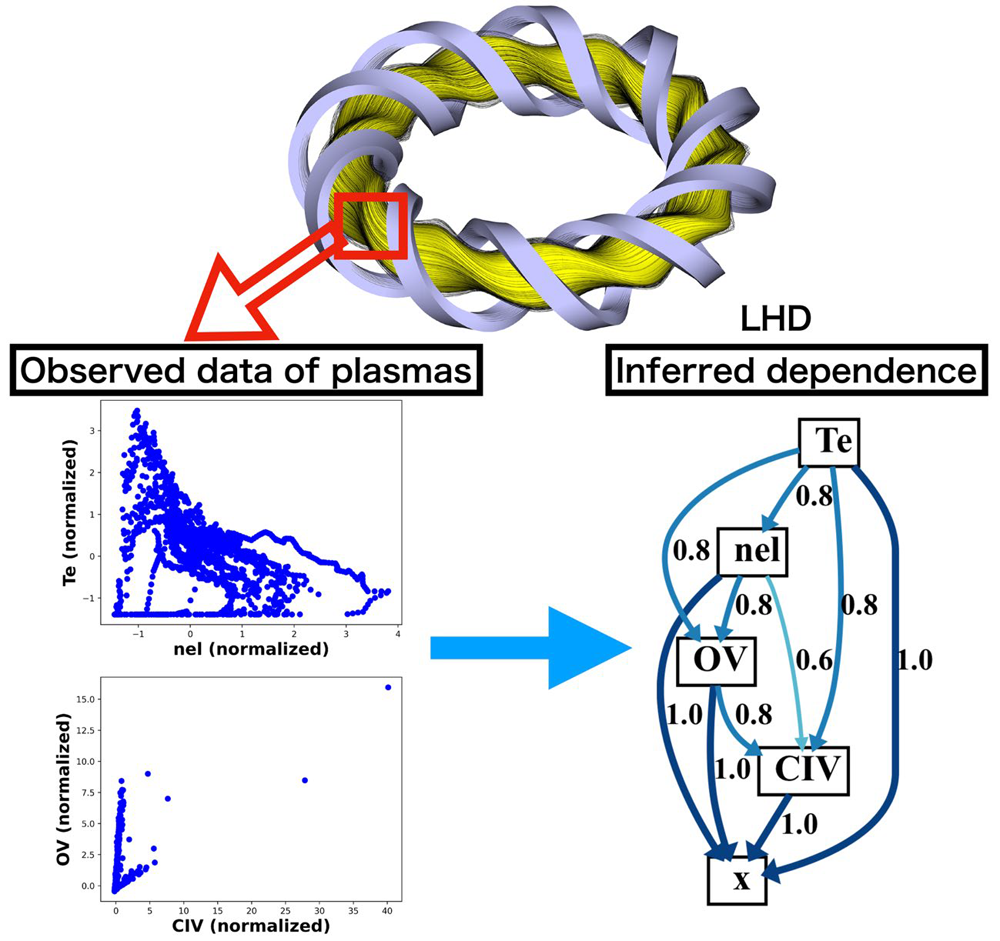
We have developed a causal discovery code called IEDS to examine plasma discharge data from the Large Helical Device (LHD). Using IEDS, we can quantitatively identify how a key physical variable in plasmas influences another. It is confirmed that our method successfully reproduces findings from earlier studies and that the causal discovery method can be applied to fusion plasma research. This method is expected to help us model fusion plasmas and deepen our understanding of the complex phenomena in plasmas.
Development of a new analytical method to investigate tritium inventory in plasma-facing materials
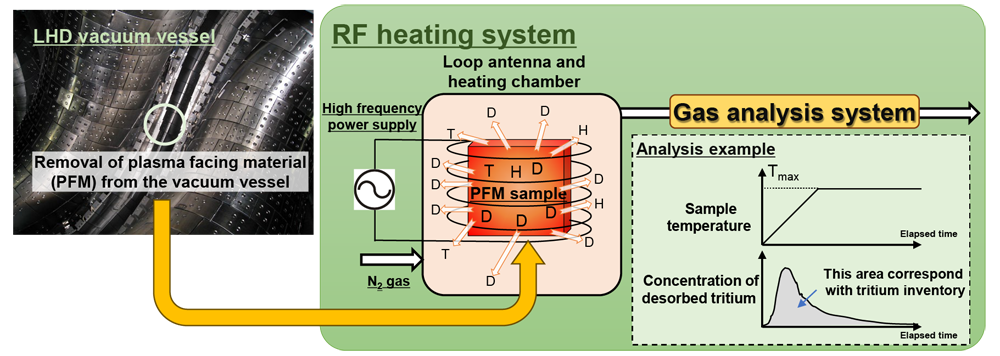
Plasma-facing material in the Large Helical Device (LHD) contains a small amount of tritium produced in deuterium experiments. To analyze it we have developed a new system using an induction heating method. With this technique, a tritium inventory, release behavior, and the chemical form of released tritium were clarified. By elucidating the tritium inventory and distribution in fusion devices, the new system will contribute to research on tritium safety and fuel balance in fusion reactors.
Identification of the condition to cease plasma heat flux by machine learning
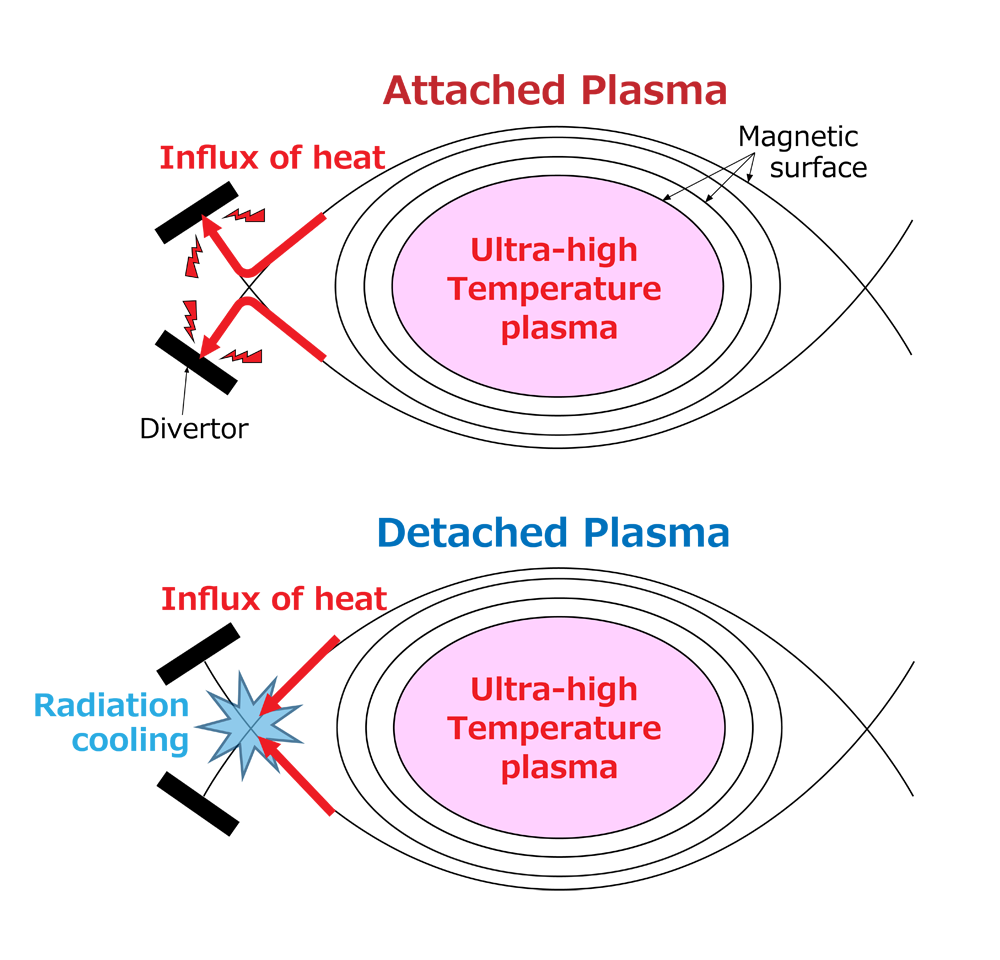
In experiments conducted with the Large Helical Device (LHD), the conditions under which the influx of heat due to plasma along the magnetic field lines ceases have been identified for the first time, using machine learning. This phenomenon is called "detachment." While detachment is an operational prerequisite for protecting fusion reactors, it involves various and complex conditions. By applying machine learning to a variety of experimental conditions, we have succeeded in identifying the necessary operational environments for this phenomenon for the first time. This achievement is the result of research conducted by a graduate student at the University of Tokyo.
Detailed Analysis of Heat Load Reduction on Divertor Plates Using Experiments and Simulations
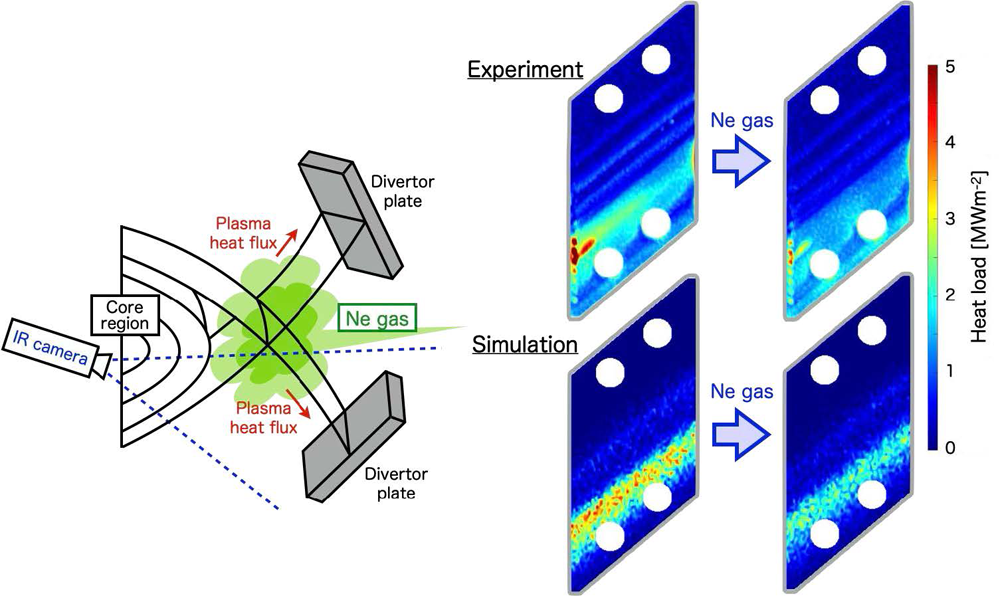
This study demonstrates how heat load control can be achieved in nuclear fusion reactors. By injecting impurities such as neon, plasma energy can be effectively dissipated, preventing excessive heat concentration in specific areas. Using a combination of experiments and simulations, we have clarified that the effectiveness of heat load mitigation depends strongly on the magnetic field structure. Findings of this study provide crucial insights for optimizing heat load control in future fusion reactors.
Generation of shear flows induced by Afven Eigenmodes and Energetic Particle driven Modes in LHD plasma
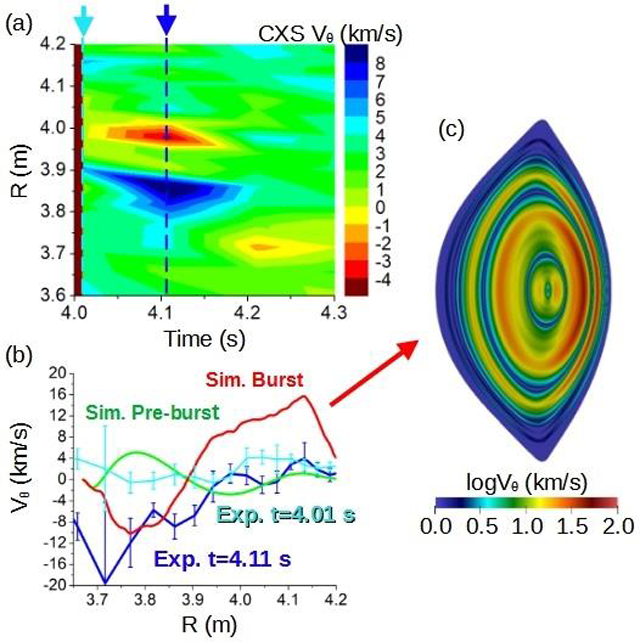
We have successfully analyzed the generation of shear flows induced by Afven Eigenmodes and Energetic Particle driven Modes in LHD plasma. This result is consistent with recent observations in other devices and is expected to be beneficial for thermal plasma confinement in future fusion reactors and may lead to improved performance.
Energetic ion charge exchange spectroscopy using high energy beam
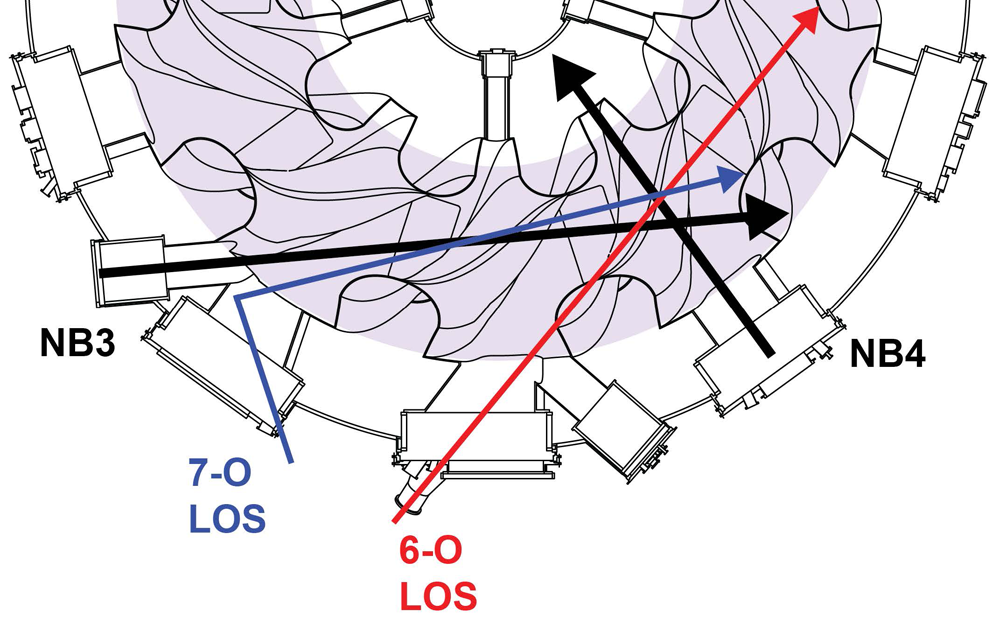
We have successfully made Fast Ion D-Alpha (FIDA) measurements using a high energy neutral beam in a deuterium plasma experiment in the Large Helical Device (LHD). FIDA measurements have been done with relatively low energy neutral beams. This result shows that the measurements can be accomplished with high energy neutral beams, which are used in conditions similar to those in fusion reactors such as ITER and JT-60SA.
Simulation analysis for boron coating on plasma facing surfaces using an impurity powder dropper
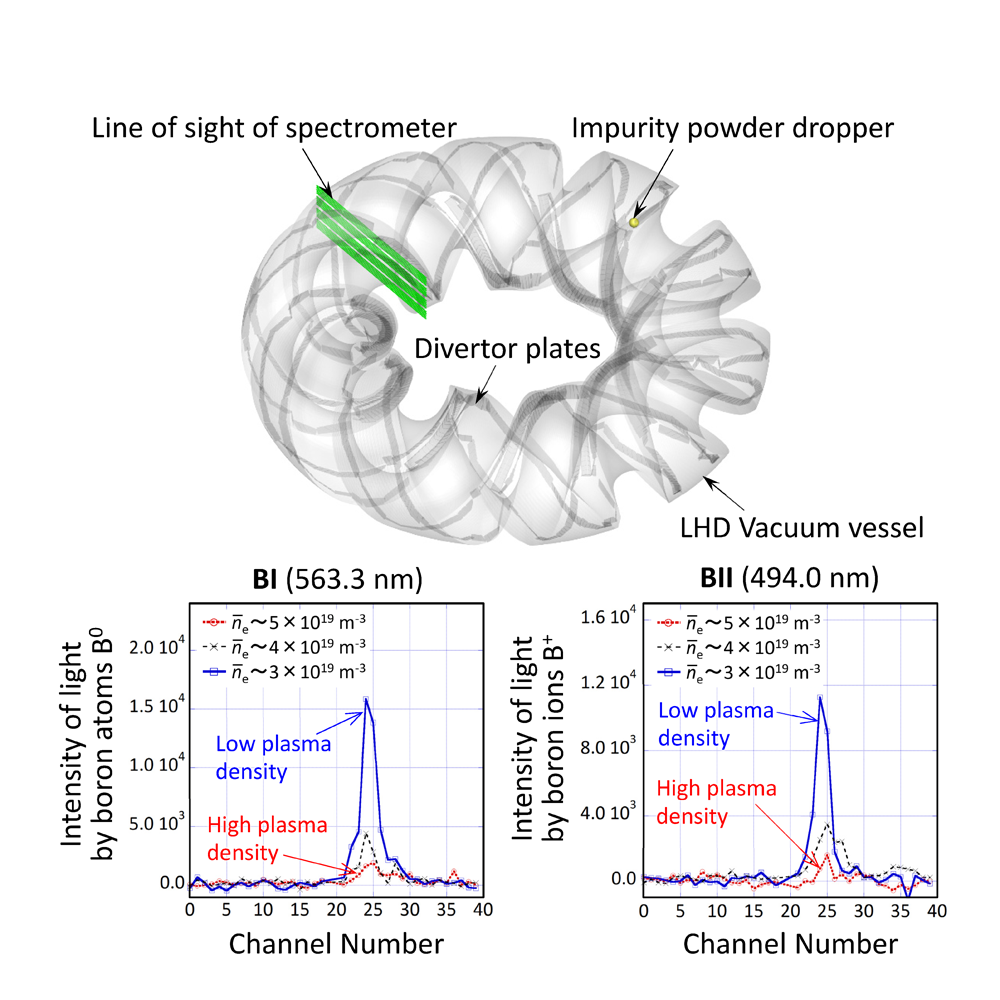
In the Large Helical Device (LHD), high-performance plasma discharges have been achieved with boron coating on plasma facing surfaces by boron powder injection into the plasma using an impurity powder dropper (IPD). The boron transport in this case was analyzed by simulation. It revealed that while the injected boron was deposited at positions far from the IPD for lower plasma densities, the boron was also locally deposited at positions near the IPD for higher plasma densities. The simulations provide a useful guideline for making effective use of the IPD.
Experimental validation of hydrogen molecular data for fusion
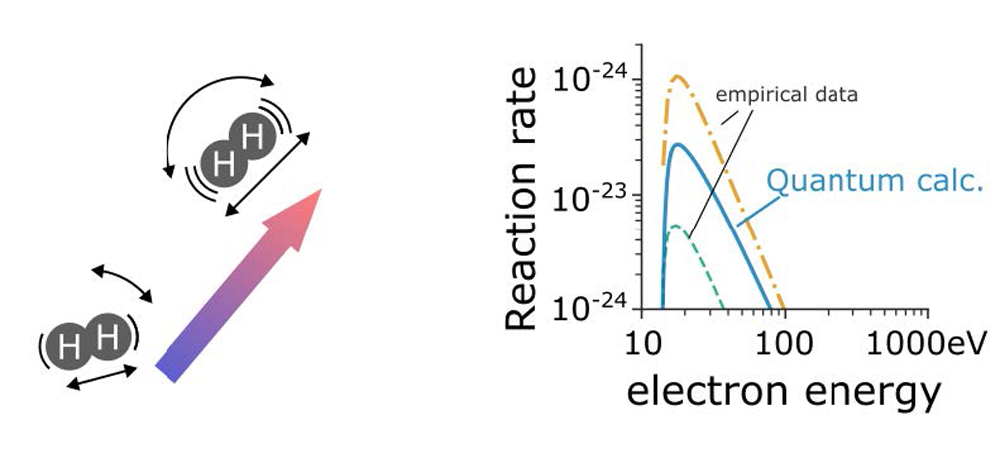
Because of complex quantum mechanical effects in molecule structure, hydrogen molecular dynamics have been difficult to observe experimentally in fusion plants. In this research, from the detailed emission spectra of hydrogen molecules observed from various experiments, including the Large Helical Device (LHD), we found that the latest theoretical calculation provides a better match to the observation than the empirical ones that are widely used. This enabled us to experimentally measure the molecule dynamics in the exhaust region of fusion plants.
The Discovery of New Turbulence Transition in Fusion Plasmas
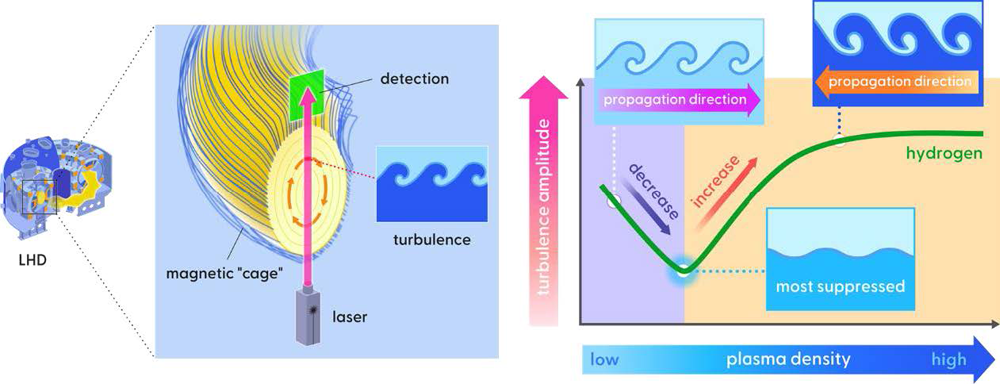
In the Large Helical Device (LHD), turbulence is suppressed at a specific condition, using precision laser diagnostics. Furthermore, a comparison experiment of hydrogen plasma and deuterium plasma, and simulations on the Raijin supercomputer reveal that turbulence suppression occurs when the turbulence mode changes. Our findings are expected to be applied to the establishment of innovative operation scenarios for fusion power plants and their design for turbulence suppression.
Accelerated Plasma Heat and Turbulence Transfer through Short-Time Heating
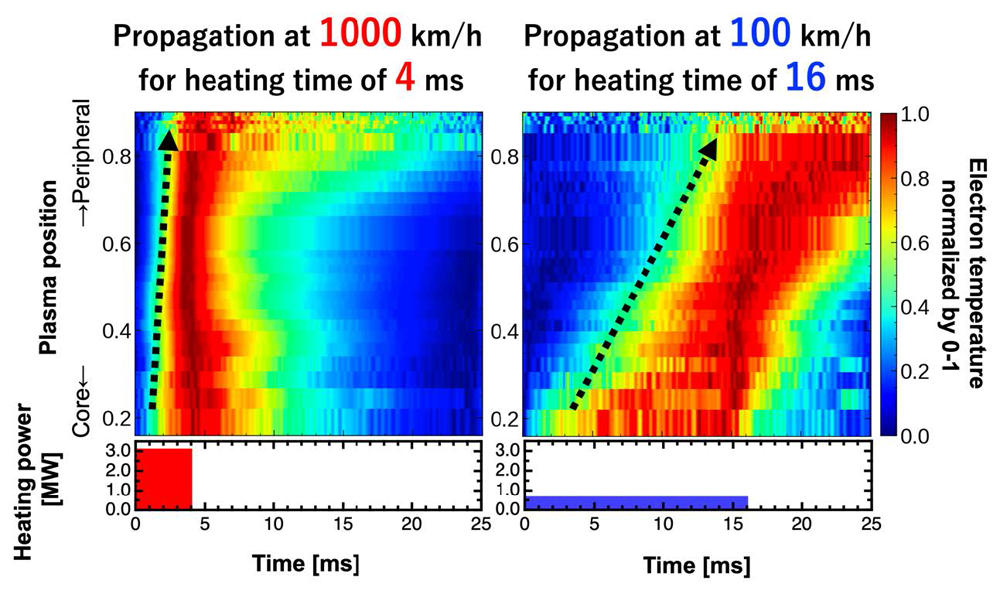
The Large Helical Device (LHD) has been used to study the propagation of heat and turbulence in plasma, and it was found that heat-transfer speed increases with shorter heating times. It was also observed that temperature changes and turbulence propagate almost simultaneously. This phenomenon is crucial for understanding how energy moves in plasma. These findings provide valuable insights for stable plasma control in future fusion reactors.
Discovery of spontaneous inflow and outflow states of high-temperature plasma by energetic ions
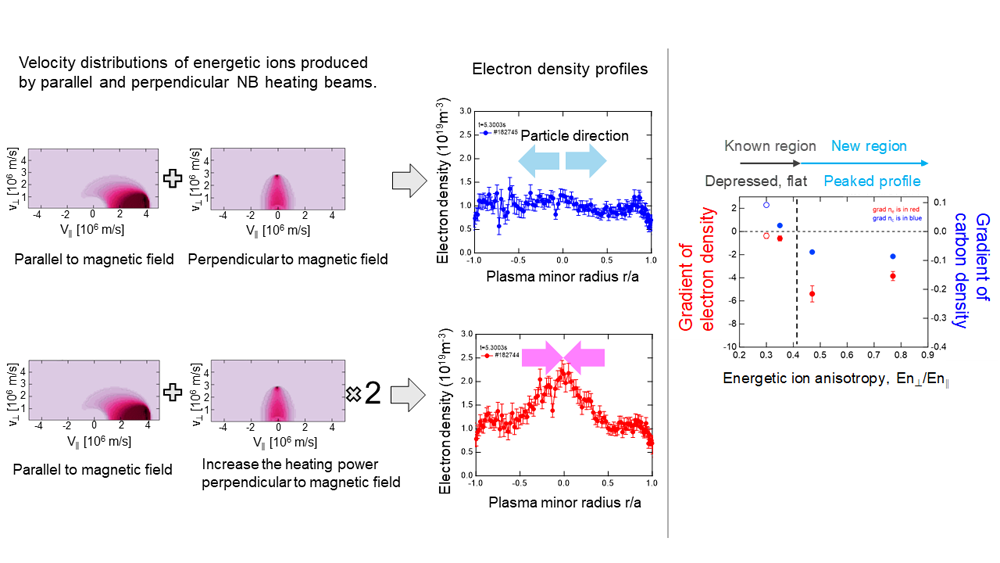
In this study, by using a neutral beam injection heating system to heat the plasma and changing the ratio of beam powers tangential and perpendicular to the magnetic field, we observed that the inflow and outflow of high-temperature plasma is spontaneously regulated by a unique state of energetic ions. This breakthrough could lead to the development of high-performance plasma, reduce the size of fusion reactors, increase the output of fusion power, and improve the control of plasma burning conditions.
Observation of anisotropy of energetic particles
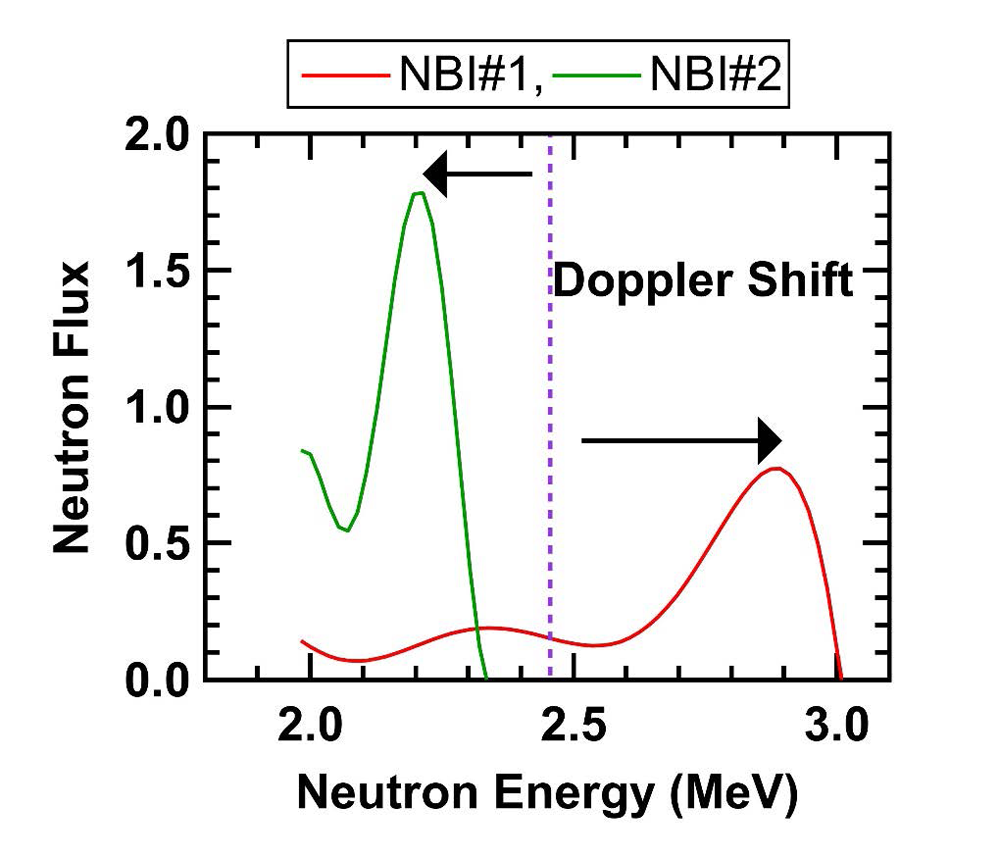
We have observed the Doppler shift of neutron energy in deuterium plasma experiments in the Large Helical Device (LHD) by using a neutron energy spectrometer. By comparing the results with an orbit following numerical simulation, we have shown that there is an anisotropy in the velocity distribution of energetic particles confined in plasma. This achievement will contribute to the deepening of research on the confinement of energetic particles.
Degradation of the energetic-ion confinement independent of MHD instabilities is observed
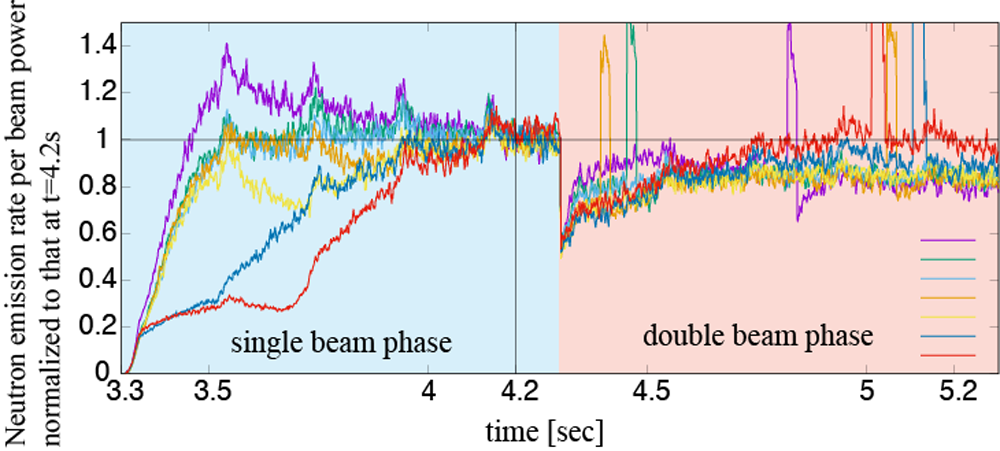
We observed that the degradation phenomenon of energetic-ion confinement was independent of MHD instabilities in an LHD deuterium experiment. The degradation depends on neutral beam power and is localized on the plasma core region. Because the cause of the degradation phenomenon is still unclear, further investigation is required.
Development of monitoring and prediction methods of plasma heat load in fusion burning plasmas
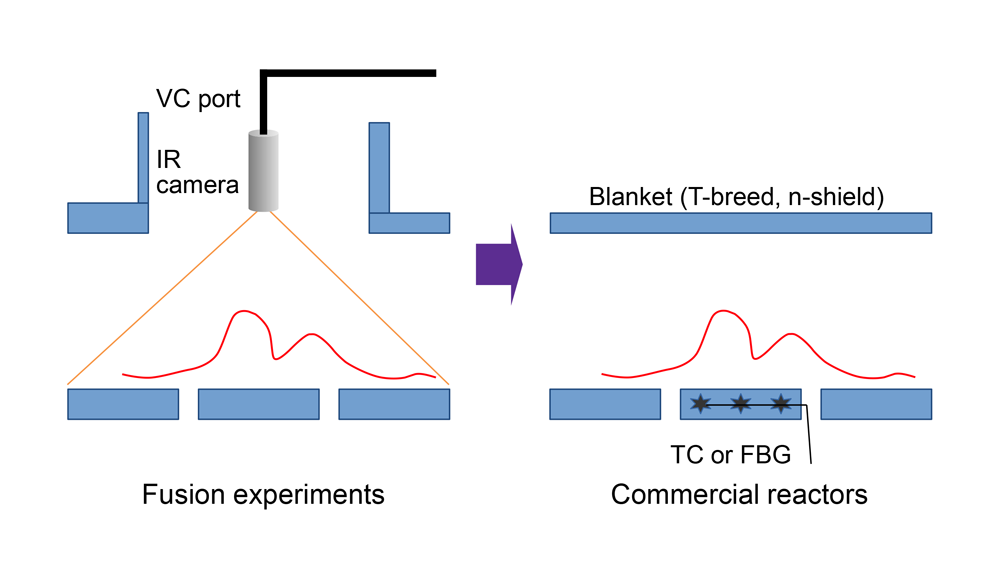
In the first wall facing the core plasma and divertor, there is a need to develop a system to detect a concentration or sudden increase in heat load. However, in commercial reactors, the installation of an infrared camera that can observe a large area of the inner wall is not allowed due to the breeding of tritium, which is the fuel of the reactor. We have extended the analytical method to back-calculate the temperature and heat load of the plasma irradiated surface from the data of thermocouples embedded in the metal target and investigated the conditions to reconstruct the spatial distribution of the heat load with the data of a small number of measurement channels.
Successful control of turbulent transport
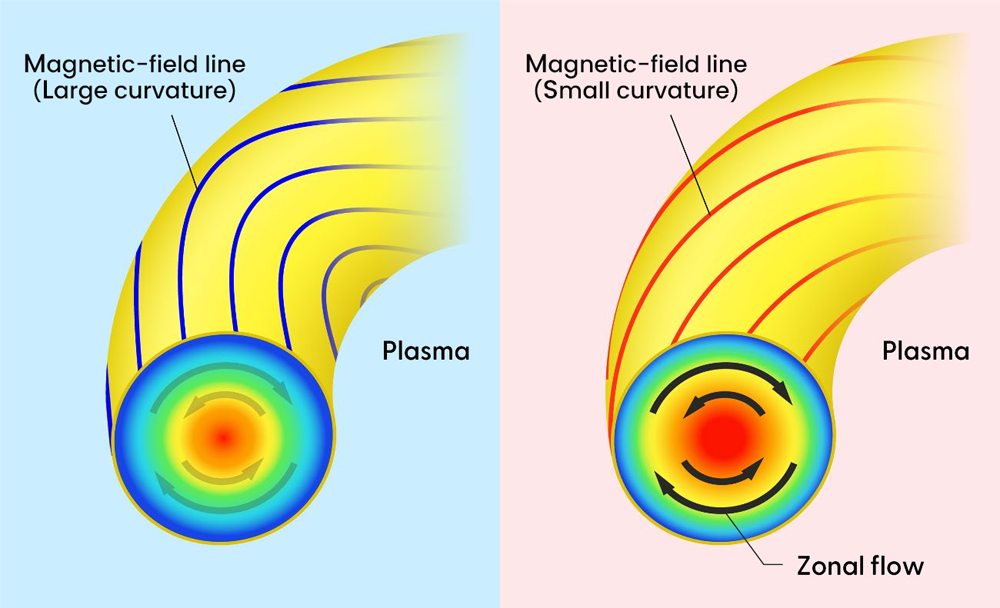
To extract fusion energy, plasma exceeding 100 million degrees Celsius is required. Research is being conducted worldwide to increase the temperature of plasma confined by magnetic fields. However, it has been discovered that fluctuations in plasma density and temperature cause a phenomenon that releases heat from the plasma, leading to a decrease in its temperature. By carefully designing the shape of the magnetic field that confines the plasma, researchers have successfully suppressed the heat release phenomenon caused by these fluctuations.
A new self-consistent analytical method to calculate the behavior of boron dust particles in plasma!
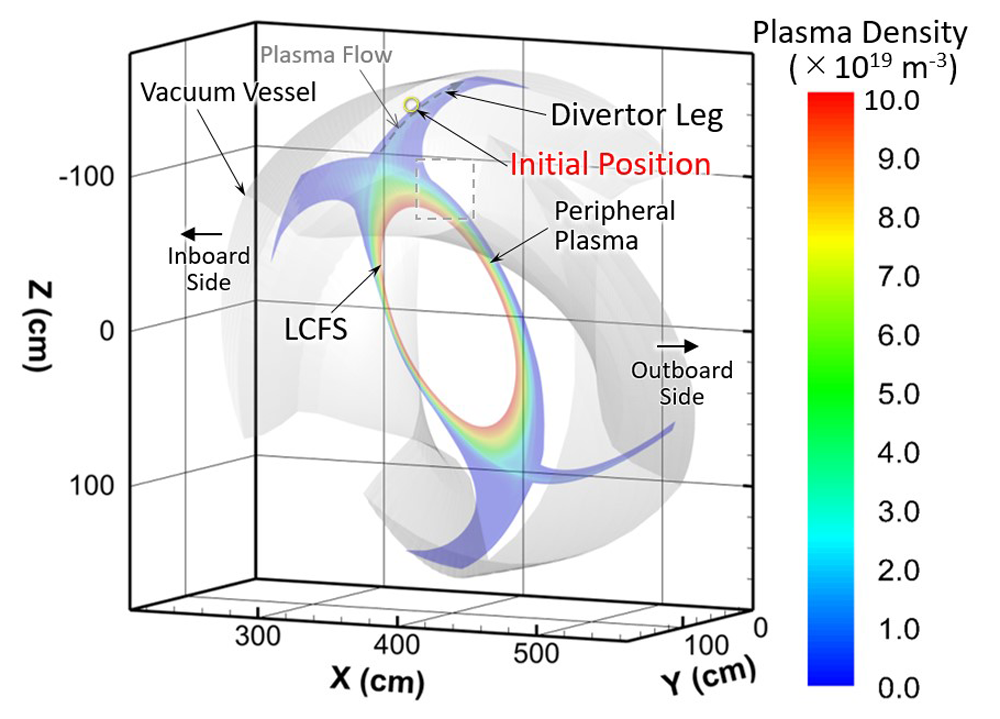
A new self-consistent analytical method has been developed for calculating the trajectory of solid boron dust particles in plasma. Boron dust particles produce boron ions which flow out of the plasma through diverter legs. Although it was expected that the trajectory of the dust particles would be deflected to the outboard side of the torus by the boron ion flow effect, a detailed analysis using the method revealed that the trajectory was deflected to the inboard side.
Ultra-high neutral pressure achieved in the divertor
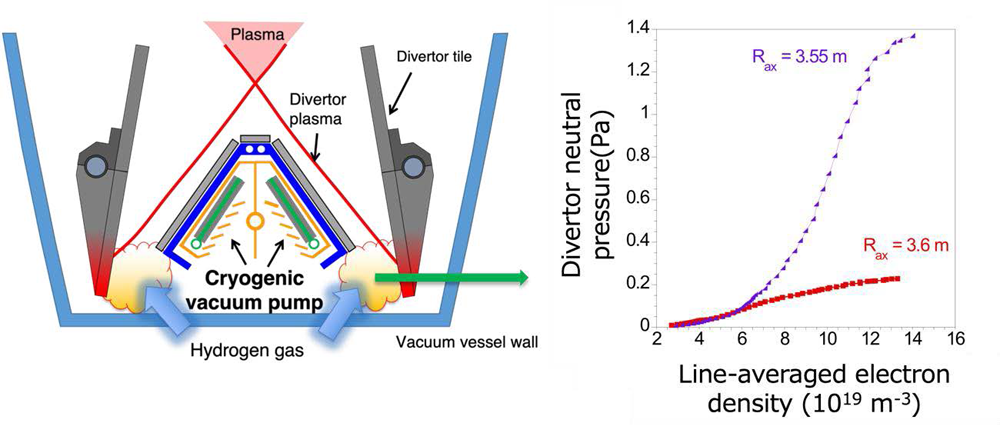
For the first time, a very high neutral pressure in a divertor region has been observed in a high-density experiment in the Large Helical Device (LHD). Curiously, this phenomenon has only been observed in a specific magnetic field configuration. Divertors play a role in removing impurities and improving particle control by increasing the amount of neutral particles inside and efficiently exhausting them. The present results mean that an optimization of the magnetic field configuration enables an increase of neutral particle pressure in the divertor region, providing important insights into the design of fusion DEMO reactors.
Successfully reproduced behavior of solid impurity dust particles in plasmas by numerical simulation
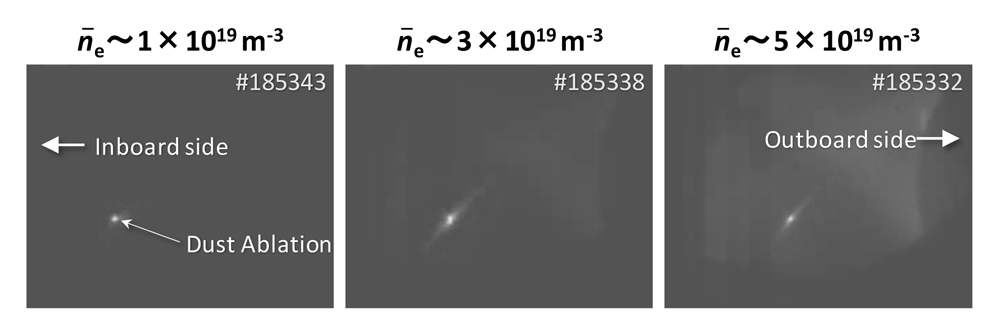
The melting and ablation processes of solid (dust) particles, including impurities, were observed when the dust particles were dropped into plasma in the Large Helical Device (LHD). Accurate prediction of the ablation position is an important issue because the ablation of the dust particles produces an impurity source in the plasma. The ablation positions were calculated using both dust particle transport and edge plasma simulation codes, which successfully reproduced the observations.
First demonstration of predictive control of fusion plasma by digital twin ―Application of data assimilation to adaptive predictive control―
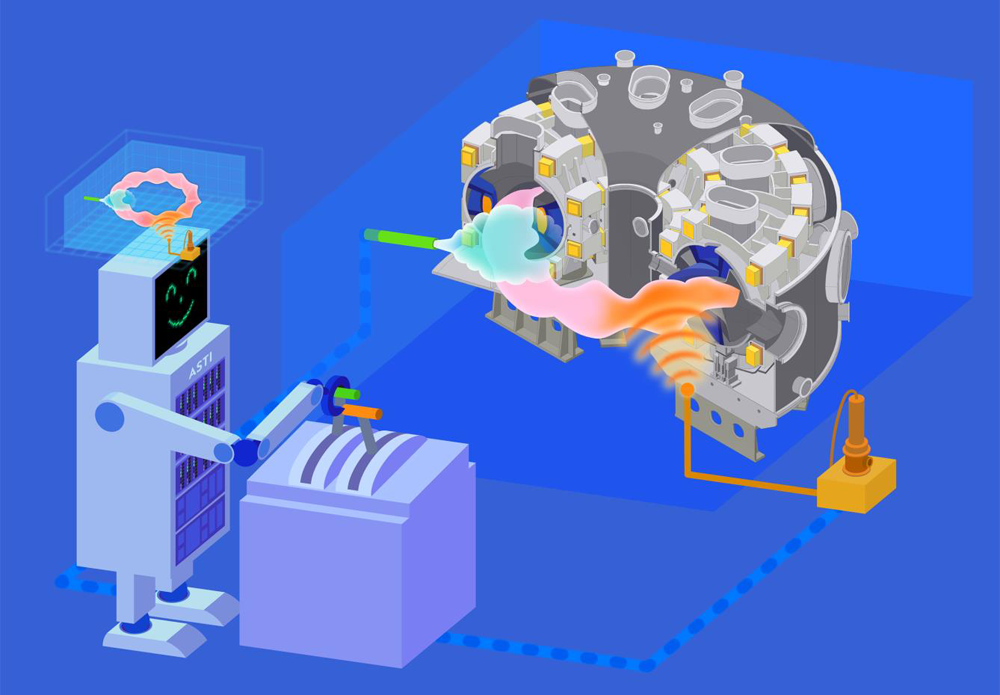
We have developed a new predictive control system for the Large Helical Device (LHD) that uses a mathematical technique called data assimilation, and have demonstrated its control capability for the first time in the world. This system optimizes a predictive model based on real-time observations and can make the plasma behavior predicted by the model closer to that of the real plasma. In addition, the system can estimate the optimal control input for the target plasma state based on the predictions by the improved model. Because the predictive model can be optimized in real time to achieve high predictive performance, the system can be applied to challenging control problems, including plasma profile control and control of quantities that are not measured directly, such as the ease of heat escape from inside the plasma. This control approach based on the data assimilation is expected to become a fundamental technology for fusion reactor control.
Design of an optimized load-resilient Conjugate T for the ICRH system in the LHD to maintain low reflection coefficients over a wide range of parameters
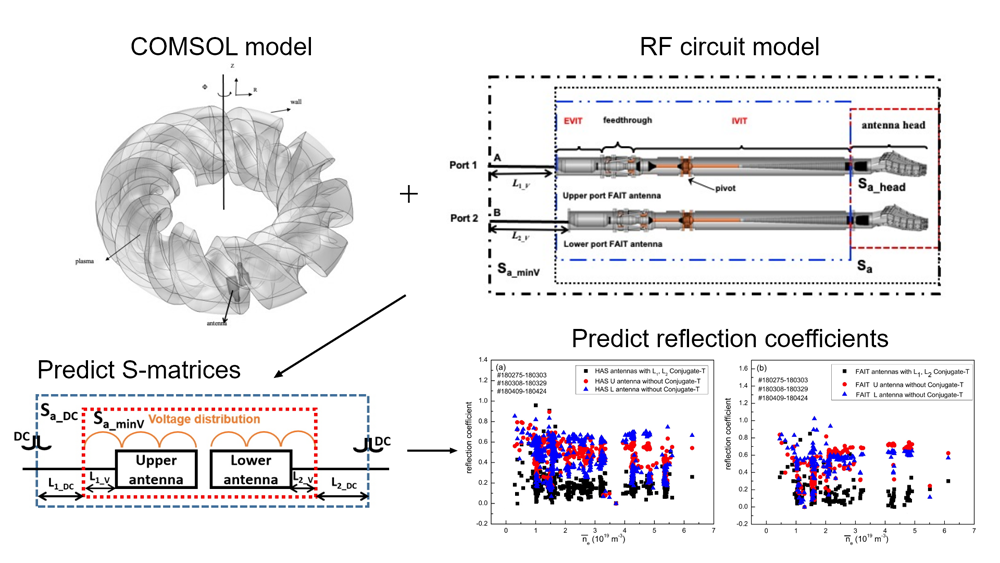
The S-matrices of upper and lower ICRH antennas are measured with real plasma for the LHD. Then the measured S-matrices are compared with a hybrid circuit/3DLHDAP simulation, and the theoretical results are in agreement with the experimental ones. Finally, a conjugate-T circuit for antennas is optimized according to the measured S-matrices by hybrid circuit/3DLHDAP, which can obtain low reflection (less than 0.4) without controlling impedance matching devices for FAIT and HAS antennas in a wide plasma parameter range.
ICRF plasma production at hydrogen minority regime in LHD
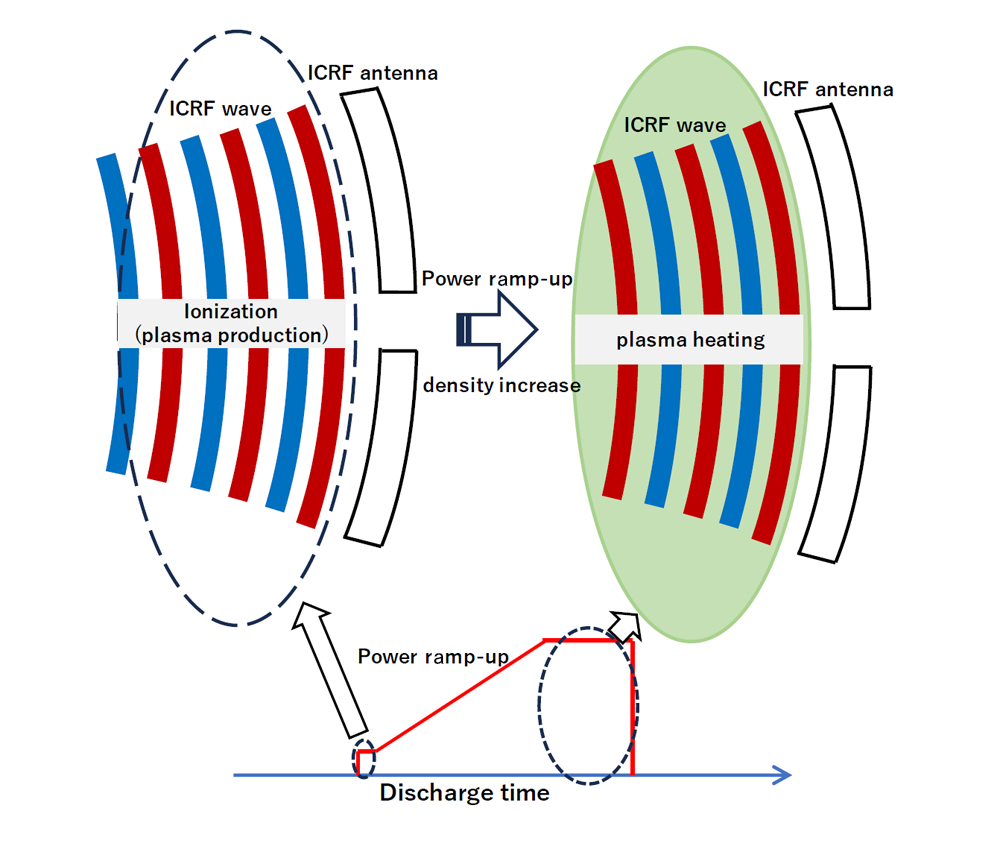
This study aim is to develop further an ion-cyclotron range of frequencies (ICRF) method for plasma production and connection to the additional heating in stellarators. Higher ICRF power experiments became possible after introducing an ICRF power ramp-up at the front of an ICRF pulse. The plasma density achieved was 6 × 1018 m-3 which was six times higher than in previous experiments, with the power up to 0.2 MW. This method could open a way for the usage of ICRF heating for plasma production and heating for a plasma density ramp-up to more than 1019 m-3 during the same shot.
Suppression of Plasma Instability by Applying Specific Magnetic Field
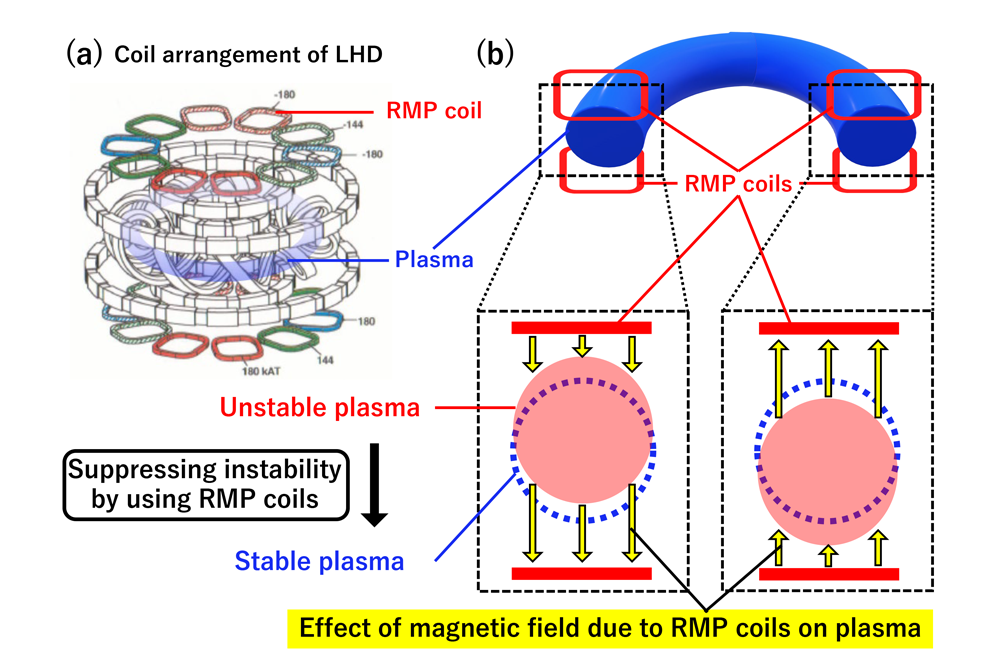
In an experiment at the Large Helical Device (LHD), it was found that the resistive interchange instability, which is a typical MHD instability in the LHD, can be suppressed by applying a magnetic field having a specific spatial structure (resonant magnetic perturbation: RMP). Moreover, the suppression of the instability leads to improvement of plasma confinement performance degraded by the instability. This achievement will contribute to development of a method to produce and maintain high-pressure plasma.
New type of divertor heat removal component demonstrated high reliability in large-sized plasma confinement device (LHD)
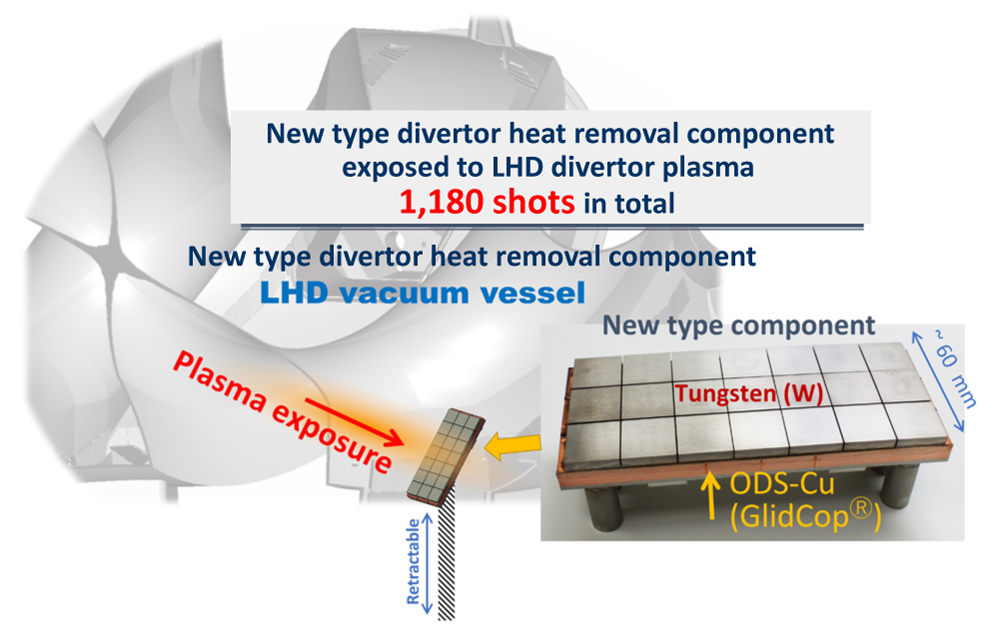
A new type of divertor heat-removal component with tungsten (W) armor and an oxide-dispersion-strengthened copper (GlidCop®) heat sink (W/GlidCop®) has been developed by new fabrication technology, Advanced Multi-Step Brazing, (AMSB). Then the new component was installed in the divertor strike position of the Large Helical Device (LHD) and exposed to neutral beam injection–heated plasma discharges with 1180 shots (~8000 s) in total. Though submillimeter-scale damage, such as unipolar arc trails and microscale cracks, was identified on the W surface, the extremely high heat removal capability did not show any sign of degradation over the experimental period.
Reveals hidden relationship between core and wall-front plasma distributions
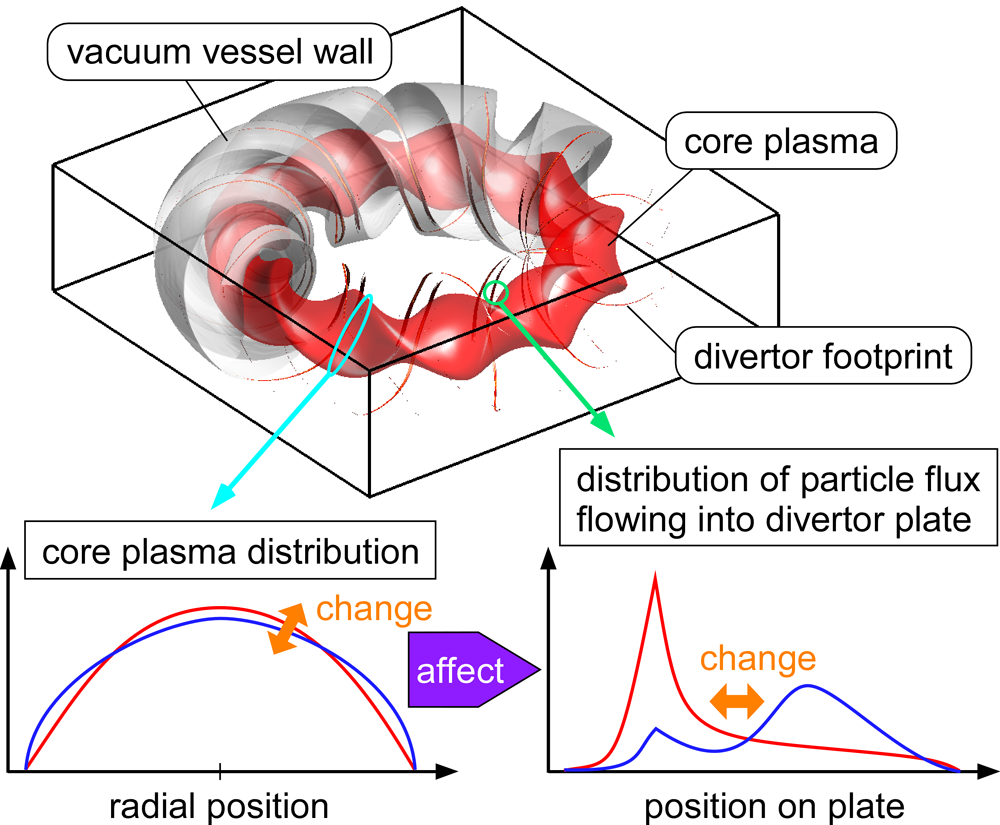
By applying a multivariable analysis method to a large data set acquired in the Large Helical Device (LHD), we have shown that there is a significant relationship between core plasma distribution and plasma distribution in front of the wall. This result will contribute to improving the accuracy of heat load prediction in future fusion devices.
Demonstration of fusion reactions using advanced fusion fuels─ A first step toward a clean fusion reactor using a hydrogen-boron reaction that does not produce neutrons ─
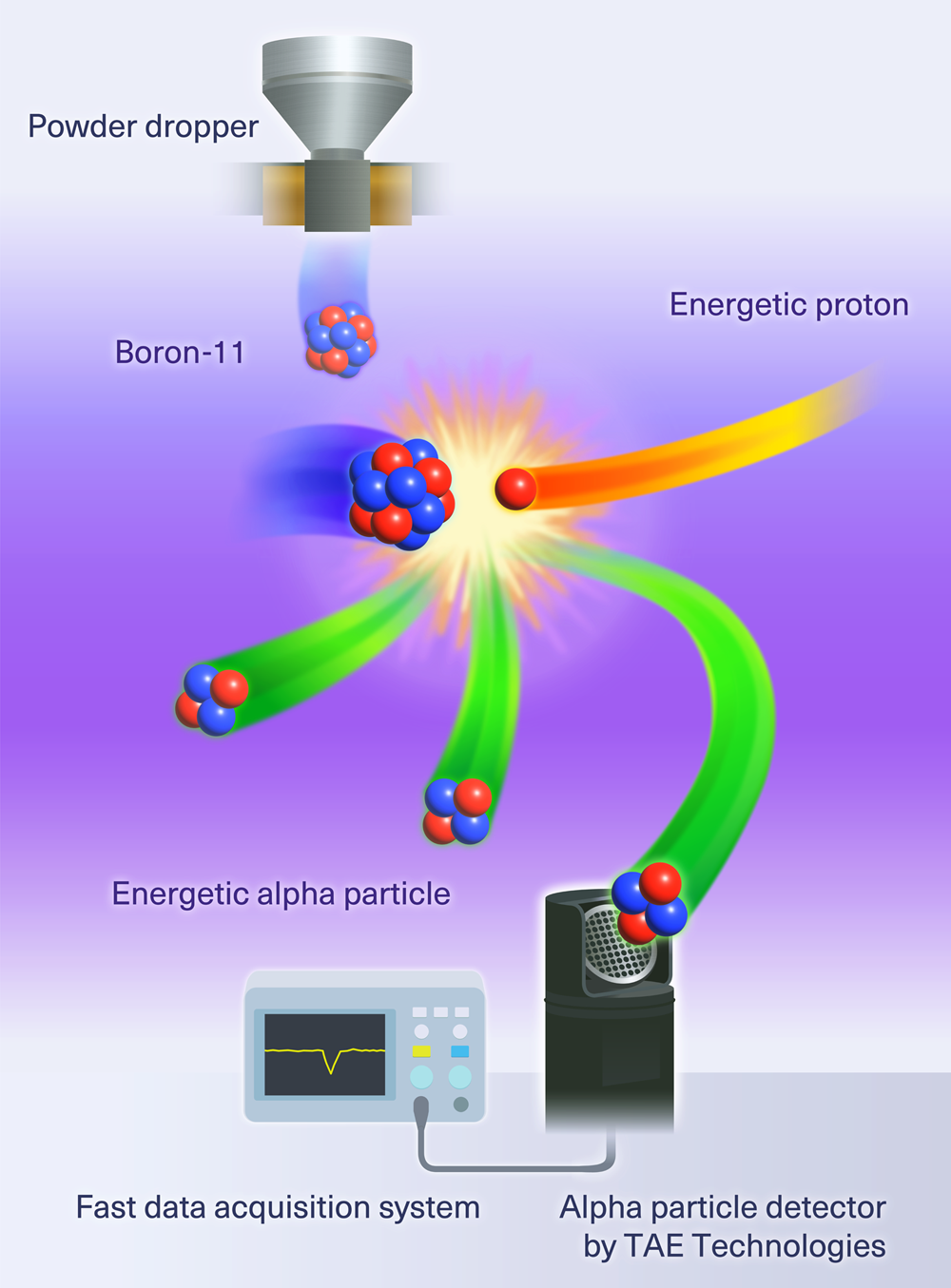
The National Institute for Fusion Science and TAE Technologies research group demonstrated the world's first fusion reaction between hydrogen and boron-11 in a magnetic confinement fusion plasma, using devices in the Large Helical Device. The proton and boron-11 reaction to produce alpha particles does not produce neutrons. Hydrogen and boron-11 are regarded as advanced fusion fuels because they enable the concept of cleaner fusion reactors. The results of this work are a major first step towards the realization of fusion reactors using advanced fusion fuels.
Detailed observation of ice melting and assimilating in high-temperature plasma - discovery of effective plasma cooling scheme
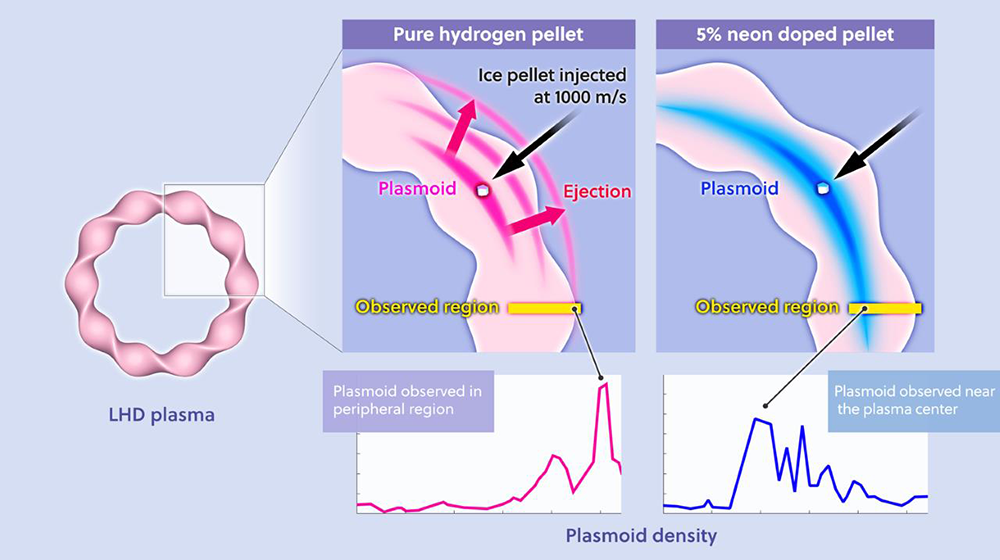
The Large Helical Device demonstrated effective plasma cooling at a deeper depth using hydrogen-neon mixture ice pellet injection. In ITER, requires a forced cooling system to avoid or mitigate damage to the device owing to unintended plasma instabilities. In our experiment, by observing the melting and assimilation of mixed ice pellets of hydrogen and neon in high-temperature plasma, an important physical mechanism that affects the performance of the forced cooling system in ITER was discovered.
Observation of boron deposition processes via molecular spectroscopy
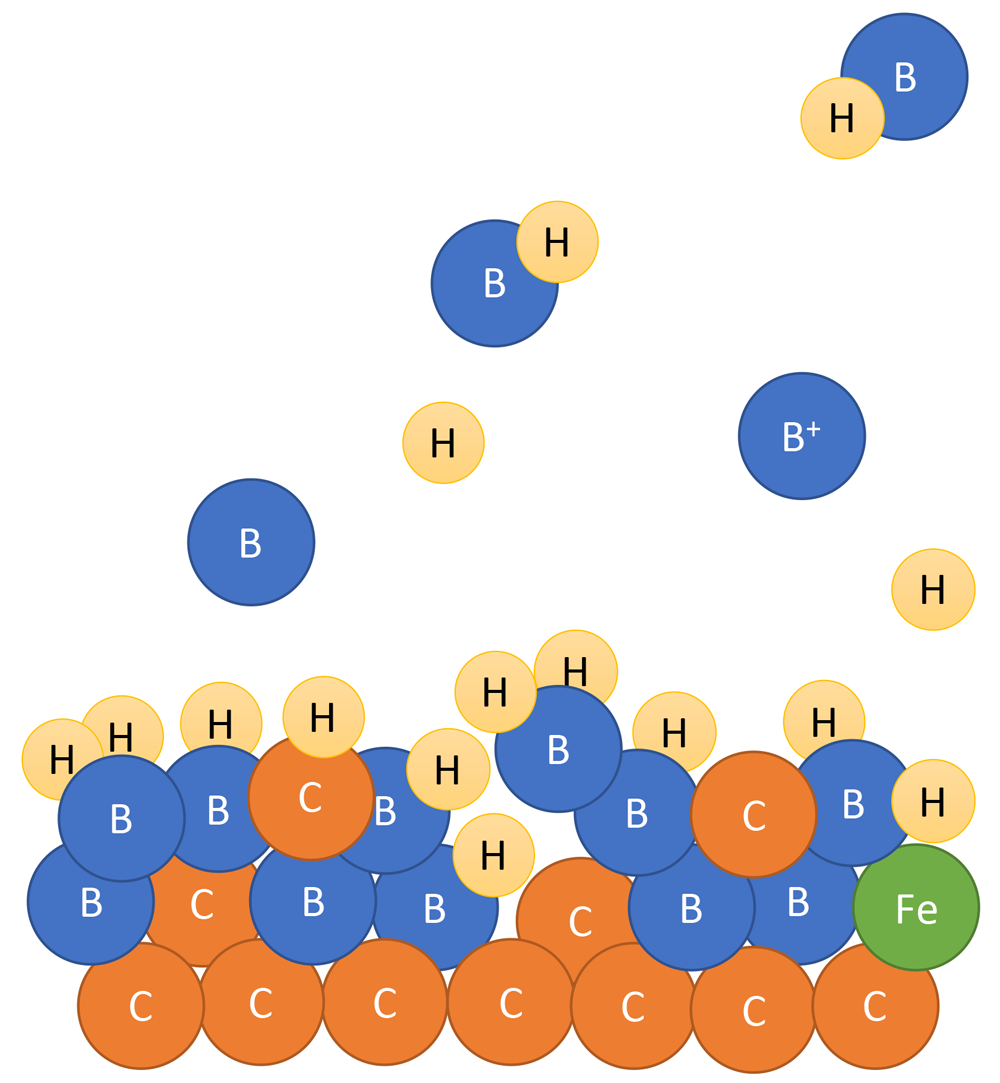
During a boron powder injection experiment in the Large Helical Device (LHD), we observed for the first time where and how boron is deposited on the plasma-facing walls. This achievement advances our understanding of how to control the amount of impurity in the plasma and the amount of neutral hydrogen in the peripheral region, which affects the efficiency of fusion power generation.
Simultaneous observation of the spatial distribution of energetic-particle-driven magnetohydrodynamic instabilities and transport of energetic particles
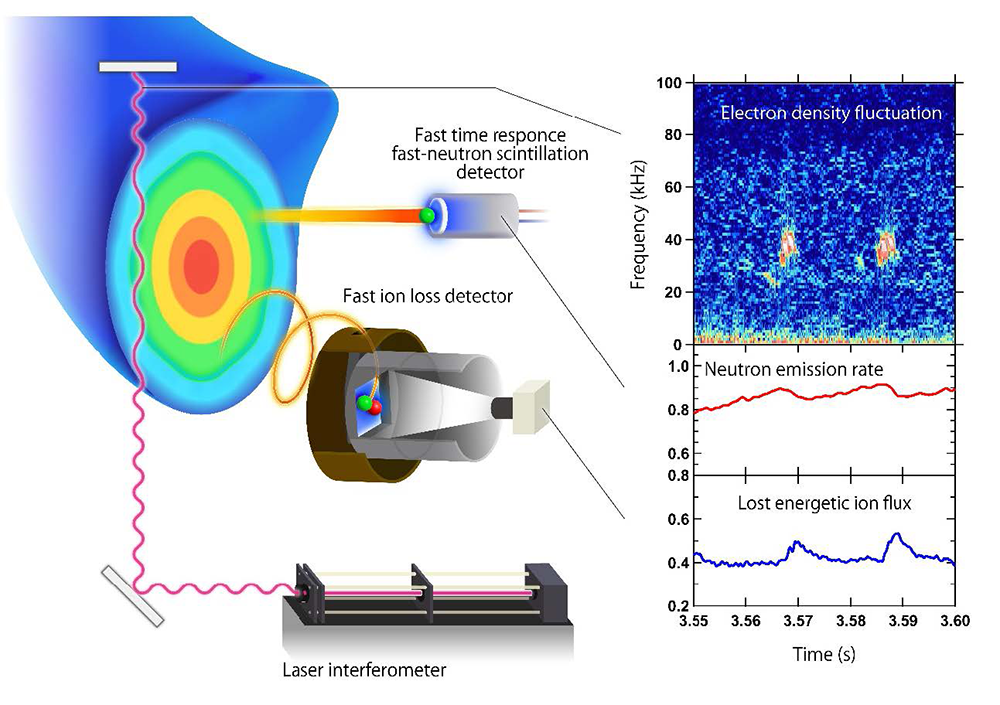
The spatial distribution of energetic-particle-driven magnetohydrodynamic instabilities and the energetic particle transport through the particle-wave interactions were simultaneously observed by using a laser interferometer, a high-time response fast neutron scintillation detector, and a fast ion loss detector in the deuterium plasma experiment of the Large Helical Device. These results provide important insights into the understanding of alpha particle confinement in fusion reactors.
The process of waves carrying plasma heat is observed for the first time in the world
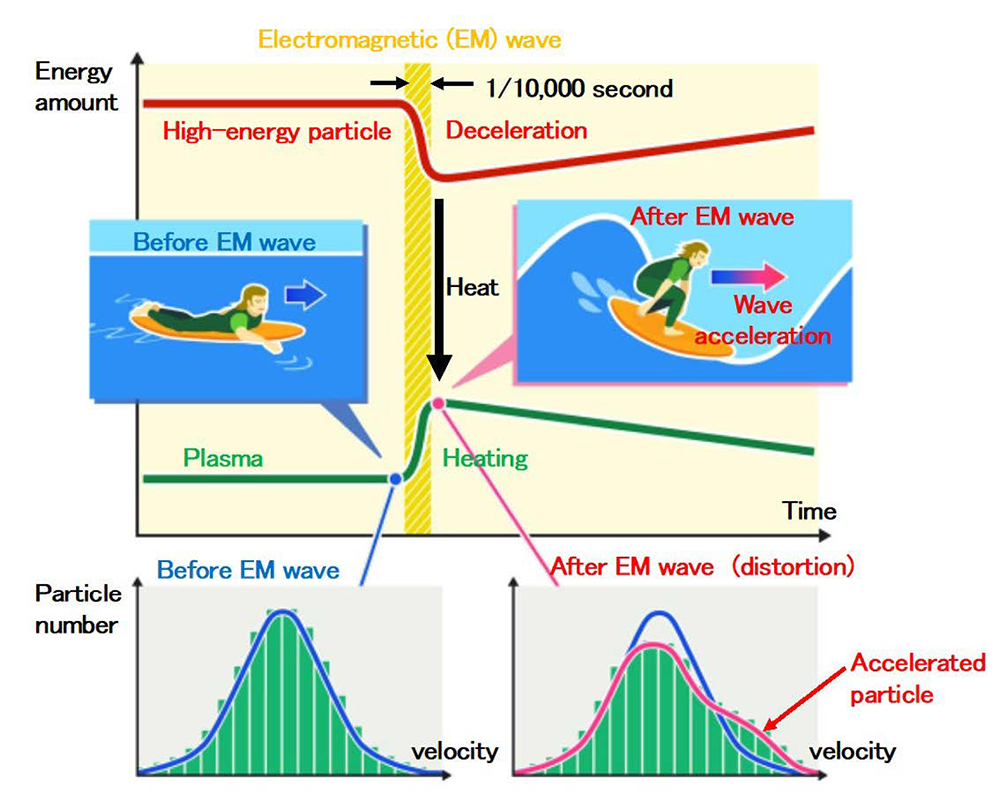
In fusion power generation, it is essential that the high-energy particles generated by a fusion reaction in hot plasma heat it to sustain further fusion reactions. The key to this self-heating of the plasma is whether it can be heated by waves created by the high-energy particles. The time variation of the plasma velocity profile was measured in the Large Helical Device (LHD). It was found that electromagnetic waves produced by high-energy particles carry heat through a process called Landau damping. This is the first observation in the world of this process and a Significant progress in research on self-heating of fusion plasma.
Identification of onset conditions of fluctuations leading to plasma collapse
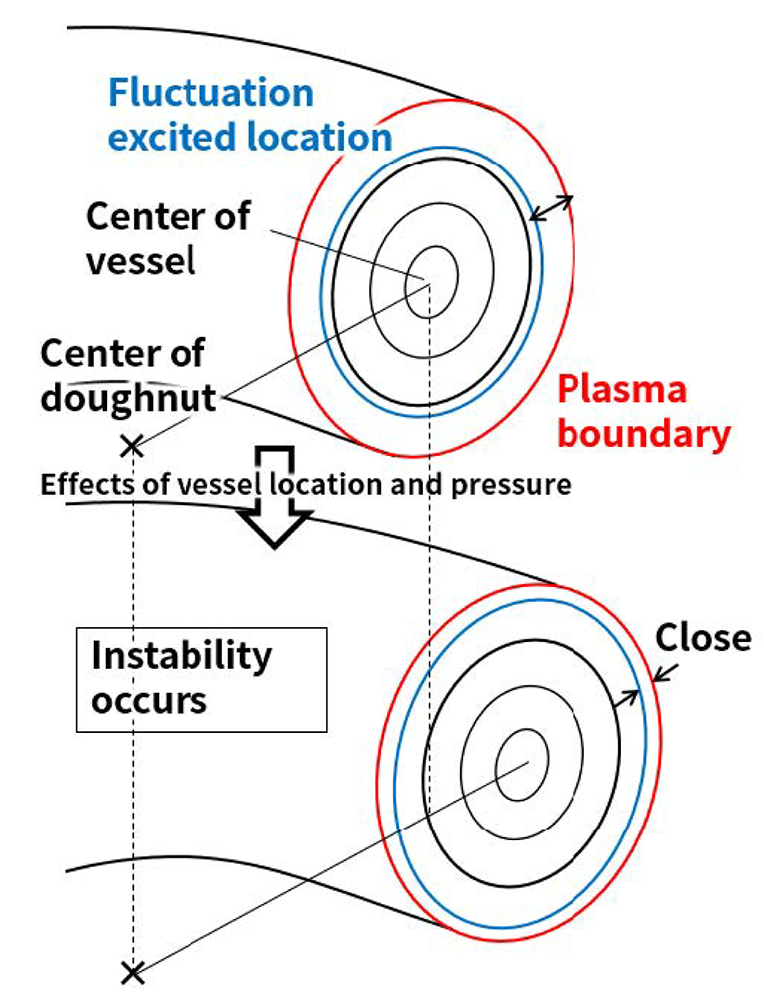
In relatively high-density plasmas of the Large Helical Device, plasma fluctuations grow rapidly, resulting in significant degradation of the confinement property. It has been clarified that such instabilities can grow rapidly when the fluctuations occur close to the plasma boundary. This result will greatly advance research to clarify the onset mechanism of the instability that prevents the realization of fusion reactions.
Observation of energy transfer due to nuclear elastic scattering
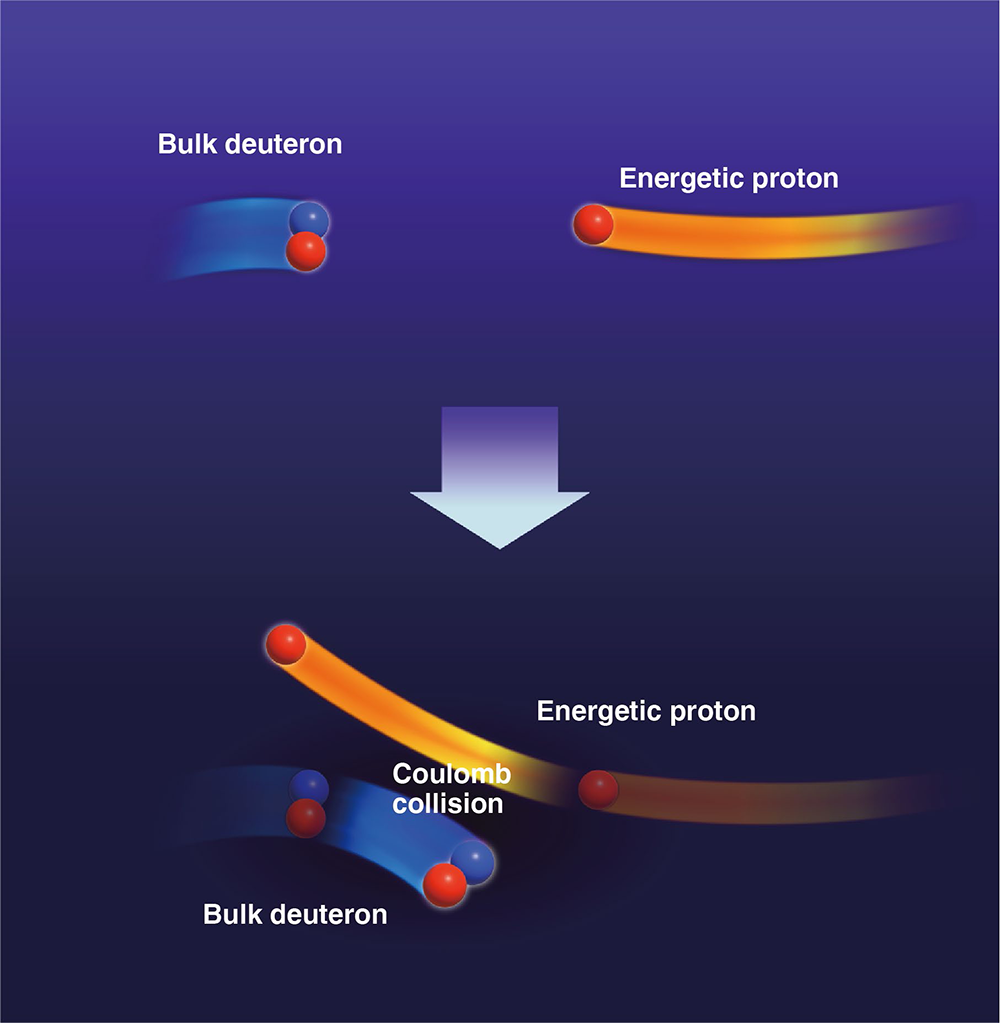
We observed energy transfer from beam protons to beam deuterons due to the nuclear force by analyzing the neutron emission rate and decay time in LHD deuterium plasmas injected with hydrogen and deuterium beams and comparing them with numerical simulations developed at Kyushu University. We provide important knowledge that will lead to improved power generation efficiency in fusion reactors.
Development of high-time-resolution measurement of electron temperature and density in a magnetically confined plasma ─A powerful tool for understanding transient plasma physics phenomena─
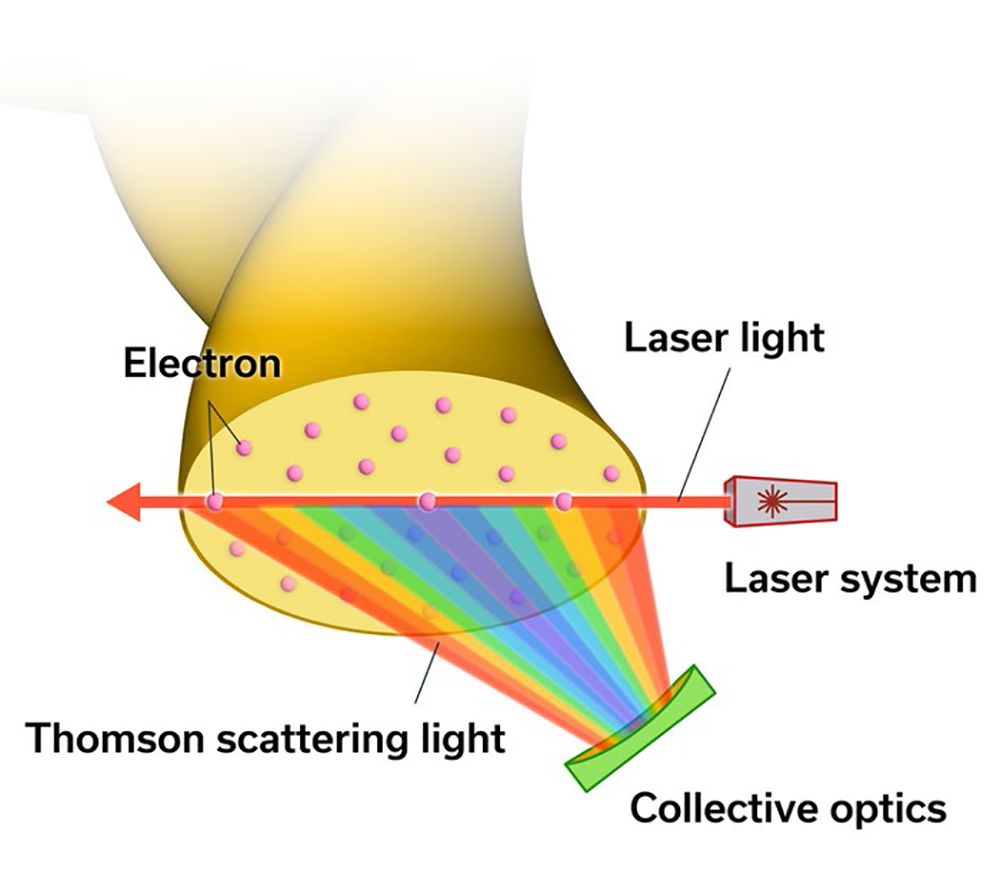
In fusion power generation, it is essential that the high-energy particles generated by a fusion reaction in hot plasma heat it to sustain further fusion reactions. The key to this self-heating of the plasma is whether it can be heated by waves created by the high-energy particles. The time variation of the plasma velocity profile was measured in the Large Helical Device (LHD). It was found that electromagnetic waves produced by high-energy particles carry heat through a process called Landau damping. This is the first observation in the world of this process and a Significant progress in research on self-heating of fusion plasma.
First Observation of Ion Cyclotron Emission from fusion-born protons in a heliotron-stellarator plasma
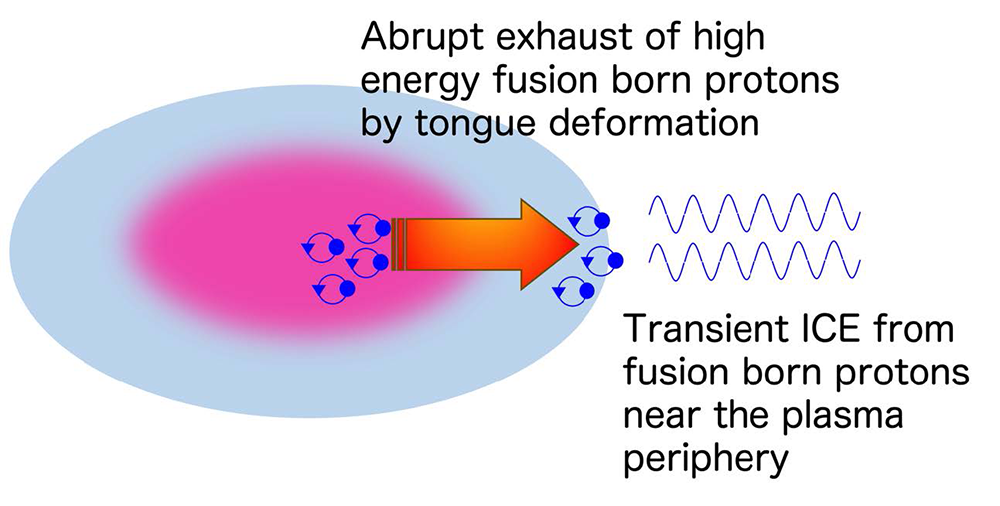
In deuterium beam heated plasma at the LHD, ion cyclotron emission (ICE) from fusion-born protons has been observed for the first time in a heliotron-stellarator. The frequencies of successive ICE spectral peaks shifted from a proton cyclotron harmonic frequency in the likely emitting region. First principles computations of the collective relaxation of this proton population were carried out using a particle-in-cell approach. We found substantial frequency shifts in the peaks of the simulated ICE spectra, which corresponded closely to the measurement.
World's first observation of high-speed moving plasma turbulence
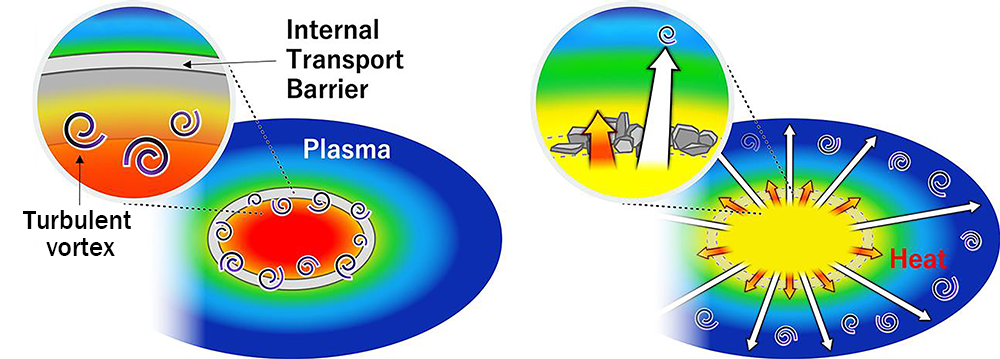
In the Large Helical Device (LHD), turbulence that moves faster than heat as the heat escapes in plasma was observed for the first time in the world, providing new insight into the understanding of turbulence in fusion plasmas. This characteristic of turbulence makes it possible to predict plasma temperature changes, and it is expected that observation of turbulence will lead to the development of a method to control plasma temperature in real-time.
Non-contact thermometer to measure temperature of ultra-high temperature plasma ─ Successful observation of multi-temperature anisotropic energetic ions ─
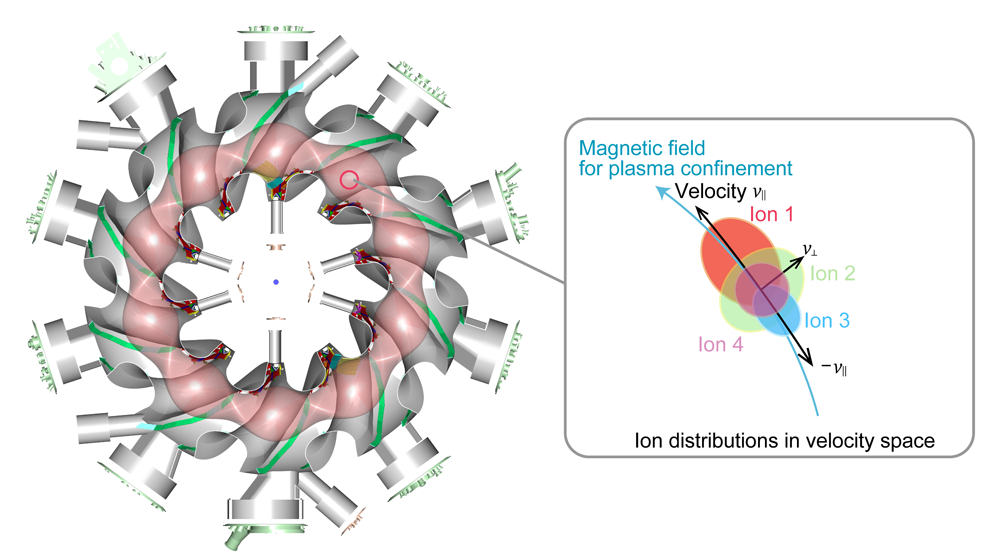
Fusion plasma can maintain burning without external energy injection when the temperature at the center of the plasma exceeds 100 million degrees Celsius. Temperature measurement is also necessary to sustain such an ultra-high temperature plasma state. We have developed a new non-destructive high-precision calibration method for non-contact thermometers. Plasma experiments in the Large Helical Device (LHD) have revealed that plasmas heated to ultra-high temperatures have a complex mixture of energetic ions with a velocity spread in the direction of the confinement magnetic field and perpendicular to it. In addition to leading to the analysis of fusion reactor burning and control, these results are expected to be widely used for the calibration and analysis of plasma-heating devices and diagnostics using electromagnetic waves in fusion power plants.
Improvement of Plasma Thermal Insulation Layer with Deuterium─High-speed beam of gold ions reveals plasma flow effects─
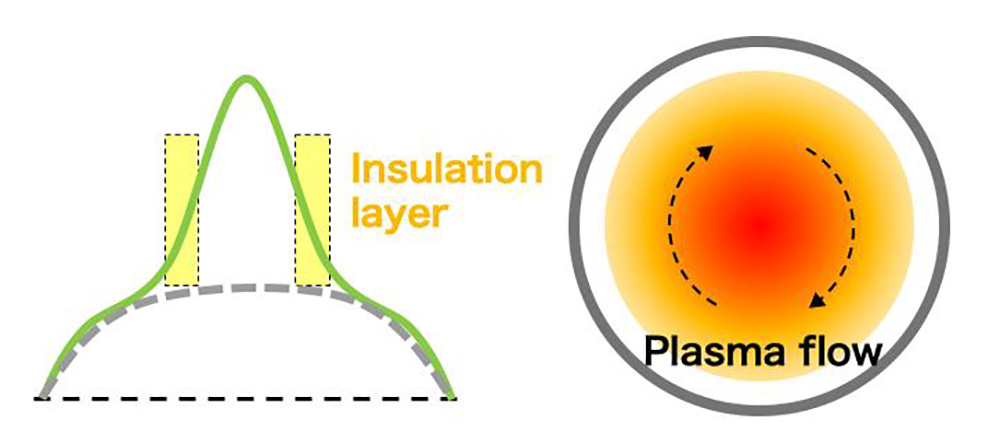
In Large Helical Device (LHD) experiments, it was clarified that the plasma thermal insulation layer was reinforced in plasmas produced by heavier fuel gas. In order to explore the background physics, plasma flow was measured by the so-called heavy ion beam probe (HIBP). It was found that the improvement of the plasma thermal insulation layer in deuterium plasmas clearly correlated with a strong flow structure formation.
Successful plasma collapse avoidance experiment using machine learning
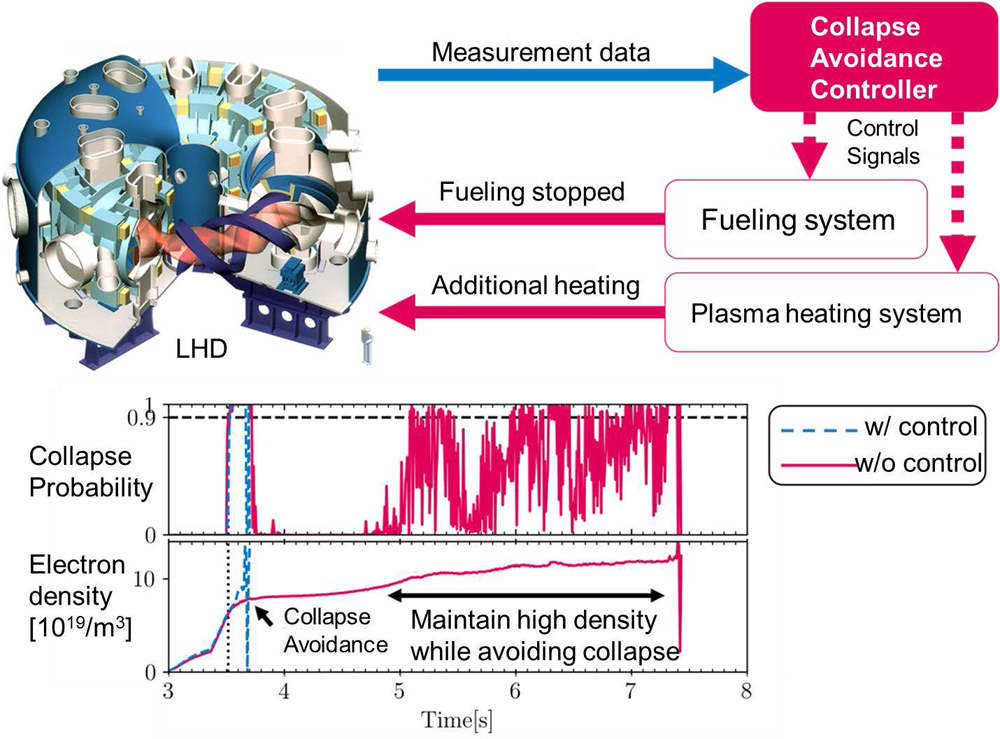
A control system to avoid plasma collapse phenomena in the Large Helical Device (LHD) has been developed using machine learning. Using this system, we have succeeded in avoiding radiative collapse in LHD experiments and maintaining a high-density plasma.
Cooling a plasma of 100 million degree by ice pellet─Emergency plasma shutdown system in ITER
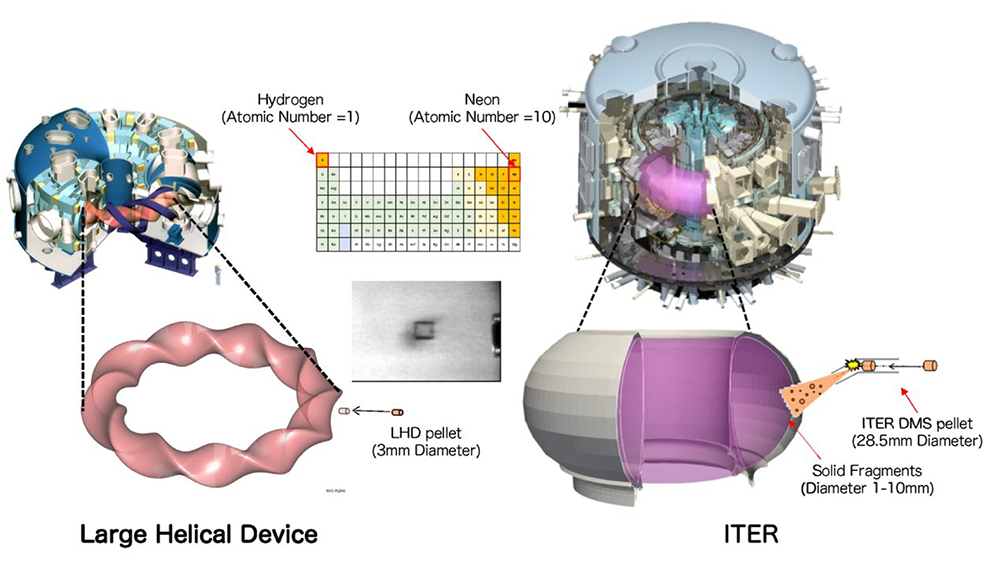
Large Helical Device performed a new experiment that injected ice pellets made of neon, which are planned to be used by the emergency shutdown system in ITER. To mitigate or avoid the damage of the plasma facing components, ITER will inject ice of hydrogen and neon to cool down the plasma when a precursor of the plasma instability is observed. In the present experiment, we successfully observed the behavior of the injected neon pellets ablating in a high temperature plasma.
Plasma turbulence spreading by magnetic fluctuation reduces heat load on a fusion device wall
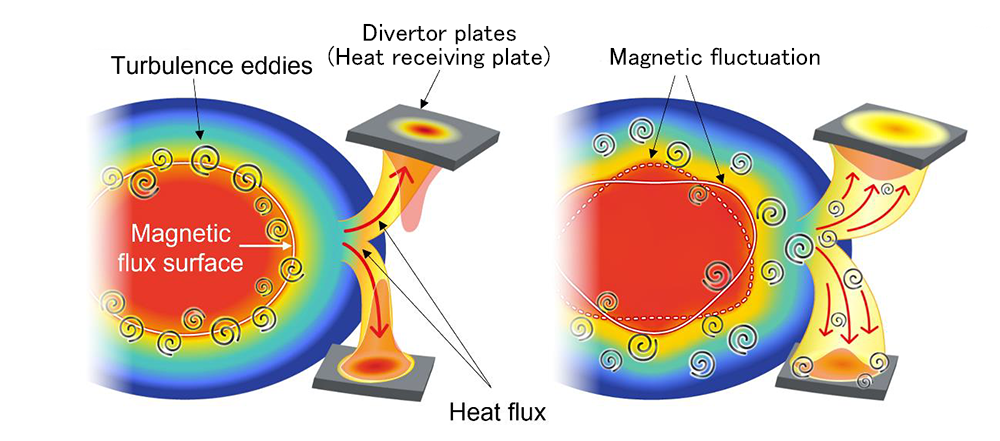
In order to achieve fusion power generation, it is necessary to confine and maintain the high-temperature plasma in a magnetic field. To achieve this, the turbulence that causes the plasma temperature to drop and the large heat load on the inner walls of the device must be controlled. A research group has discovered that, in the Large Helical Device (LHD), when fluctuations are generated in the magnetic field confining the plasma, turbulence in the plasma propagates and the heat load on the inner walls of the device is significantly reduced. This has demonstrated new possibilities for controlling turbulence and heat load.
Improvement of ICRF Antenna Performance with Impedance Transformers
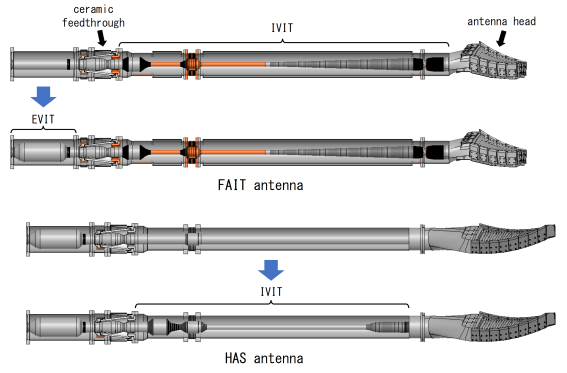
The Large Helical Device (LHD) is equipped with two types of antennas for Ion Cyclotron Range of Frequencies (ICRF) heating. One is the high-power-oriented antenna called the FAIT antenna, and the other is called the HAS antenna, where the wavenumber parallel to the magnetic field lines can be controlled. The performance of these antennas has been drastically improved by utilizing two types of impedance transformers.
Experimental and Theoretical Verification of Atomic Physics Effects Specific to Highly Charged Heavy Ions
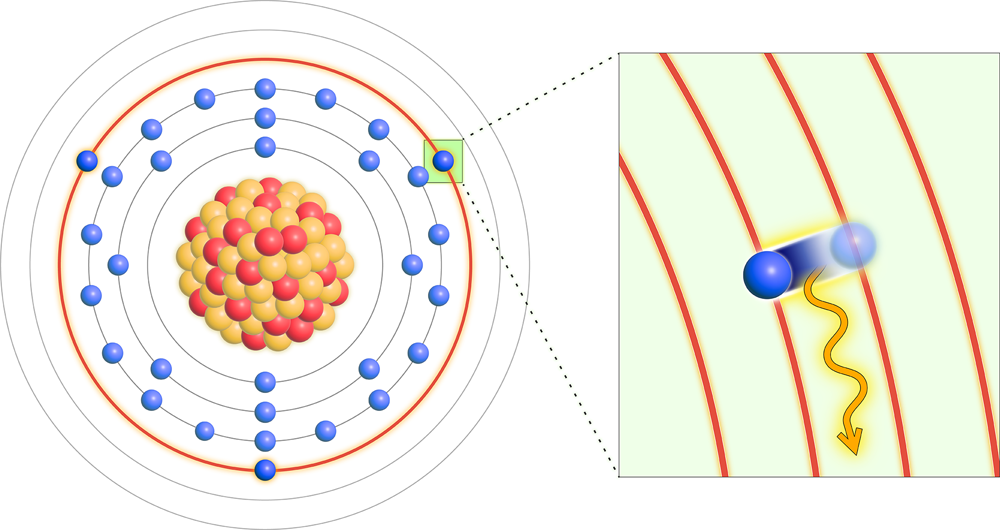
We have investigated atomic number (Z) dependence of transition wavelengths of gallium-like lanthanide ions based on spectroscopic measurements in the Large Helical Device (LHD) and an electron beam ion trap (EBIT). A peculiar Z dependence of the wavelength was found between Z=62 and 63. High-precision atomic structure calculation verified that strong configuration interaction and spin-orbit interaction specific to highly charged heavy ions play an important role in this peculiar behavior.
Investigating plasma transport with a hollow temperature profile by heat pulse propagation
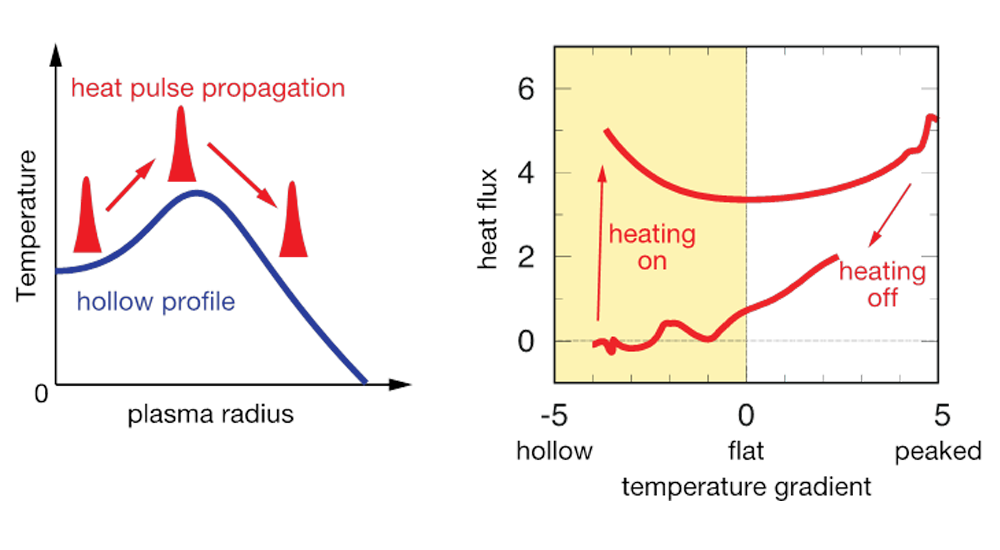
Heat transport in fusion plasmas is often modeled as a temperature gradient. In contrast, when a narrow region away from the plasma center is heated to create a plasma with a peculiar hollow temperature profile, and then a narrow region near the center is additionally heated, a transient phenomenon was observed in which the heat pulse propagates against the temperature gradient. Furthermore, by switching the heating on and off, it was experimentally evaluated that the driven heat flux is not determined by the temperature gradient alone.
Predator and prey relation in peripheral plasmas
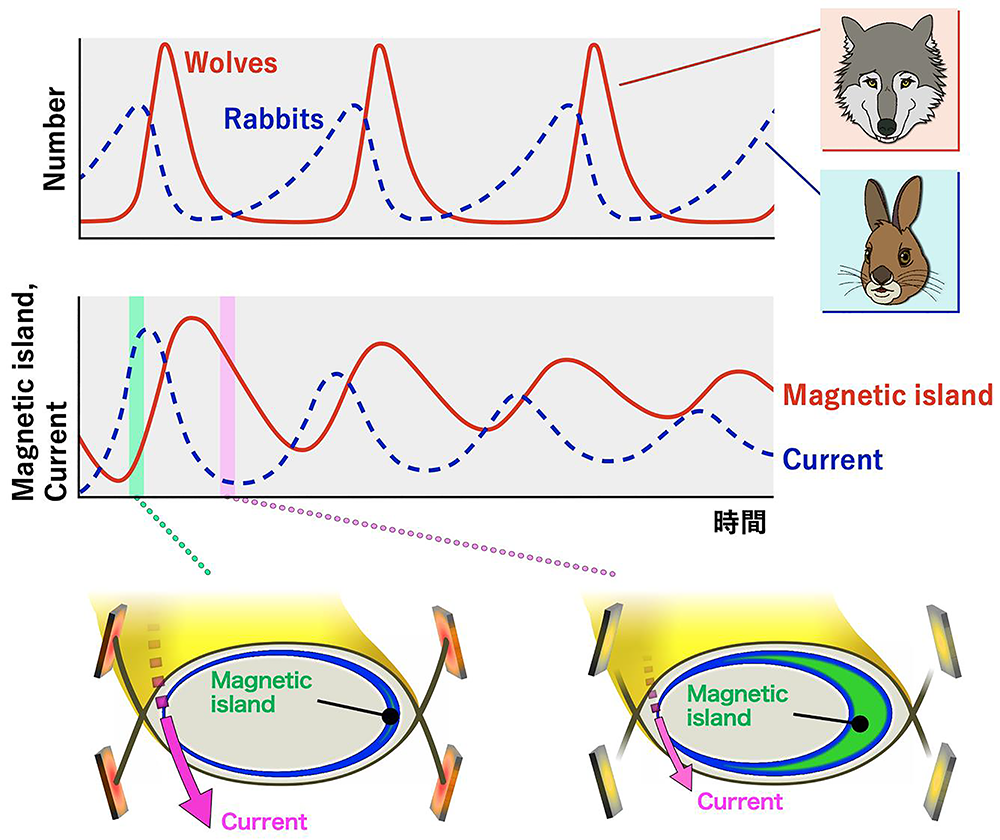
When the so-called magnetic island, an isolated magnetic field structure embedded in the nested tori, is formed, the plasma heat load onto the plasma surrounding materials is significantly mitigated. We discovered a self-sustained oscillation of the magnetic island and the heat load, that provides us an opportunity to resolve the background mechanism of the heat load mitigation. A model originated from biology, the predator-prey model, is utilized to describe the complicated interrelation among physical quantities in the oscillation.
Control of plasma particles by powerful vacuum pumping
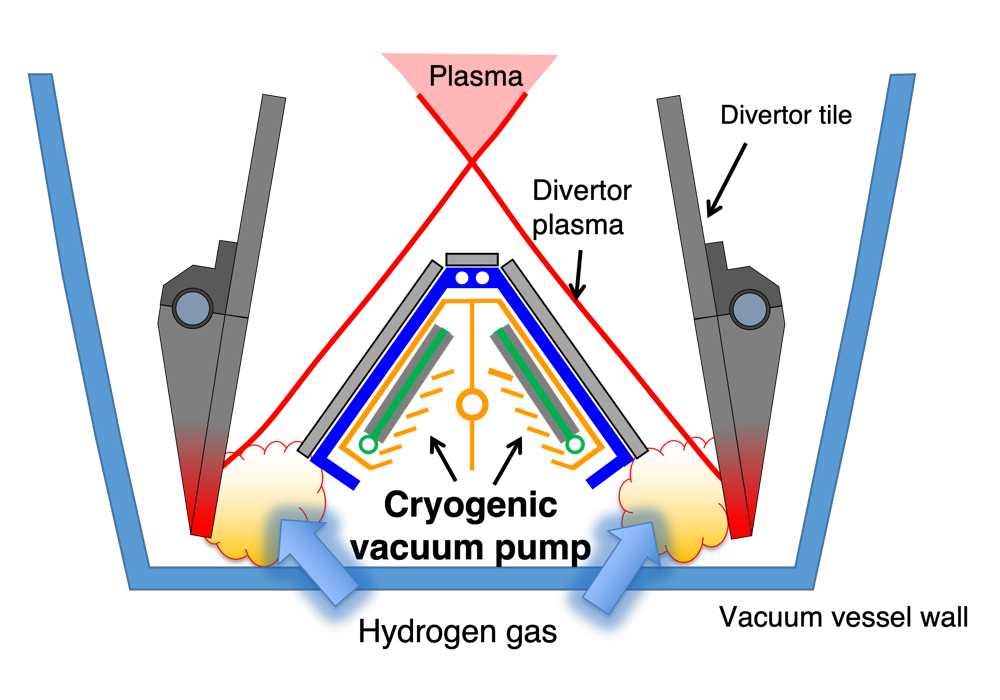
In plasma experiments in the Large Helical Device (LHD), we discovered that the controllability of plasma particles can be improved by compressing fuel particles in a region called the divertor and by pumping them out strongly with a cryogenic vacuum pump. This achievement is expected to greatly advance research on particle control in fusion power generation.
Boron powder injection makes plasma temperature increase
─Both impurities and turbulence are suppressed simultaneously in a discharge─
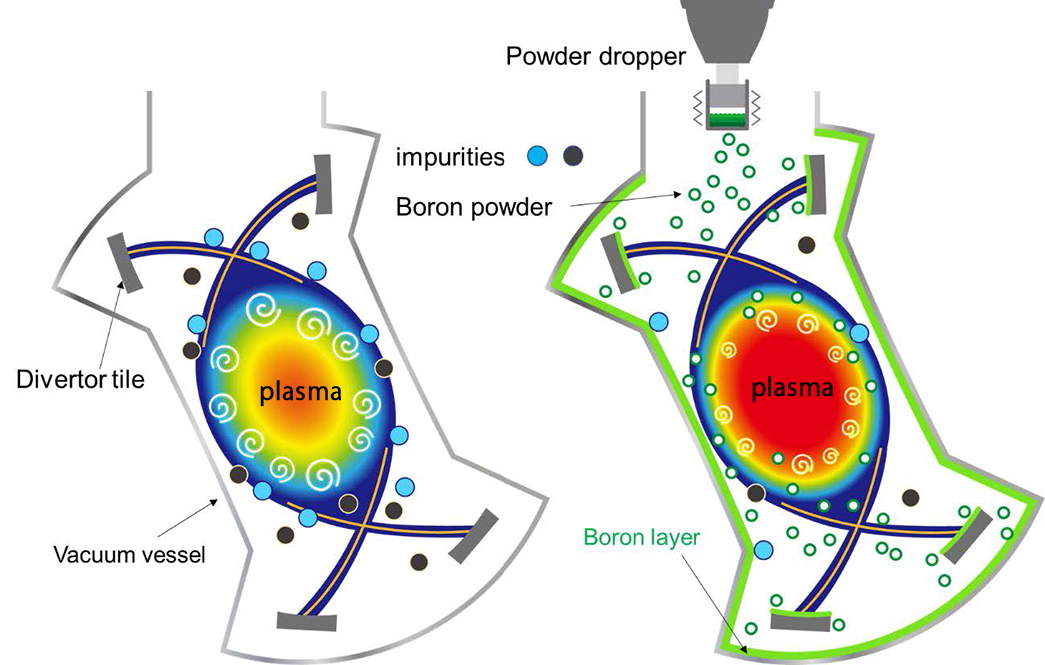
In order to realize a fusion power reactor, it is necessary to maintain a high temperature plasma. For the maintenance, impurities generated from the vessel walls and turbulence generated in the plasma, which can cause large energy loss, should be suppressed. An international collaboration research team of Doctor Federico Nespoli at the Princeton Plasma Physics Laboratory, Professor Suguru Masuzaki at the National Institute for Fusion Science and their colleagues performed an experiment of injecting tiny grains of boron powder into plasma in the Large Helical Device (LHD). They found that the boron powder injection could reduce both impurities from the wall and turbulence in the plasma. This result will greatly contribute to the establishment of a method to stably maintain a high temperature plasma.
Good core plasma performance realized in deuterium plasmas compatible with heat load mitigation at the plasma facing components
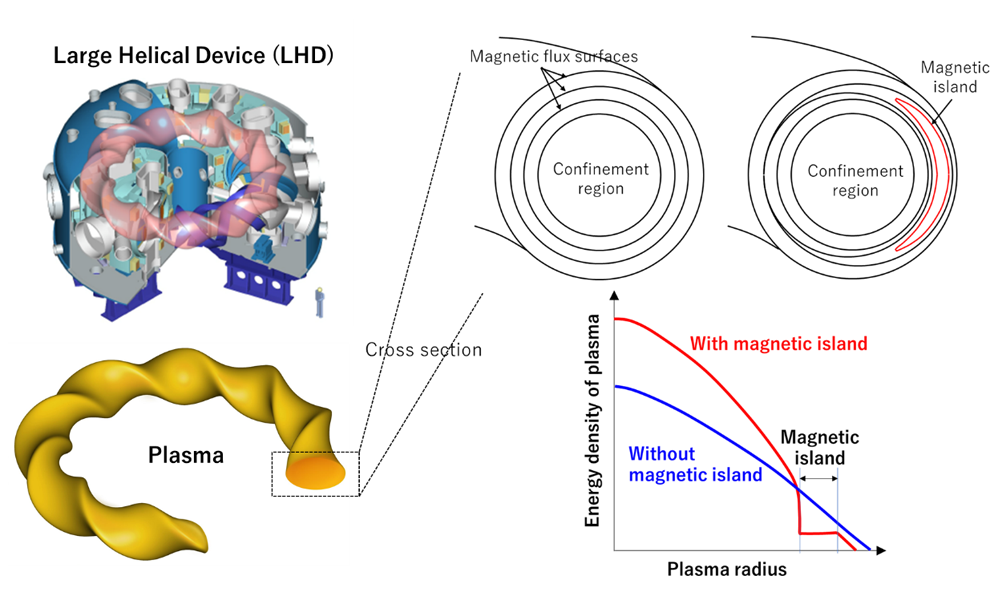
In a deuterium plasma experiment in large helical device (LHD), we have succeeded in reducing the excessive heat load on the device wall while maintaining the performance of the confined plasma. It was shown that, in addition to the isotope effects of the deuterium plasma, the magnetic field structure in the peripheral region plays an important role in separating the high-temperature confined plasma from the low-temperature plasma in the peripheral region. These results provide a bright prospect for the operation of mixed deuterium/tritium plasmas in future fusion power reactors.
Comparison experiments for the optimization of helical reactor

There are several types of magnetically confined plasma devices for energy production. The mainstream of fusion research is the tokamak, where confinement magnetic configuration is produced by plasma current and external coils. The helical device is an alternative option, where confinement magnetic configuration is produced only by external coils. In a helical device, the coil structure is much more complicated compared with a tokamak. However, the helical device has a great advantage for steady-state operation and is favorable for future fusion reactor design. Presently the largest helical devices are Large Helical Device (LHD) at the National Institute for Fusion Science (NIFS) and the Wendelstein 7-X (W7-X) at the Max Planck Institute for Plasma Physics Greifswald (IPP Greifswald). Both devices use super conducting magnet and the sizes are comparable. We have carried out comparison experiments between the LHD and the W7-X. Thus, essential knowledge for the future optimization of the helical device was obtained.
Realization of the stable heat load reduction on the wall using two-species impurity gas injection
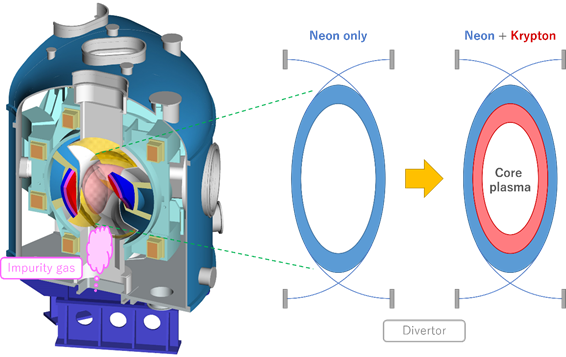
Stable and effective heat load reduction on the wall was realized using neon and krypton injection compared with single-species injection in the Large Helical Device (LHD). Since heat load on the wall should be reduced in fusion reactors, an operational method is investigated to disperse the heat load as plasma radiation using impurity gas injection into the plasma (divertor detachment). This achievement will contribute to develop the operational method of stable divertor detachment.
Advances in Understanding Energetic Ion Transport by Magnetic Field Oscillations

We have shown that the magnetic field oscillations caused by energetic beam ions induce the transport of energetic ions exciting the oscillations. In this study, we developed a new detector to measure high-energy neutrons with high sensitivity and observed that energetic particles that are not the cause of the oscillation also escape from the plasma. This achievement has advanced our understanding of energetic ion transport due to magnetic field oscillations, which is a concern in future fusion reactors.
First observation of characteristic fine structure of global plasma fluctuations
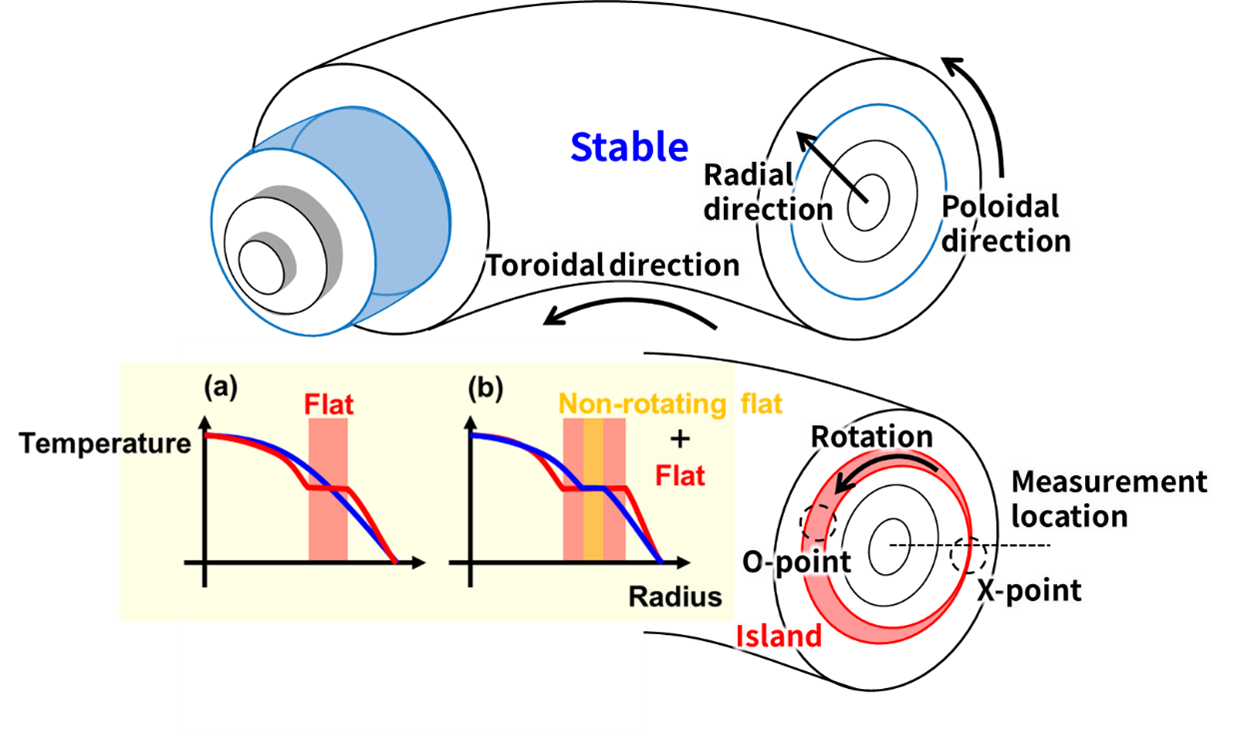
In magnetic confinement plasmas, the rapid growth of temperature fluctuations after the rotation of its fluctuation stops is a problem, and a new measurement technique at LHD has successfully measured the fine structure of temperature fluctuations during the slowing-down of the rotation. We found for the first time that the radial profile of the temperature around the location of the fluctuation changes with time, either flattening or tilting, and that some of the region are constantly flattens. This result will contribute to the understanding of the above fluctuations and will advance the study of other fluctuations using this measurement method.
Spectral line identifications of highly charged praseodymium and neodymium ions in LHD
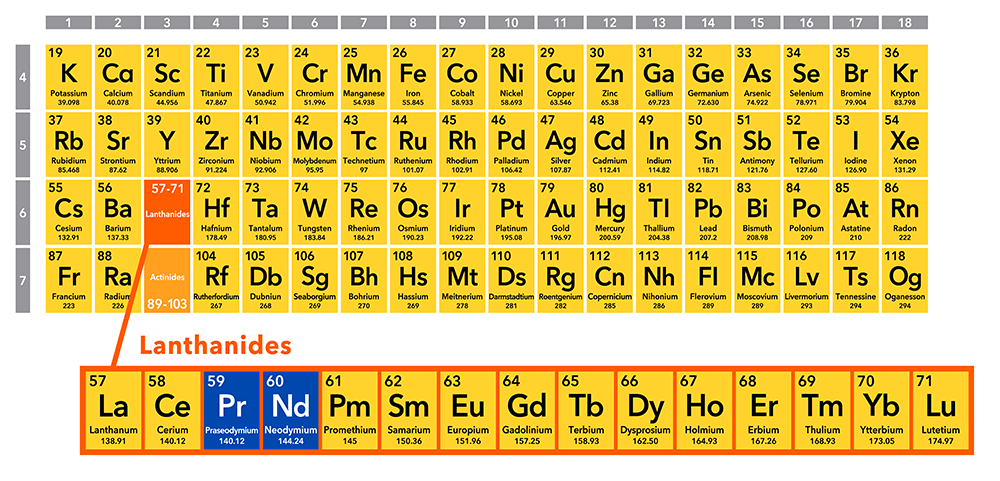
We analyzed extreme ultraviolet emission spectra of highly charged praseodymium and neodymium ions introduced into high-temperature plasmas produced in the Large Helical Device (LHD). Based on the recently published list of lines of neodymium ions in an electron beam ion trap (EBIT) experiment, spectral lines of praseodymium ions were identified as well from the similarity of the spectral features of both the elements. Some of them have been identified experimentally for the first time in LHD.
Improved measurement of the effective ion charge (Zeff)
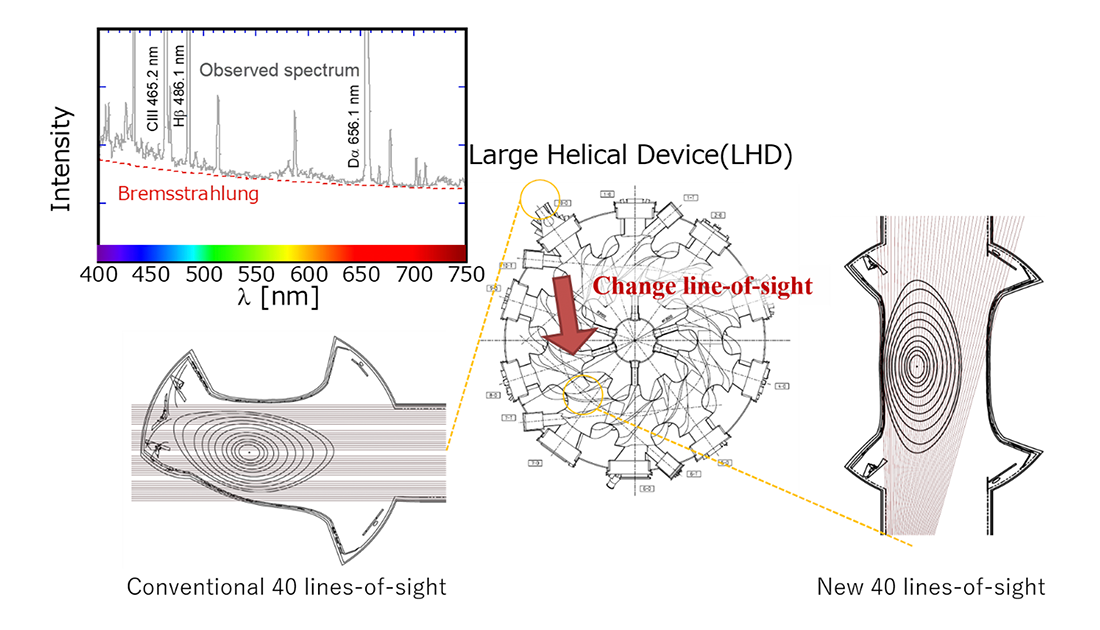
We have improved the measurement of the effective ion charge (Zeff), which represents the amount of impurities in the plasma in LHD. In previous measurements, Zeff was evaluated using signal obtained by the visible spectrometer for a long horizontal plasma cross-section, but an overestimated value was calculated due to the effect of light in scrape of layer which is around the plasma. In order to avoid this effect, the measurement line-of-sight was changed to a plasma cross section with a long vertical direction, which led to an improvement in the Zeff evaluation.
Measurement of ultraviolet emissions steadily confirms powder drop into plasma
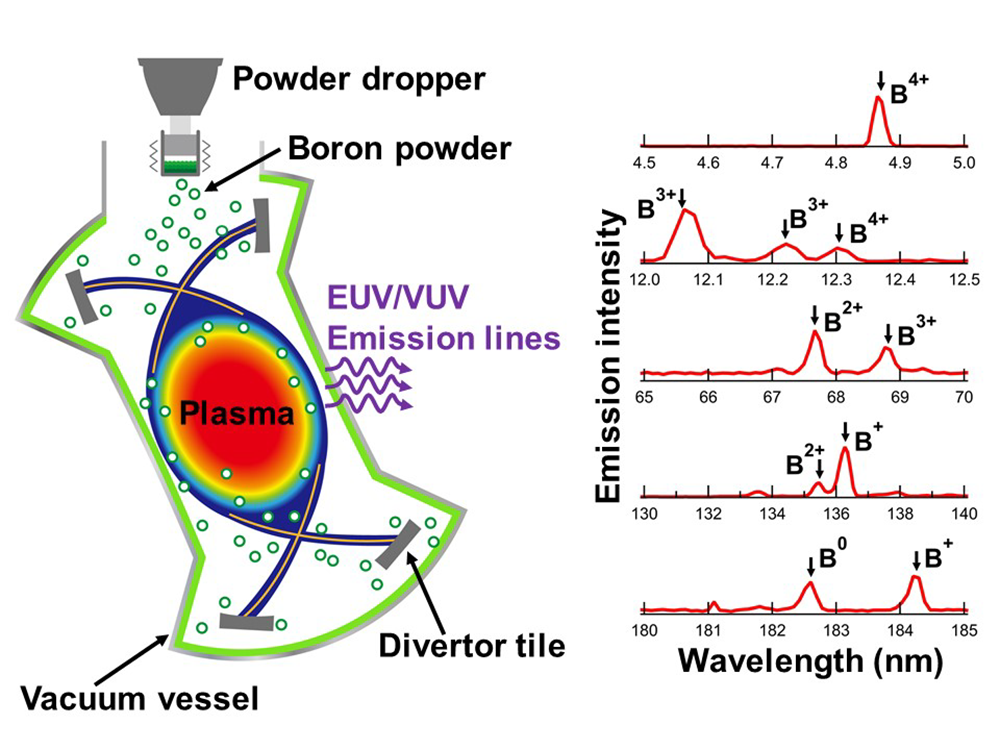
In the Large Helical Device (LHD), boron powders are dropped into the plasma to form a boron layer on the wall of the plasma confinement vessel. Whether the dropped boron reaches the plasma efficiently or not can be confirmed by spectroscopic measurement of the emission of boron ions in the plasma. In particular, by measuring "ultraviolet" light, which has a shorter wavelength than "visible light" that we can see, we can simultaneously observe the emission of boron ions from low to high charge states.
A new method for simultaneously injecting different impurities into the plasma
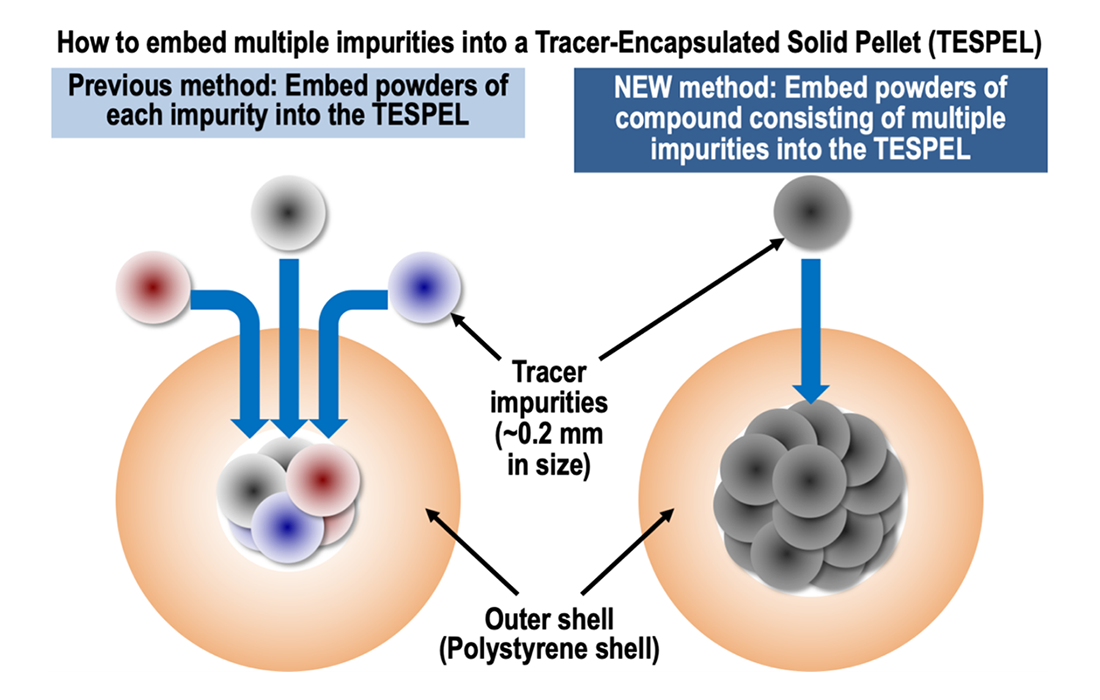
In a tracer-capsulated solid pellet (TESPEL) scheme, which is a technique for locally depositing impurities to the desired location in high-temperature plasmas, we have developed a new method for injecting multiple impurities, which is completely different from a previous method. This achievement will greatly advance the research on the control of impurities in fusion plasmas.
Background physics of isotope effect in confinement improvement plasmas

Confinement improvement is a phenomenon whereby confined plasma generates a thermal insulation layer by itself, by which central plasma temperature rises. It has been known that the confinement improvement transition occurs in an eased condition when plasma fuel gas has larger mass. In this paper, the background physics of this phenomenon, the so-called isotope effect, is experimentally investigated.
Prediction of Unusual Emission of Visible Light in Plasma Experiments by using Machine Learning

In plasma experiments at the Large Helical Device (LHD), unusual emission of visible light inside the plasma vessel has been observed. This emission must be predicted to avoid unexpected damages on the plasma vessel. This research experimentally shows that the unusual emission of visible light inside the plasma vessel can be predicted using a Support Vector Machine, a machine learning method.
Measuring the spatial distribution of energetic particles in a plasma
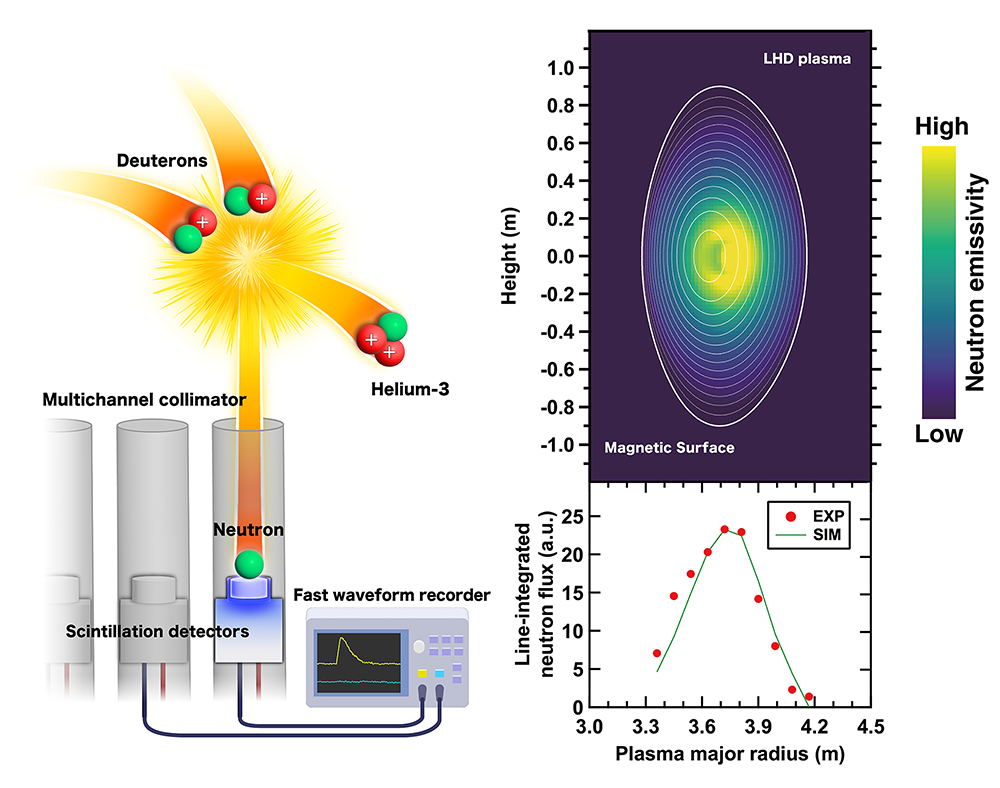
In the deuterium plasma experiment at the Large Helical Device (LHD), the spatial distribution of energetic particles confined in the plasma was measured by using a neutron profile diagnostics to measure the neutron emissiomn profile. A comparison with the neutron emission profile predicted by the energetic particle orbit calculation shows good agreement with the experimental results under high and medium field strength conditions. This has led to a qualitative understanding of the confinement of energetic particles in the LHD.
Observation of damage on the wall without plasma experiments
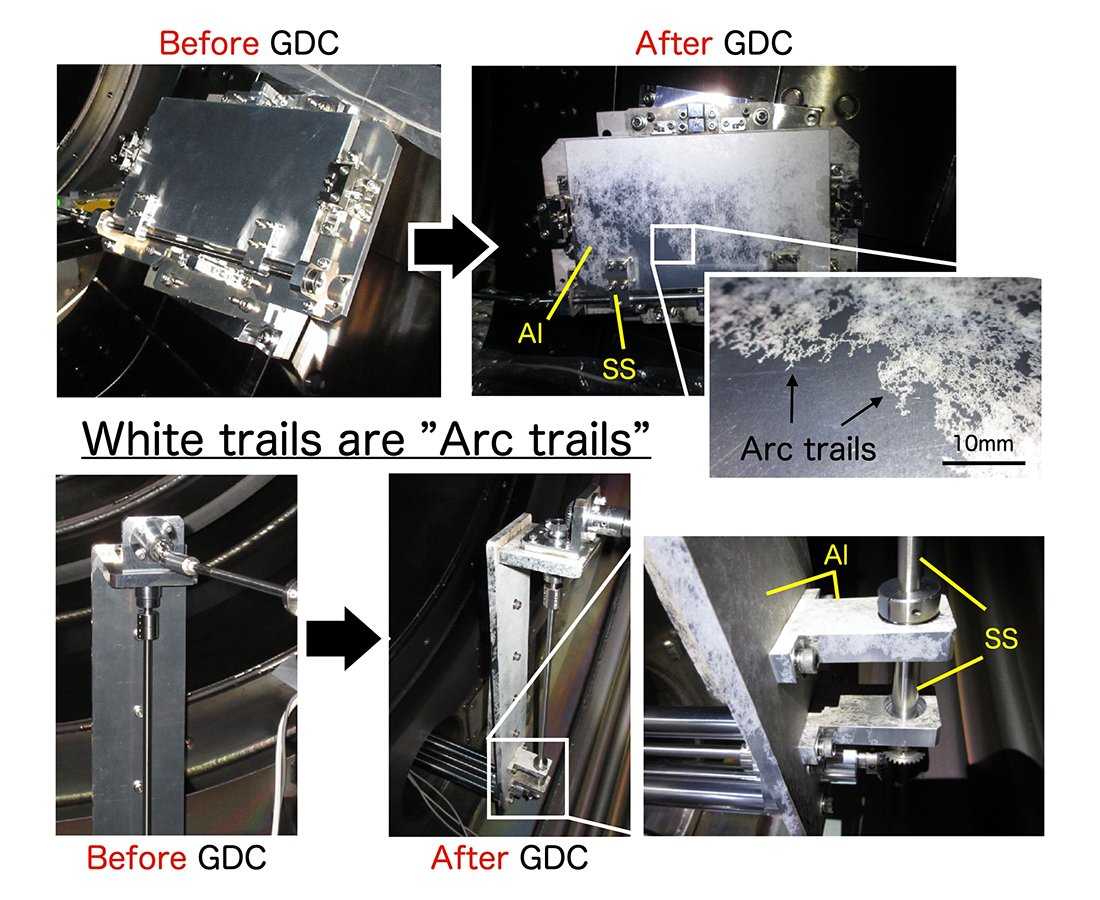
Arc trails induced by Glow Discharge Conditioning (GDC) before the plasma experiments was observed on a part of diagnostic installed in LHD. On the other hand, other part of the diagnostic made of different material survived the arcing damage. Current situation of LHD GDC might be on the border that divides the conditions of arcing ignition between different materials. This result contributes to the selection of the material to be installed in LHD in the future.
Analysis of NB Beam-Ion Loss Mechanisms in LHD
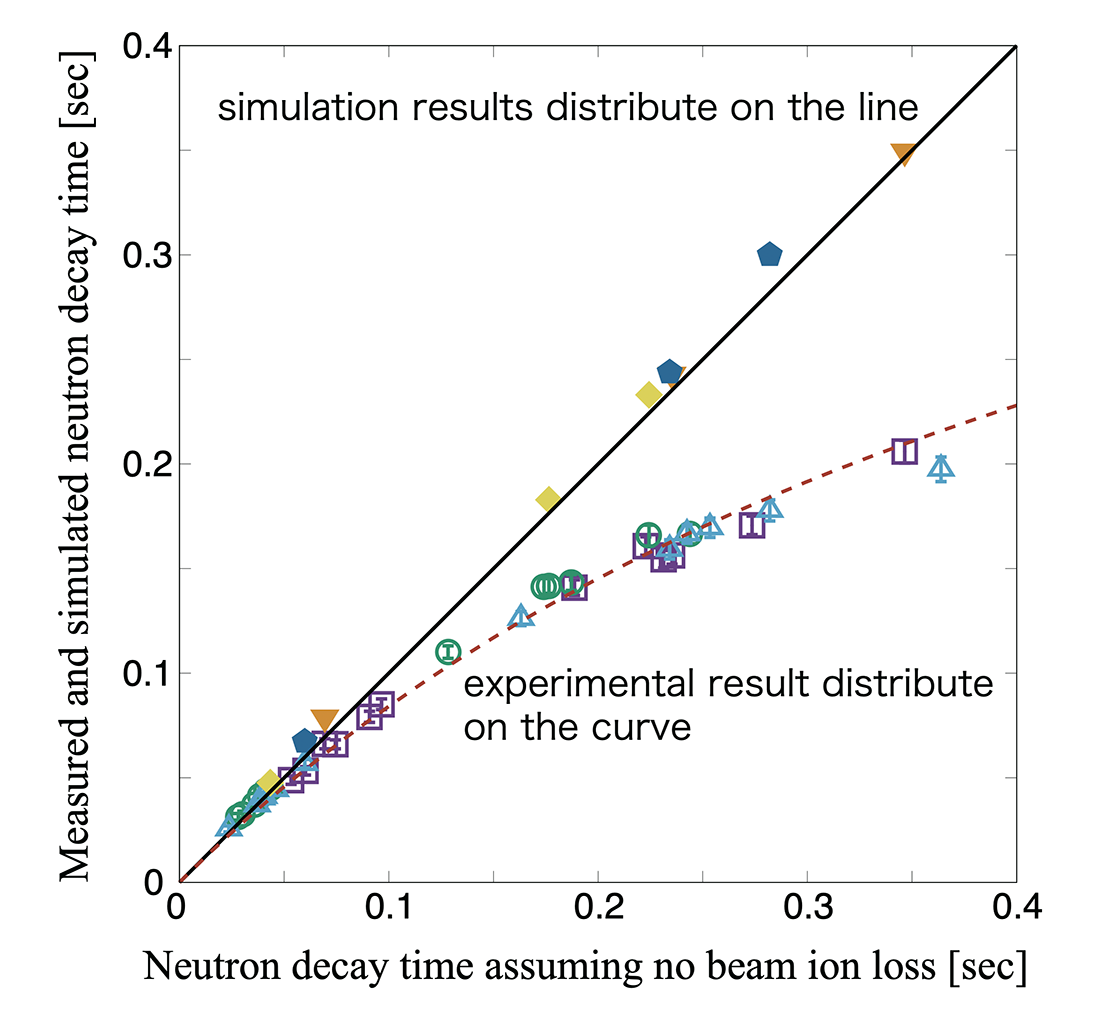
The beam ion loss mechanism in LHD has been analyzed quantitatively by using the neutron measurement and the integrated simulation*. It has been known that the "neo-classical transport"** is dominant as the beam ion loss mechanism in large size tokamaks. Contrary to tokamak cases, the neo-classical simulation can not reproduce the experimental result in LHD. This result indicates that the other mechanism is dominant as the beam ion loss mechanism in LHD.
Advances in the understanding of pellet injection as a plasma diagnostic technique
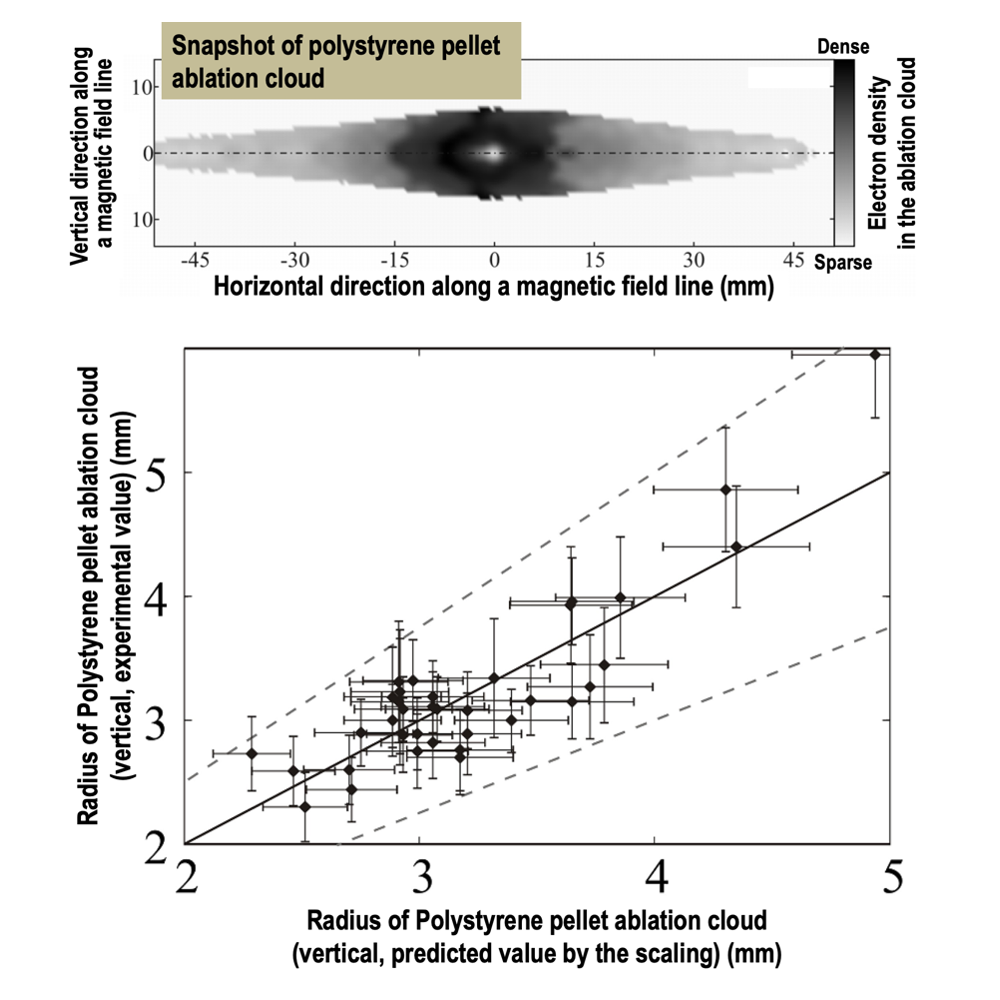
Layers of neutral gas and ions are formed around a hydrocarbon pellet injected into a high-temperature plasma due to interaction with the high-temperature plasma. In this study, we succeeded in deriving a scaling law that determines the region where the light emitted from the pellet is observed. This result enables us to predict the spatial distribution of the electron density and electron temperature around hydrocarbon pellets with high accuracy. Thus, it is expected to advance the study of high-temperature plasmas using hydrocarbon pellets.
Development of a new instrument for micro-scale turbulence observation
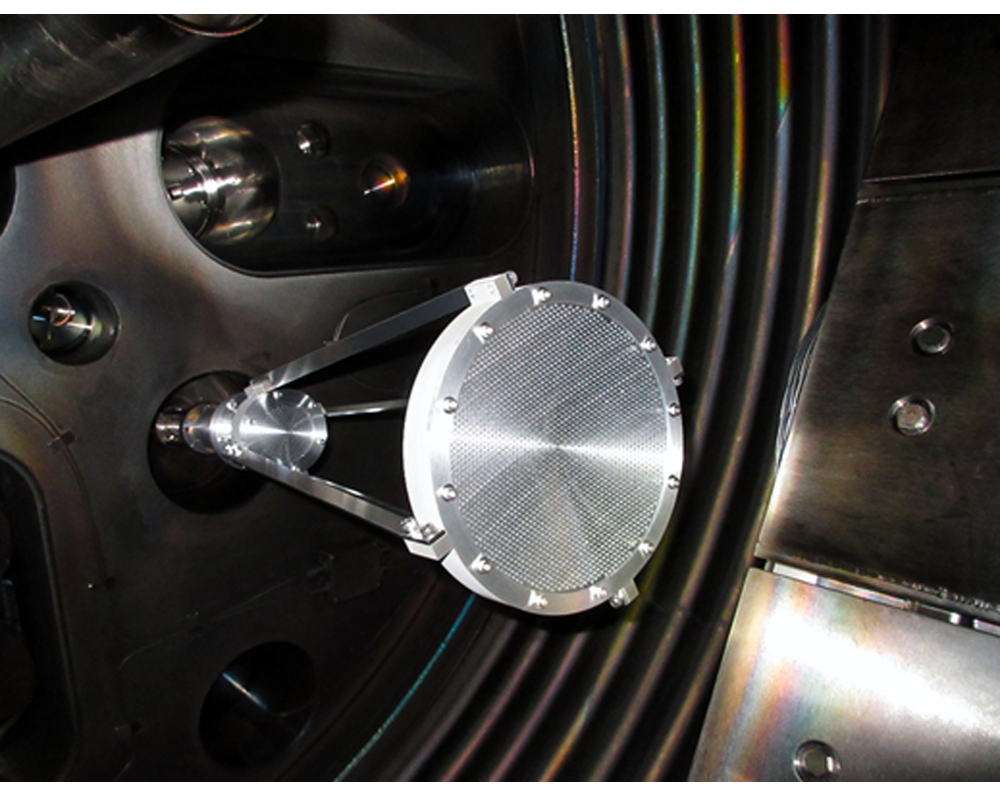
We have developed a new scattering instrument using millimeter wave to observe micro-scale turbulences of about 1 mm in high-temperature plasmas. Although strong intensity of the micro-scale turbulence is thought to have a significant impact on the confinement of high-temperature plasmas, it has been difficult to directly observe it. In this study, we developed a special metal lens and other equipment for use in large helical devices (LHD) and succeeded in detecting the signal caused by turbulence in plasma.
Curious interrelation between density and magnetic field low frequency fluctuations
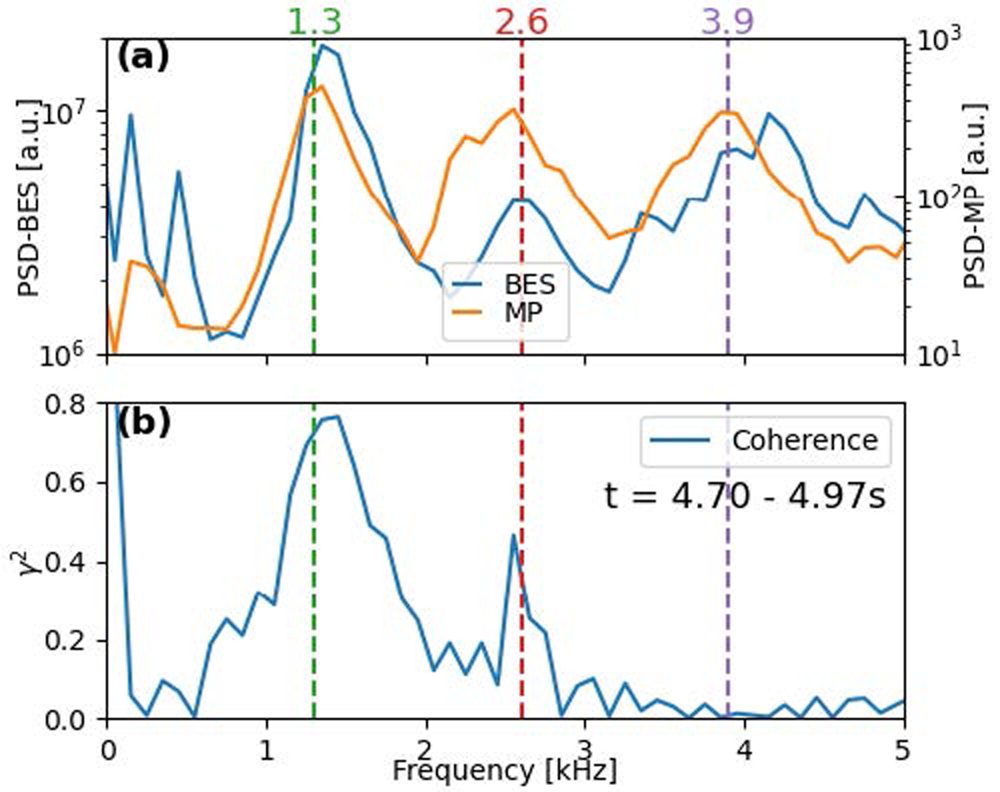
For H-mode plasma in the Large Helical Device (LHD), we examined fluctuations in particle density and the confinement magnetic field, through analyses of measurement signals. We discovered for the first time, that the density and magnetic fluctuations showed randomly different phases at higher harmonics. This result suggests that density fluctuation does not necessarily share the same performance and characteristics as magnetic fluctuation. This shows the importance of advanced density fluctuation diagnostics in order to achieve fusion power generation.
Development of High-Performance Millimeter-Wave Filters for Diagnostics of Internal Structure of Ultra-High-Temperature Plasmas
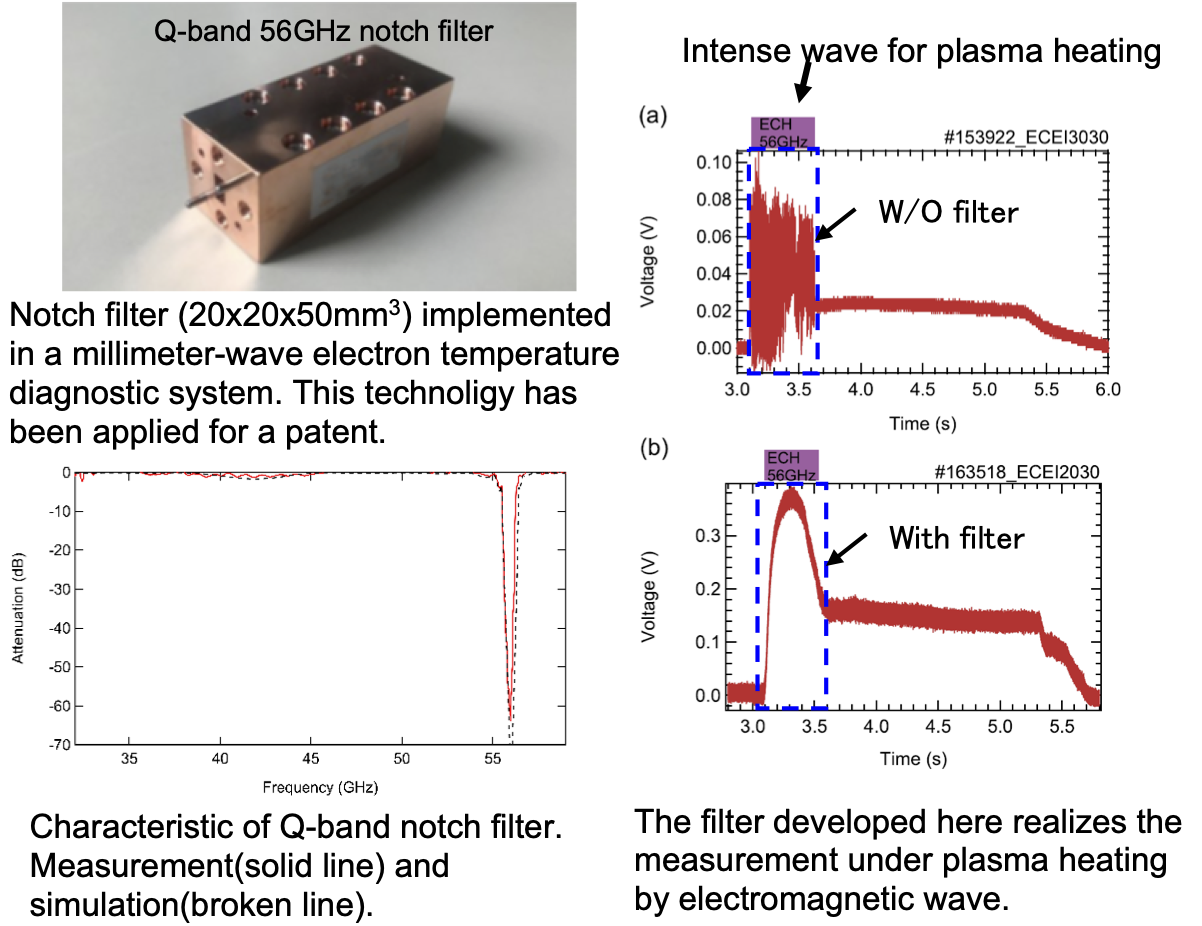
In fusion reactors, millimeter-wave megawatt electromagnetic waves are used to heat the plasma to 100 million degrees Celsius, where the fusion reaction occurs. However, the powerful electromagnetic waves cause damage and noise to the plasma diagnostic system, making it difficult to measure the plasma correctly. To solve this problem, we developed a high-performance notch filter in the millimeter-wave band, which removes only specific frequencies for the millimeter-wave electron temperature diagnostic, and succeeded in measuring the electron temperature. This developed filter is one of the fundamental technologies required for plasma diagnostics using millimeter-waves and has a wide range of applications in industry, communications, and other fields.
Identification of the criteria for the plasma collapse discharge in helical plasmas
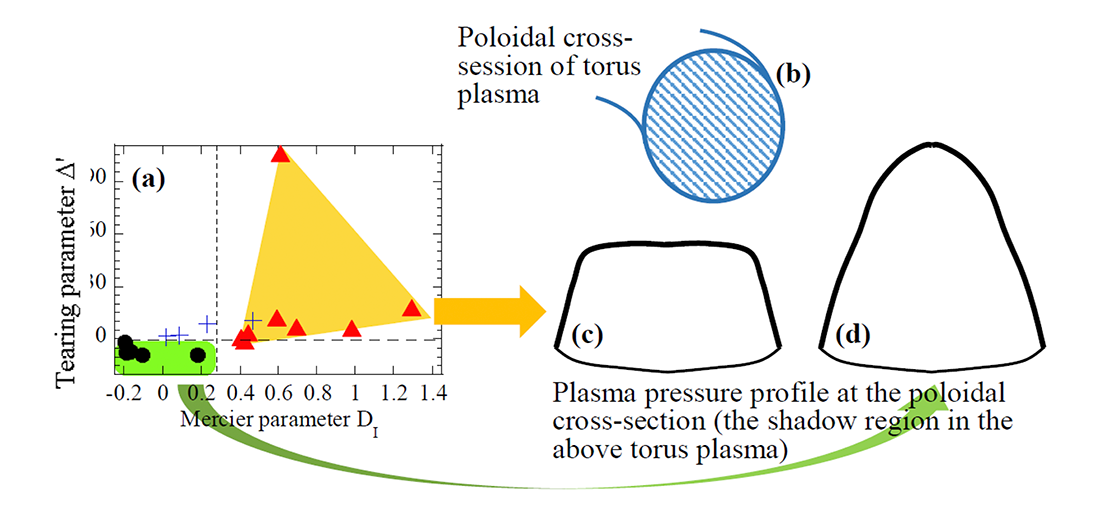
In the LHD, the plasma discharges, with the cases predicted to be unstable in MHD instabilities before the construction, are maintained without any collapse phenomena. On the contrary, in the discharges predicted to be much unstable by a theory, the collapse phenomena are observed. We investigate the criteria of the collapse discharges using the measured plasma pressure and current profiles, and identify the criteria leading to the collapse that Mercier parameter >0.3 and tearing parameter >0.
Predicting the onset of plasma collapse and capturing the changes in the plasma as it moves toward collapse
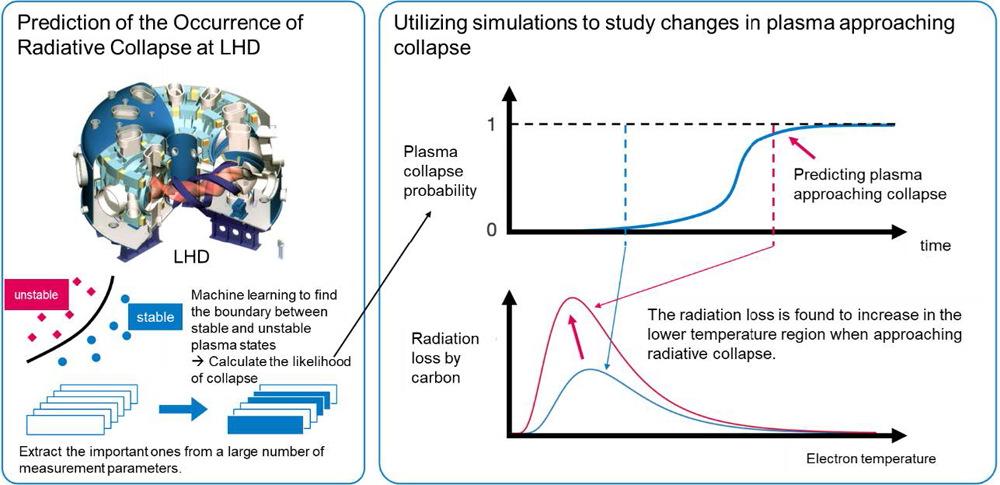
Using experimental data from the Large Helical Device (LHD), we evaluated the probability of radiative collapse using machine learning techniques. We also clarified how plasma changes during a time when the probability of collapse increases, i.e., when the plasma is approaching collapse, through simulations.
Control of energy output from fusion plasma
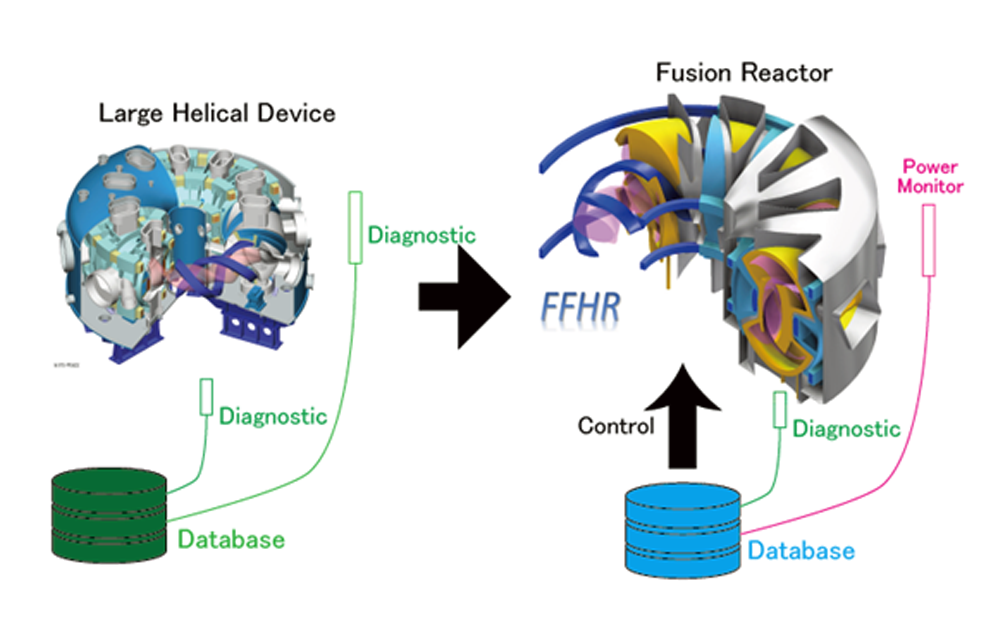
We applied the regression analysis, which shows the dependence of one parameter on the other parameters, to investigate the relationship between the neutron emission rate and externally controllable parameters in the LHD deuterium experiment. We found that the neutron emission rate can be expressed by the formula consisting of plasma density and heating power. Hence, we obtained a method to control the fusion energy in a future burning plasma. A trial of extending the total neutron emission rate record in steady-state discharge was performed based on a data-driven approach. We successfully updated the total neutron emission rate record supported by the regression expression.
Development of standard neutron flux monitor for fusion research
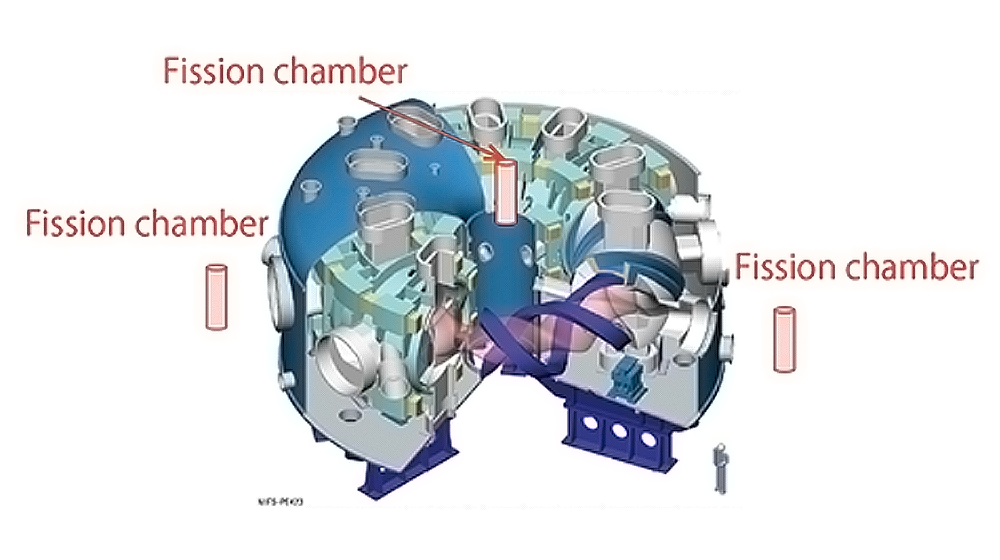
We have developed a neutron flux monitor equipped with the latest digital circuit technology to accurately measure and control neutrons generated in deuterium plasma experiments at the Large Helical Device (LHD). The monitor has a wide measurement range, fast response time, and high immunity to electromagnetic noise and is in stable operation at LHD. It is expected to play an active role as a standard control and measurement device in fusion plasma experiments such as JT-60SA and ITER..
Improvement of spectral resolution using maximum entropy method (MEM)
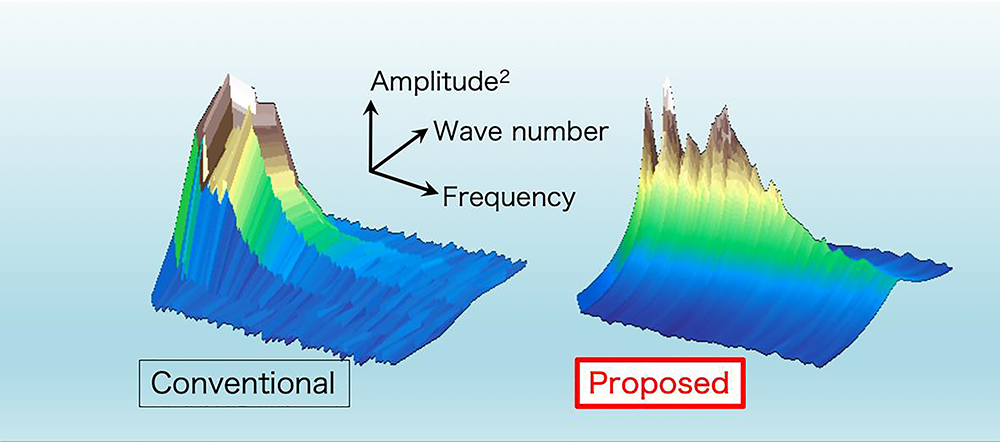
By the maximum entropy method, spectral resolution of plasma turbulence was significantly improved. In order to sustain stable magnetically confined plasmas, it is important to characterize the spatial scale and amplitude of turbulent eddies. By applying a newly proposed manner, it becomes possible to obtain detailed information of turbulent eddies, which is essential for plasma turbulence modeling.
First observation of degradation of confinement and reversal of plasma flow due to broken confinement magnetic field
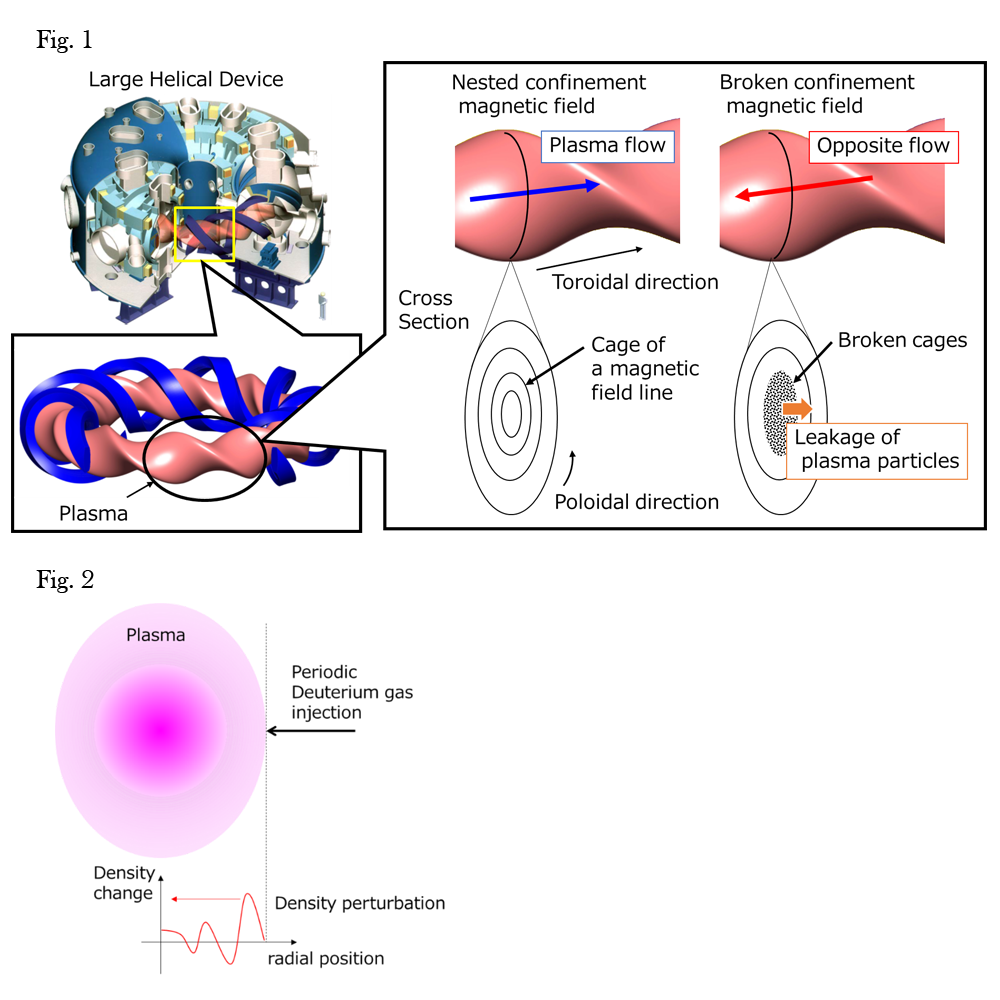
In the Large Helical Device (LHD), the leakage of the plasma particles and the reversal of the plasma flow due to the broken confinement magnetic field are observed. The broken confinement magnetic field is produced by changing the direction of the plasma current which is driven by the electromagnetic wave. These findings show that the direction of the plasma current driven by the electromagnetic wave is important for the plasma confinement and the braking of the plasma flow, which was observed in the previous research, is caused by the reversed force due to the breaking magnetic field.
Remote Experiment from the Opposite Side of the Earth
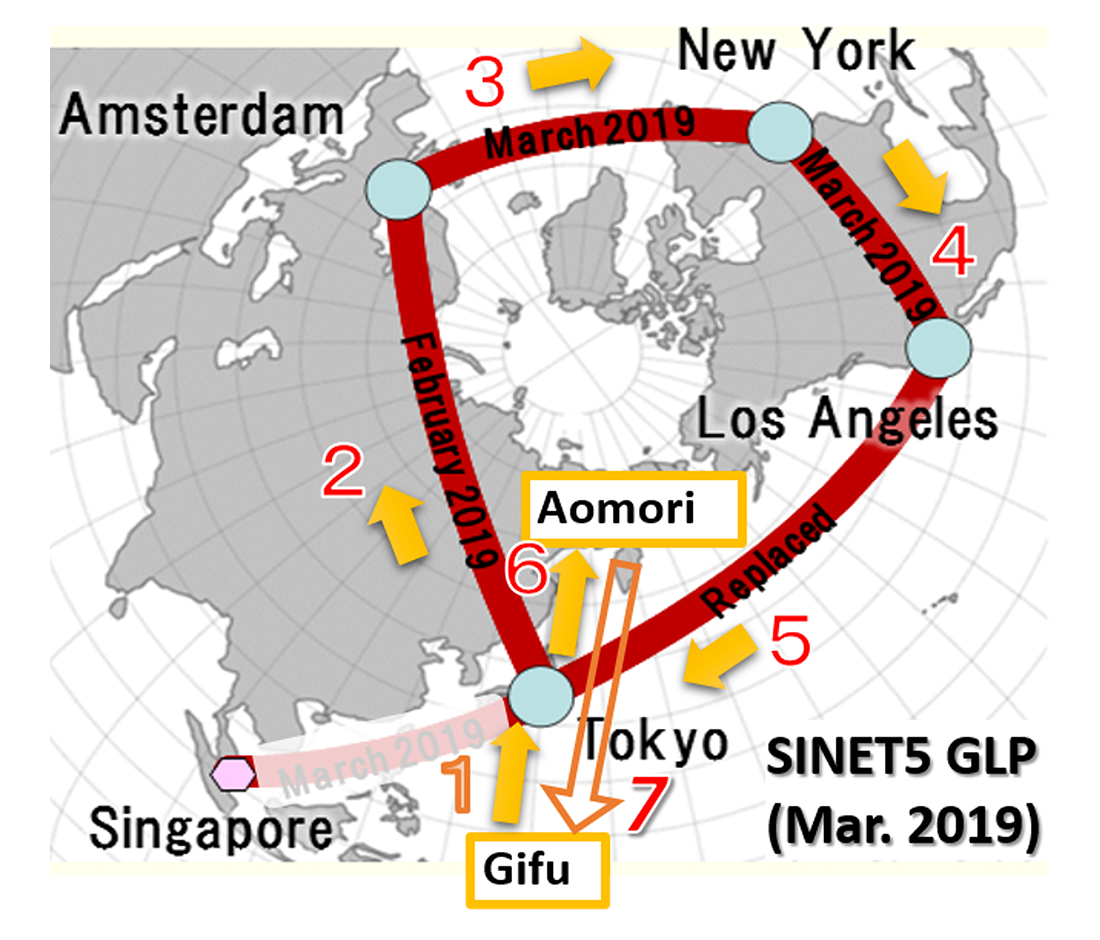
Technical verification has been progressing for high efficiency data replication between ITER and the Remote Experimentation Centre (REC) in Japan. Transferring a huge amount of data simultaneously to multiple destinations may cause excessive loads and network bandwidth on the sender so that daisy-chained relay transfer would be a considerable solution. This study demonstrates how efficiently the replication relay could be realized for the next-generation fusion experiments, such as ITER and JT-60SA.
Data location informing service to quickly find out the data distributed in remote sites
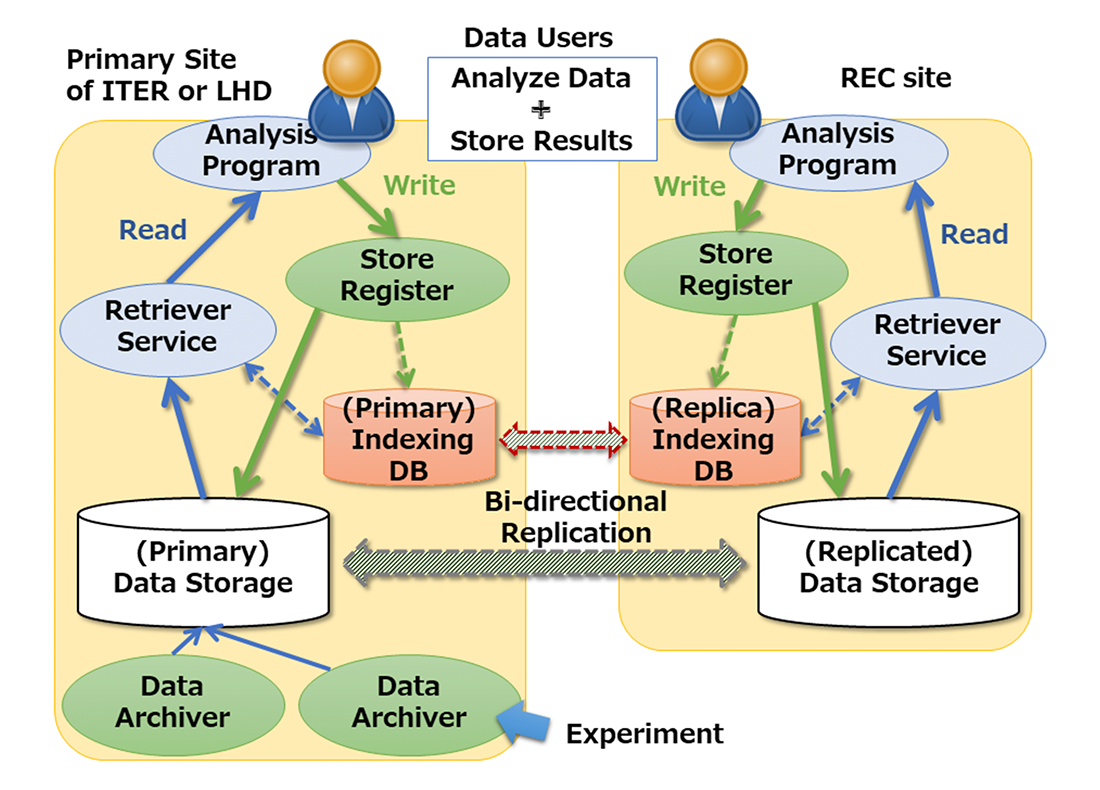
ITER UDA structure and the replicated repository: If there is only one indexing DB, it would be a single point of failure (SPOF). Remote site’s independence against accidental loss of long-distance network connectivity or planned power outages can be improved if the replicated indexing DB can continue operation independently from the primary indexing DB even though the real-time synchronization is temporarily lost. The indexer process should always register a new data entry synchronously with the data migration process making a new copy of the data or moving to other place, locally or remotely.
Construction of the measuring system for plasma heat flux to the wall
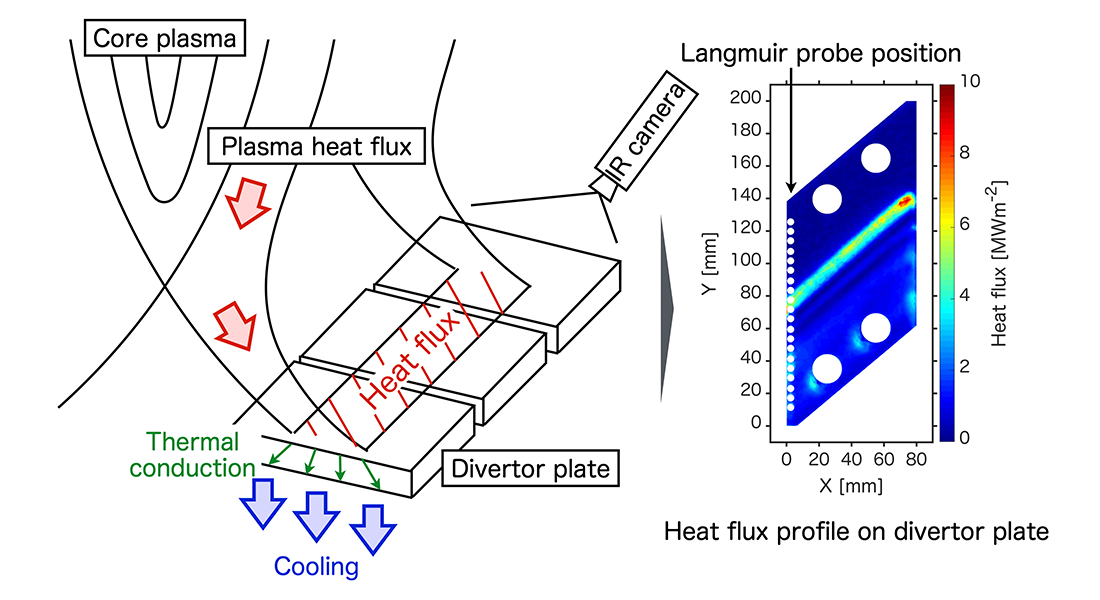
Significant heat flux is expected at the wall called “the divertor plate” in the fusion device. The present study constructed the system for measuring the divertor heat flux by 2 dimensional (2D) thermography and thermal conduction analysis in LHD. The development of the system accelerates the detailed understanding of the divertor heat flux in the LHD and development of a numerical simulation code with high accuracy.
Slowing-down mechanism of rotating fluctuation in magnetic confinement plasmas
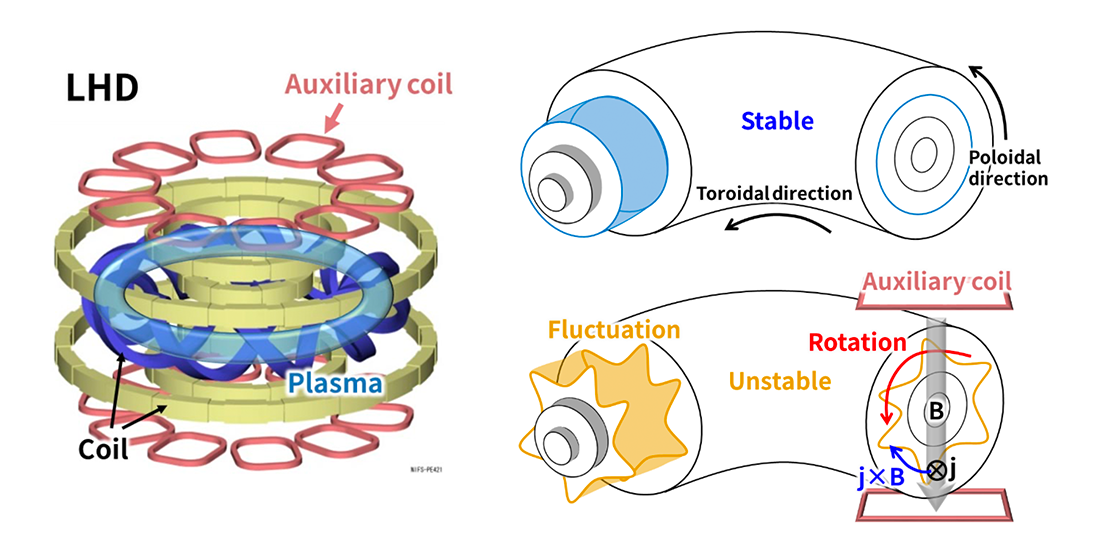
In LHD a rotating fluctuation is often observed and the rotation frequency of the fluctuation sometimes decreases to almost zero. After the decrease of the frequency, the fluctuation rapidly grows and the plasma confinement performance deteriorates. In this study, the slowing-down mechanism of the rotating fluctuation is experimentally clarified. Since the slowing-down is closely related to the stability of the fluctuation, this result will accelerate the research to avoid or suppress the rapid growth of the fluctuation, which causes serious degradation of the core plasma performance
Impurity accumulation layer profiles in the Large Helical Device have been successfully reproduced by simulation
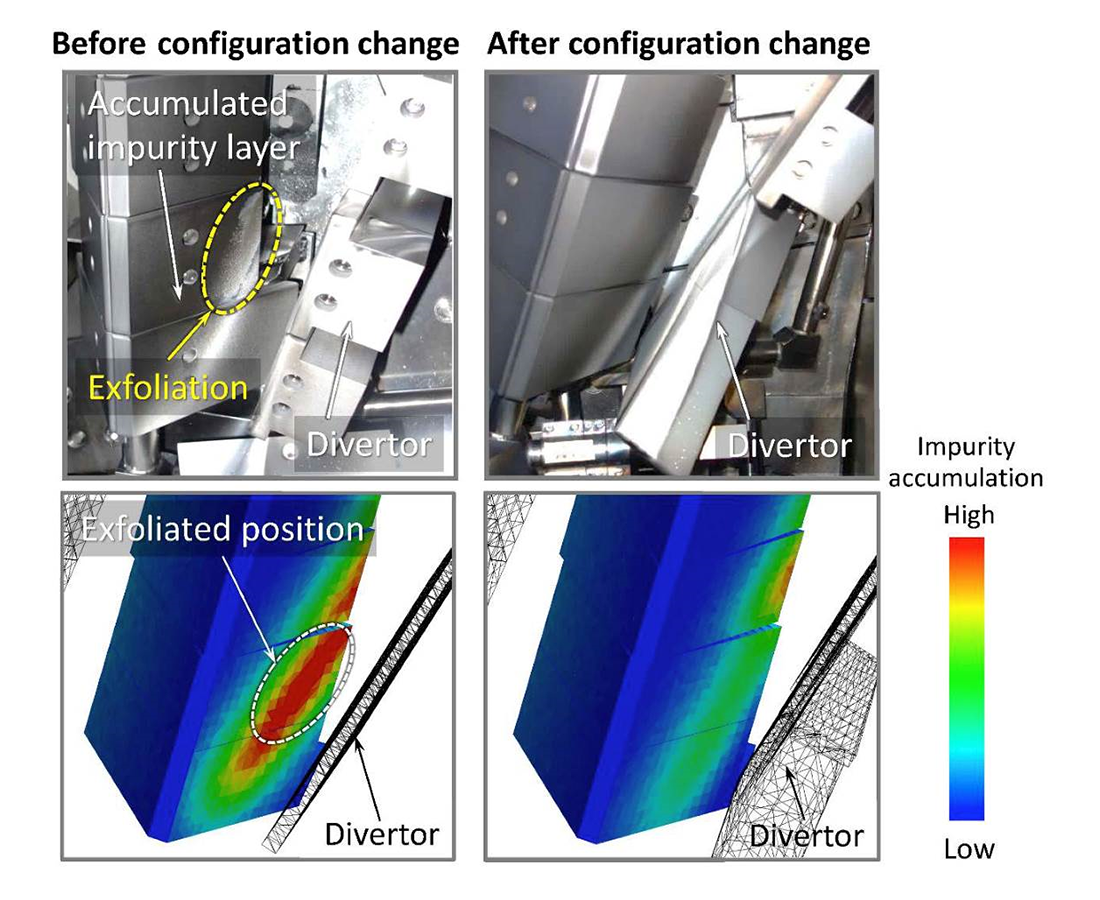
In LHD, impurity layers have been accumulated on the in-vessel components every plasma discharge. The layers are very fragile and are characterized by the exfoliation property. Plasma discharges can be interrupted by the exfoliated impurity layers entering the plasma. Our simulation has successfully reproduced the areas where the impurity layers are accumulated. It will contribute to the stable operation of future nuclear fusion reactors.
Remaining tritium in graphite divertor tiles were quantitatively analyzed by using a full-combustion method
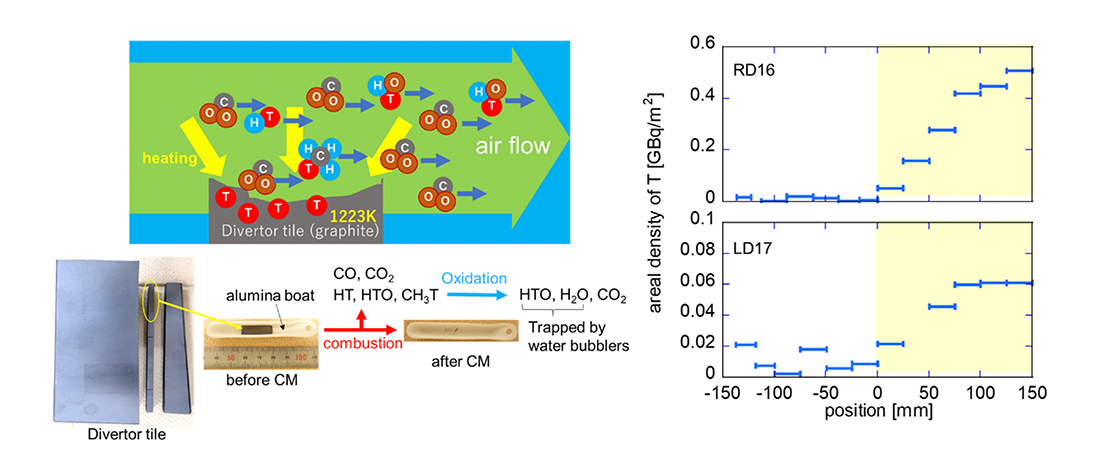
To reveal the triton transport and the tritium migration in a deuterium plasma experiment in LHD, remaining tritium in divertor tiles made of graphite was investigated by using a combustion method. Obtained remaining tritium profile in two divertor tiles were in consistent with the profile of lost-points of promptly lost high energy triton on the divertor tiles calculated by using a Lorentz orbit following code (LORBIT) with taking into account divertor components.
Discovering Turbulence to Help Plasma Mixing
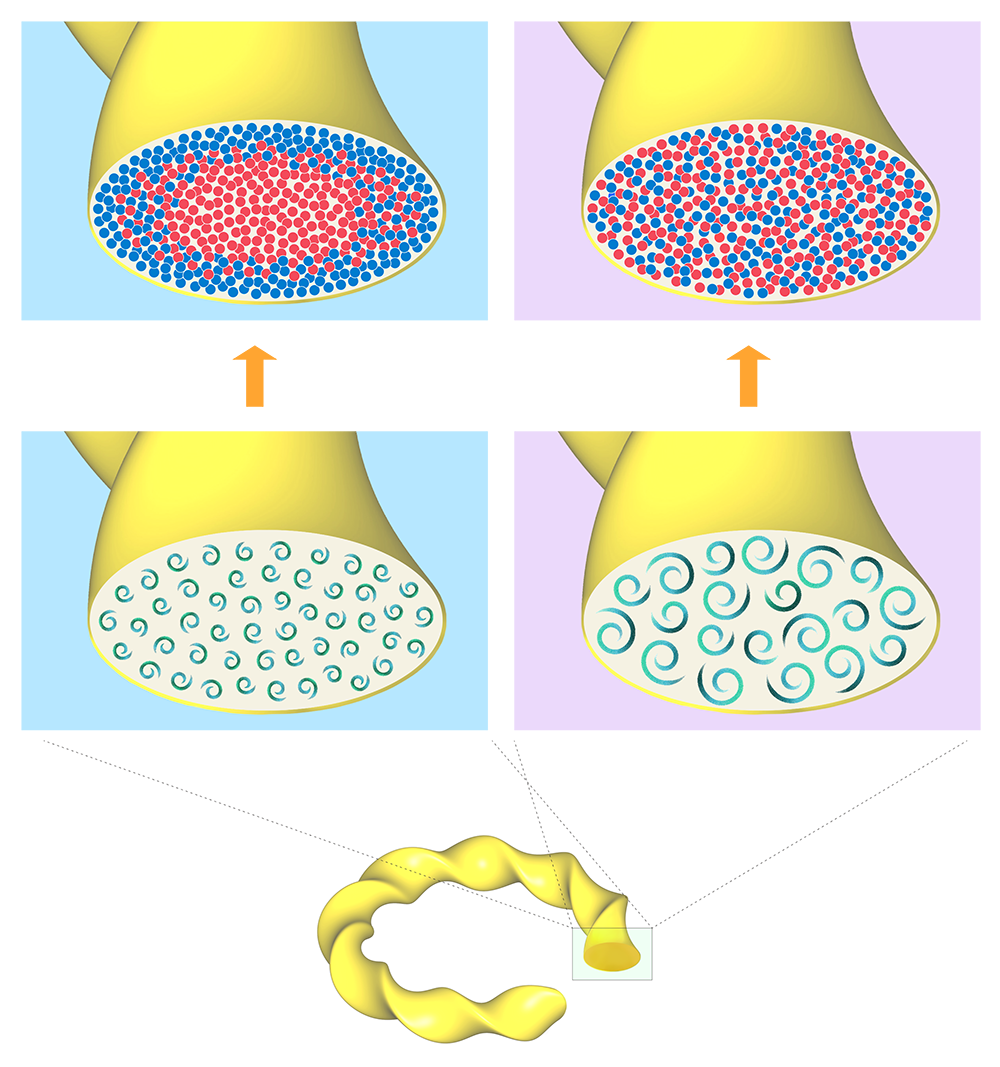
The mixing state of hydrogen and deuterium in plasma was measured for the first time in the world in a mixed plasma experiment using hydrogen and deuterium in a large helical device (LHD). It was found that the hydrogen and deuterium plasmas do not mix when their size of the plasmas is small but do when they are large, caused by the heating process. This achievement gives a guideline for the "mixed state" necessary for hydrogen isotope mixed plasmas used in nuclear fusion power generation.
World's First Detection of Anisotropy in Electron Motion by Spectroscopic Measurement
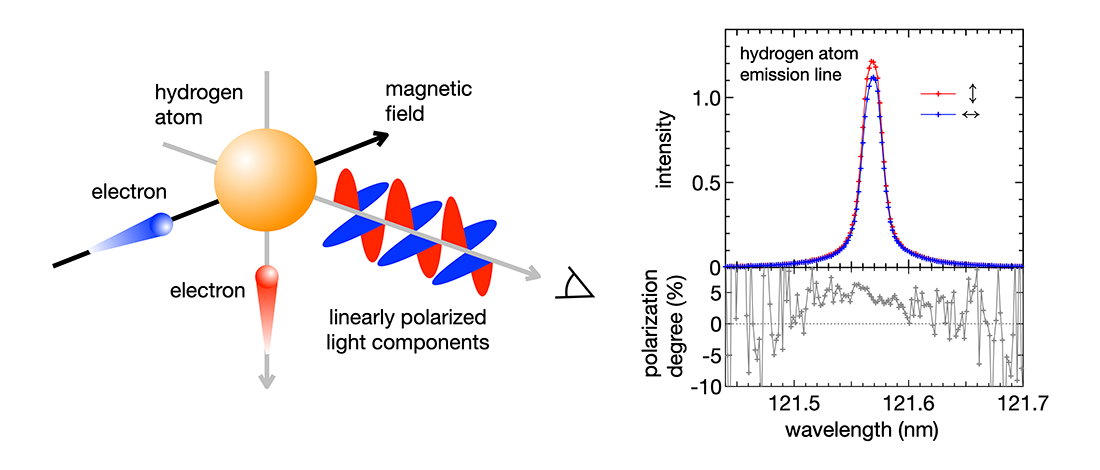
In the Large Helical Device (LHD), the polarization of light emitted by hydrogen atoms has been measured with an accuracy of 1%. The analysis of the polarization angle showed that the motion perpendicular to the magnetic field is more dominant than that parallel to the magnetic field for electrons at the plasma edge, which supports our intuitive understanding of the plasma condition in that region.
Plasma fluctuation captured by 64 pixel and one million frame rates detector
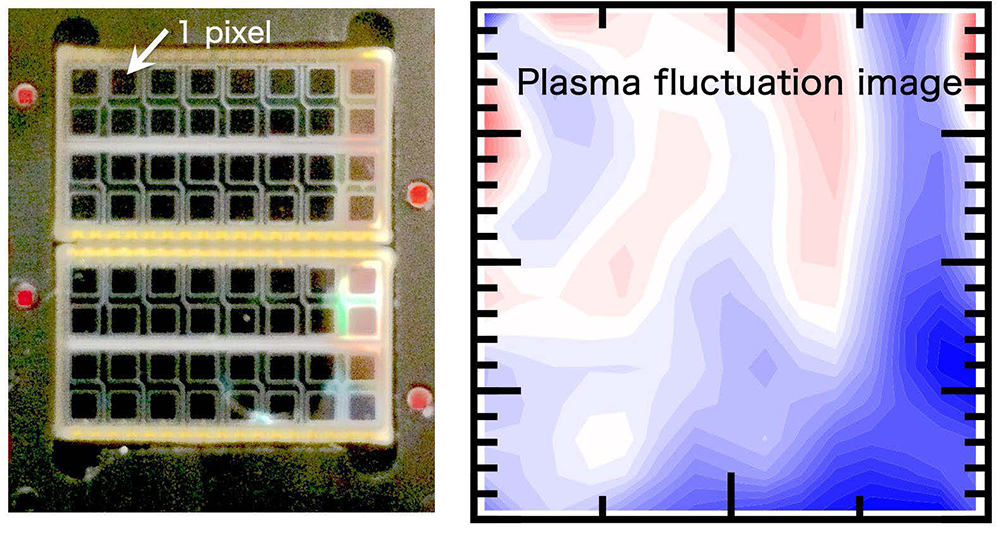
In the Large Helical Device (LHD), a plasma fluctuation measurement system has been developed using an ultra-fast detector. Light emission from the plasma was measured by an 8x8 two-dimensional detector array, having one million frame rates. By using this system, a fast measurement of plasma density fluctuation was successfully performed.
Neutron measurement using an artificial diamond
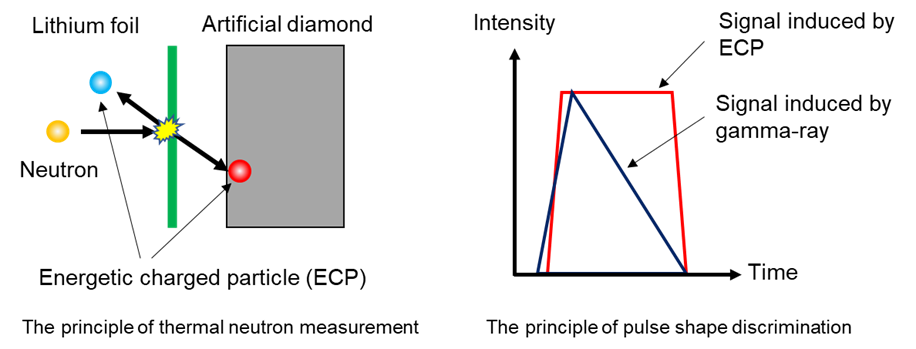
We established the pulse shape discrimination method for evaluating thermal neutron flux using artificial diamond detector. By this method, the detection efficiency of thermal neutron increased with 1.5 times compared to the previous work. This work can improve the neutron control and measurement system in the fusion reactor.
Let the accumulated data talk about the state of plasma

We have developed a method for grasping the state of plasma using a large amount of data accumulated in experiments in LHD and have succeeded in demonstrating its practicality. This result provides an example for methods to make the best use of the data accumulated in fusion research, and greatly advances research toward real-time control of plasma.
Investigating the cause of the disturbance
in maintaining the high-ion temperature state
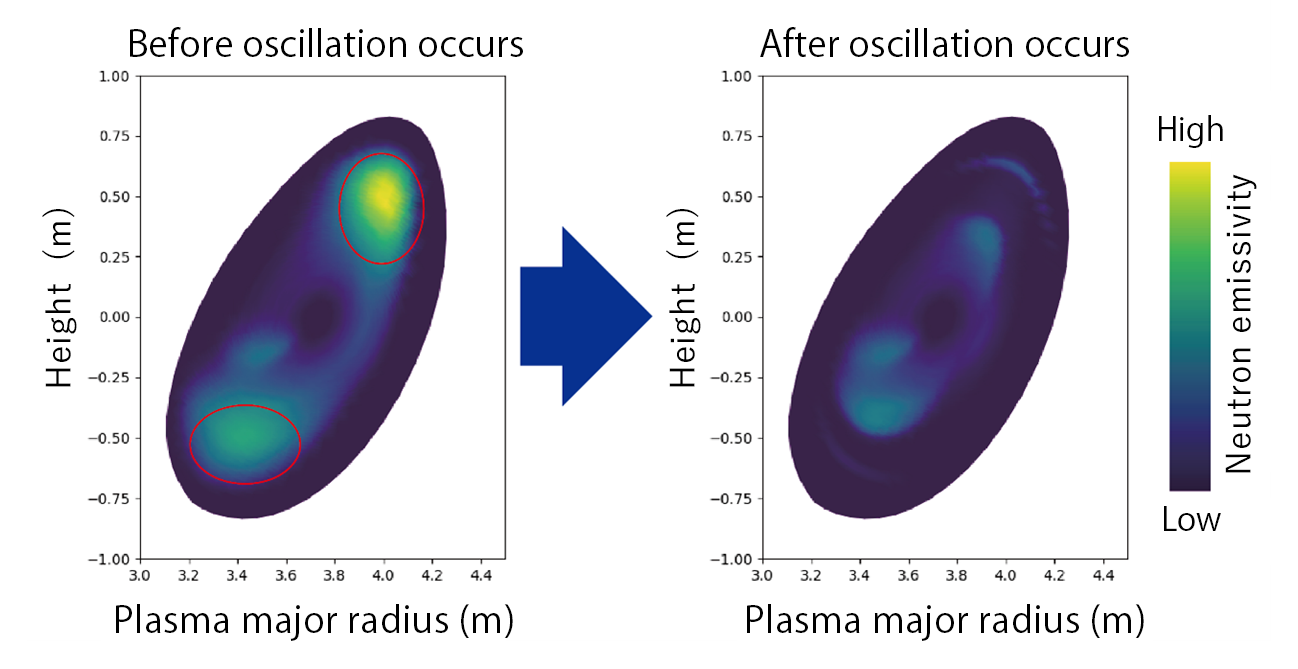
In high-ion temperature plasma discharges in the Large Helical Devices, magnetic field oscillations, caused by energetic ions, limit the sustainment of high-ion temperature state. In this study, the energetic ions escaping from the plasma due to the magnetic field oscillation has been observed by the neutron emission profile diagnostics in a deuterium plasma experiment. Based on this result, it is expected to develop a method to maintain a high-ion temperature state for a long time.
Estimation of the beam ion confinement time in LHD
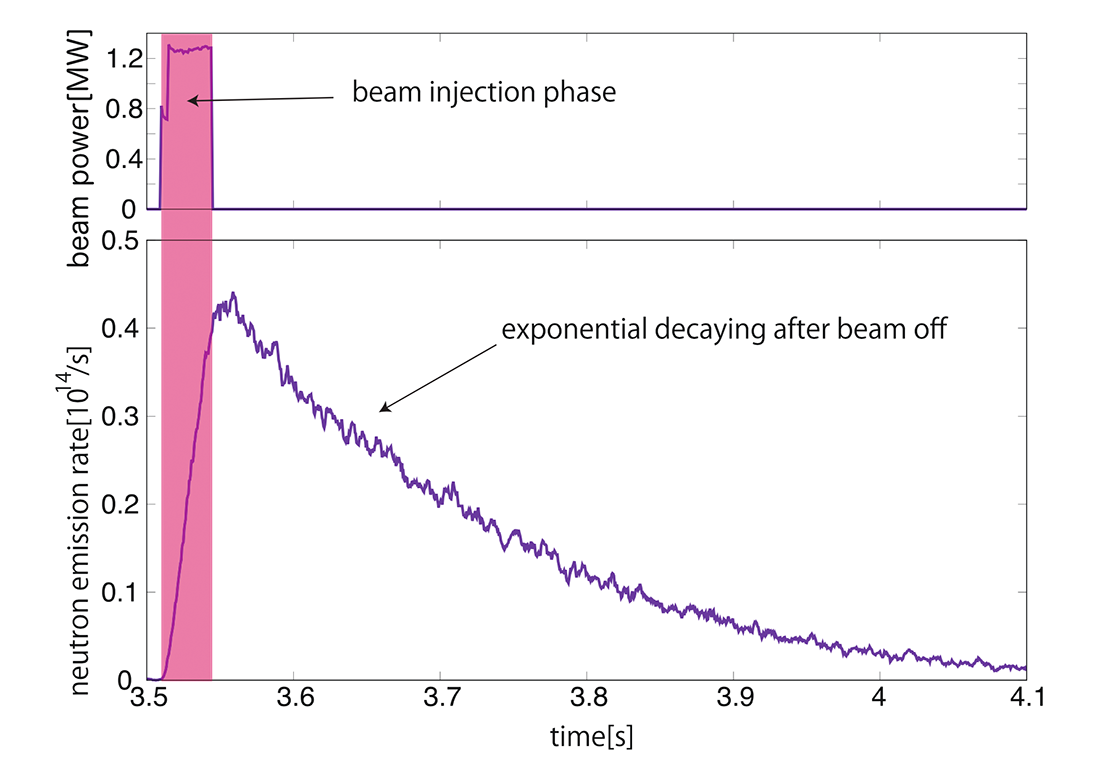
The confinement time of fast ions, which are generated by the neutral beam injection, has been estimated quantitatively in the LHD deuterium experiment by using neutron measurement and the integrated simulation. This estimation is the first achievement in large size helical systems, to our knowledge. This research can reduce ambiguities from the plasma heating profile and can contribute to the clarification of the physics phenomena in the LHD.
A new aspect of isotope effect
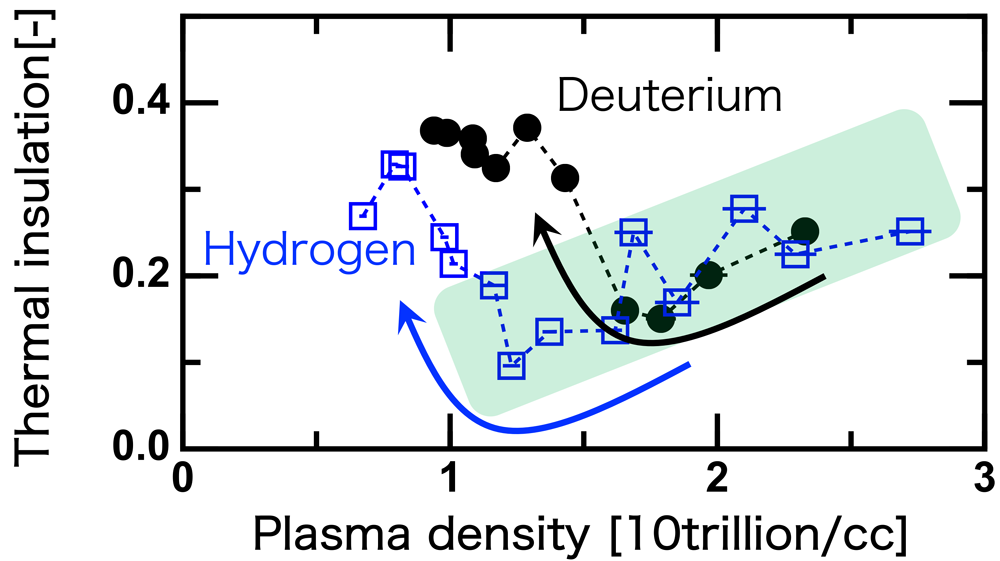
Isotope effect is a phenomenon where the plasma confinement becomes better as the mass of the fuel gas becomes heavier. Further improved confinement is expected in a deuterium-tritium plasma, which will be used in a future reactor. Background physics of the isotope effect is now being studied. Recently a new aspect of isotope effect was found in LHD.
First observed tritium distribution on plasma facing surface in stellarators
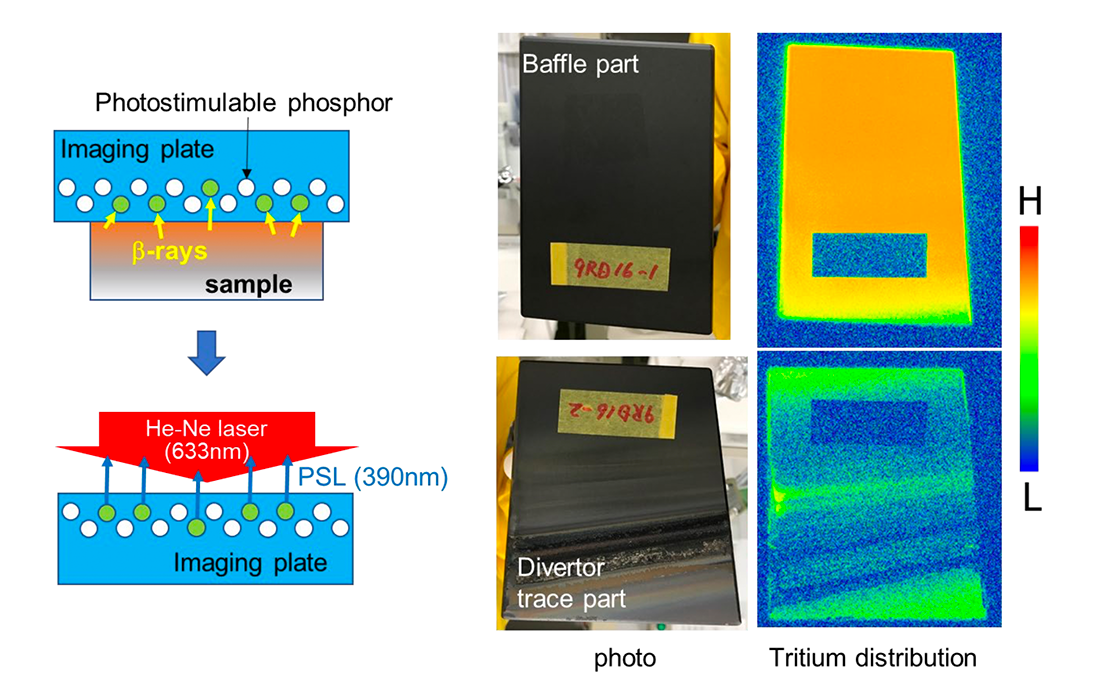
In LHD, tritium distribution on plasma facing surfaces was investigated for the first time in stellarator/heliotron devices by using the tritium imaging plate technique after the first deuterium plasma experimental campaign. In-vessel components such as divertor tiles and first wall panels and long-term material probes retrieved from the vacuum vessel were analyzed. It was revealed that tritium remained most densely in the baffle part of inner divertor tiles made of graphite.
Plasma central temperature profile collapse due to deterioration of nested magnetic tori
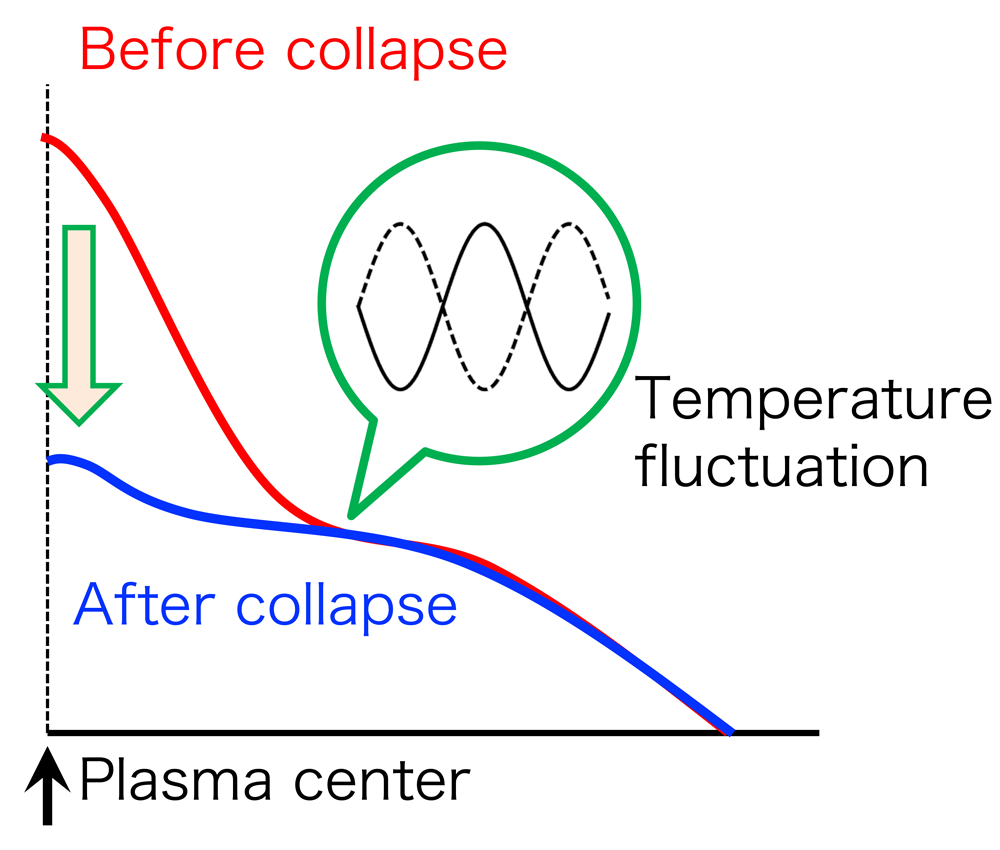
In a magnetically fusion plasma, a high temperature plasma is confined by nested magnetic tori. When a current flows in the confined plasma, a deterioration of the nested tori can occur, which leads to a plasma central temperature profile collapse. A plasma temperature fluctuation during the plasma collapse event is found that plays a leading role for the collapse. This fluctuation is a radial standing wave that has two nodes, rotating in the poloidal direction with a deceleration.
Mechanism of plasma radiation concentration at “knot”of magnetic field lines
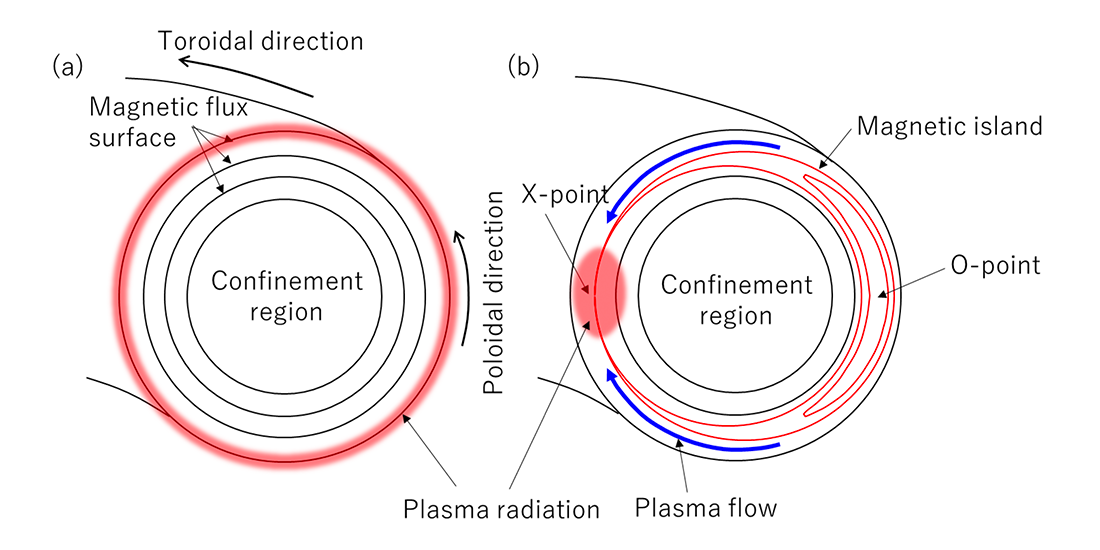
It has been reproduced in the newly developed simulation code that plasma radiation concentrates at the “knot”of the magnetic field lines, and its mechanism is recognized as the same as thermal condensation instability, which also occurs at star formation in the universe. The achievement advances the research on optimization and control of plasma radiation in future devices.
Real-time control of mm-wave propagation for highly efficient plasma heating
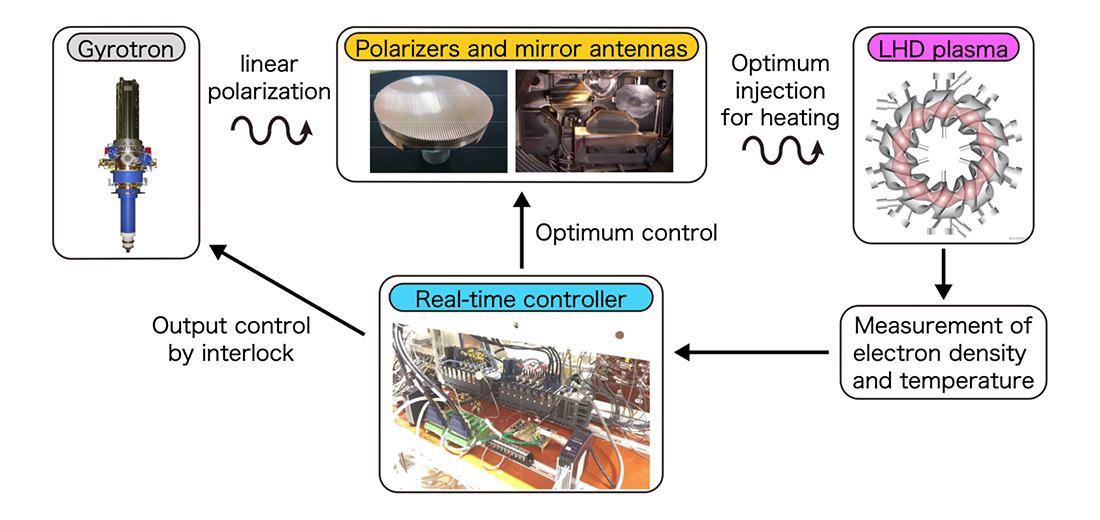
We have developed a real-time control system for the millimeter-wave injection system for electron cyclotron heating and have shown that the system can heat the plasma efficiently by optimizing the injection for the time-varying plasma in LHD. We have also succeeded in improving high electron-temperature operations and high-density operations by using this control system. This achievement will contribute to the sustainment of high-efficiency heating during high-power and long-pulse operations and improve the accuracy of transport studies to evaluate the performance of fusion plasmas.
Ion measurement by millimeter and sub-millimeter in plasma

In high-temperature plasmas, it is not easy to diagnose the state of ions and fast ions because they cannot be measured directly by a thermometer. As a non-contact measurement method to solve this problem, we are developing a Collective Thomson Scattering (CTS) diagnostic using electromagnetic scattering phenomena. In addition to the 77 GHz and 154 GHz bands, we have developed the world's first submillimeter-wave scattering measurement system in the 300 GHz band (in collaboration with Fukui Univ.).
Experimental database of emission spectra from various elements
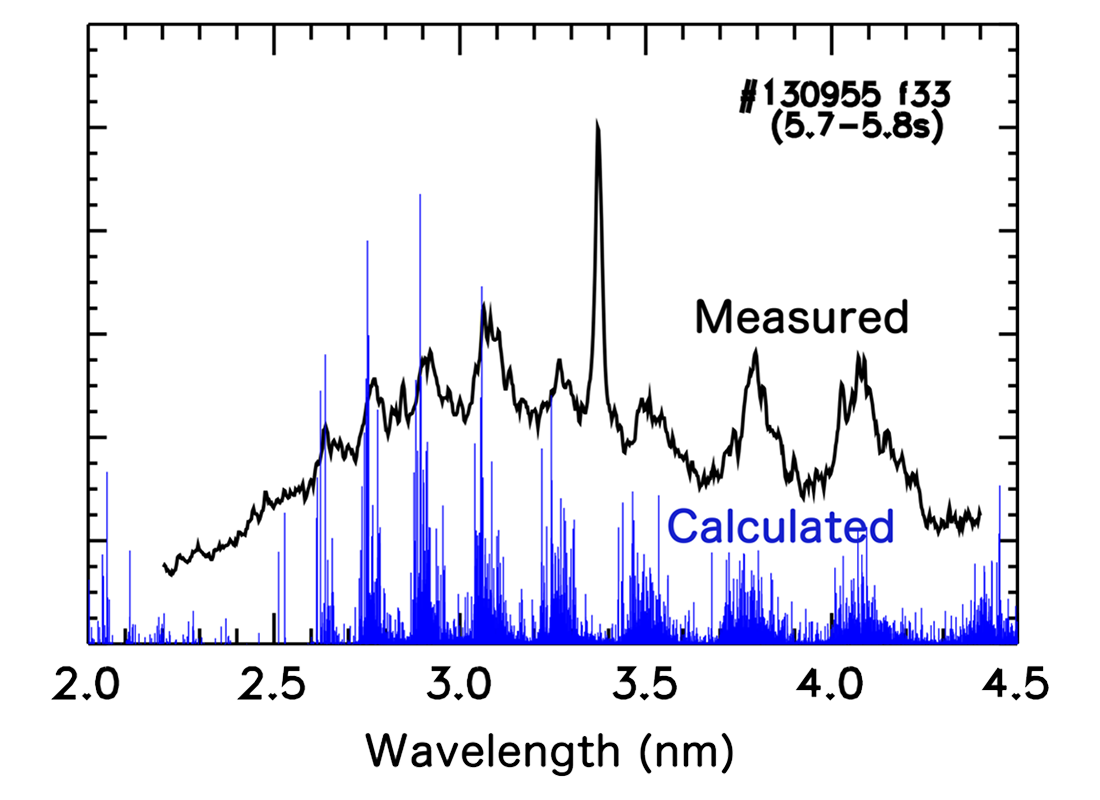
Various elements with atomic numbers from 36 to 83 have been injected into LHD plasmas to observe their emission spectra. Spectra for various atomic numbers and electron temperatures have been systematically investigated by comparisons with theoretical calculations. As a result, some spectral lines have been newly identified. The present study has contributed to the development of an experimental database, useful not only for fusion, but also for atomic physics and plasma applications.
Better confinement characteristics in deuterium plasma than in hydrogen plasma
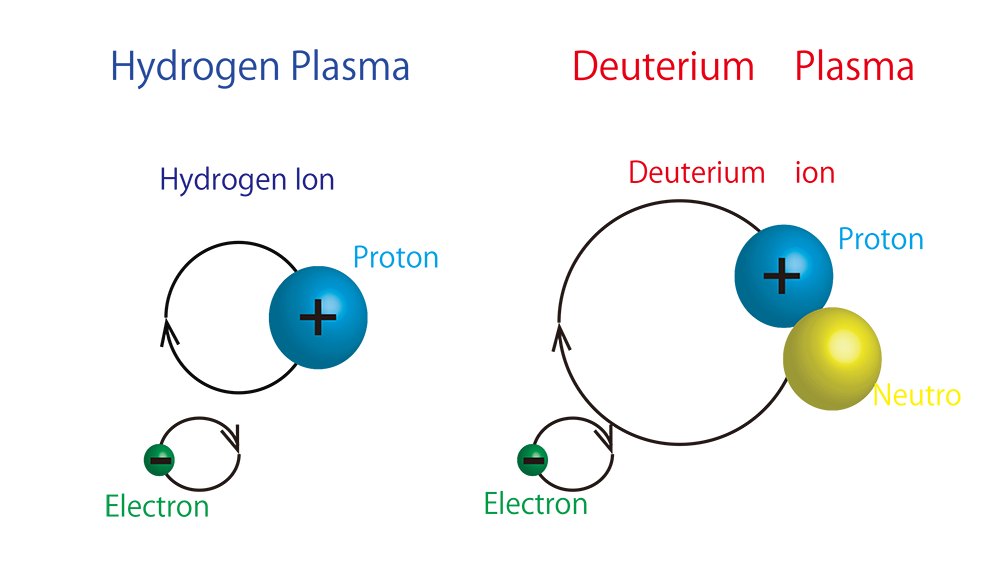
Experiments in the Large Helical Device (LHD) have shown that heavy hydrogen (deuterium) plasma with neutrons in the nucleus has better confinement than light hydrogen (hydrogen) plasma without neutrons in the nucleus, due to reduced plasma turbulence. Future nuclear fusion experiments will use deuterium and tritium with two neutrons in the nucleus, which is even heavier than deuterium. Thus, further improvement of confinement will be expected.
Explore the behavior of hydrogen isotopes using a tracer
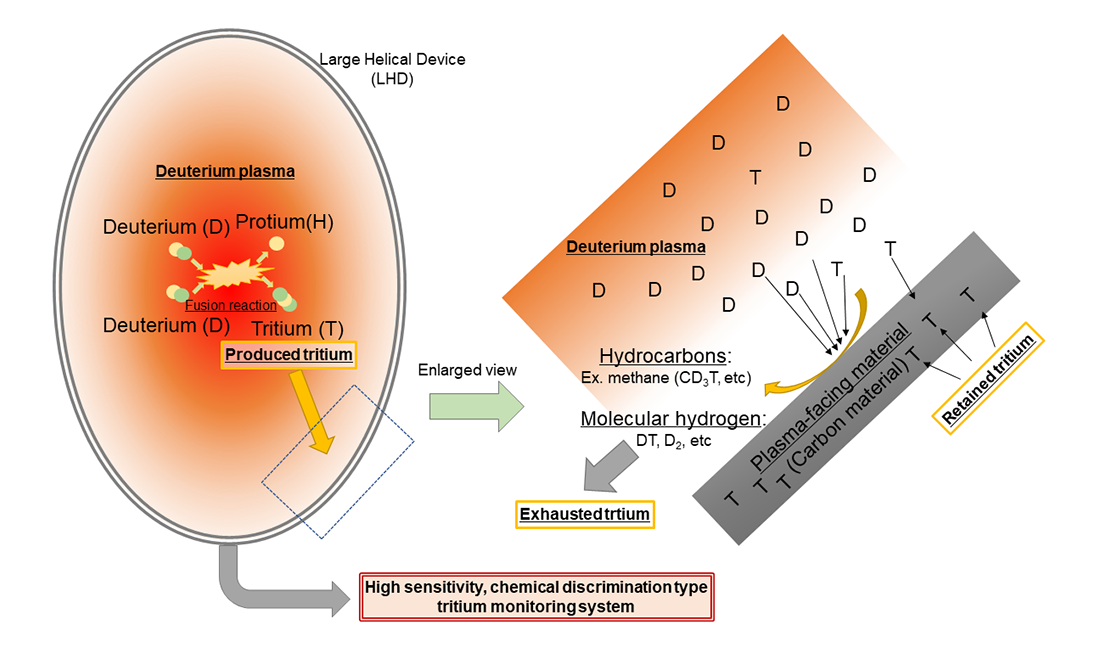
Hydrogen isotopes' behavior in a fusion test device has been clarified by use of a small amount of tritium, that was produced in deuterium plasma using the LHD as a tracer. Furthermore, it was clarified that the tritium released from the plasma-facing materials in the LHD is governed by hydrogen isotope exchange reactions and diffusion in the material. These results provide valuable knowledge on the safe handling of tritium and the fuel cycle system in future fusion reactor systems.
Turbulence permeating the inner part of a plasma magnetic island
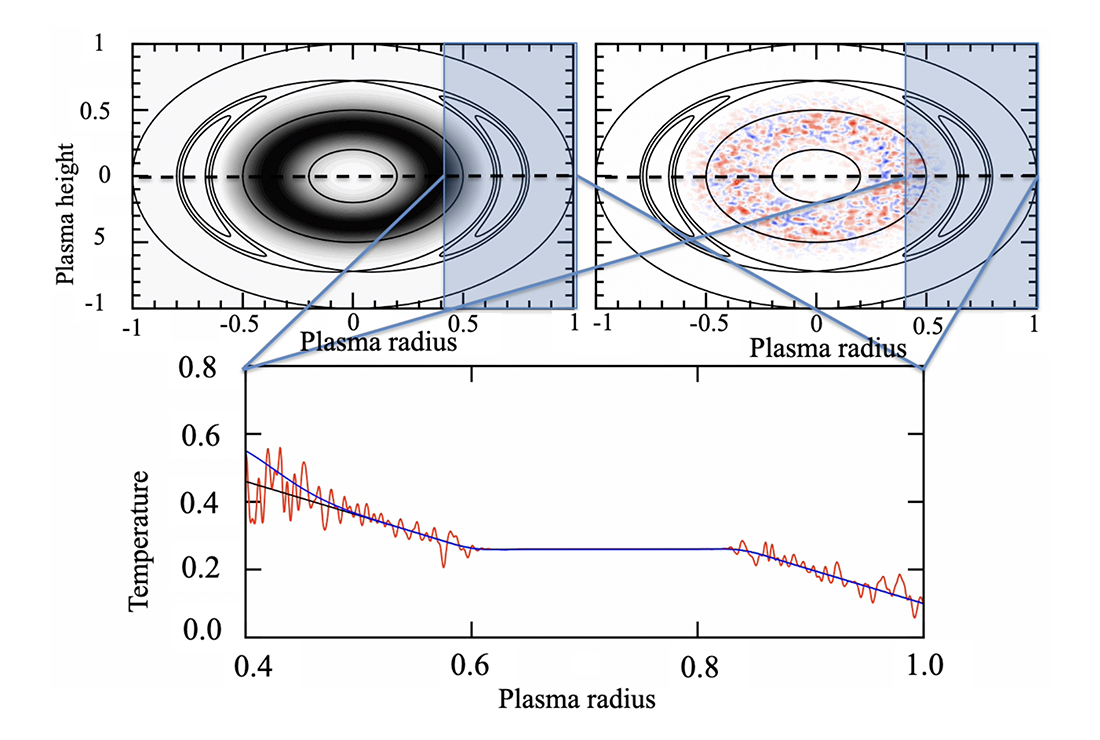
The "instantaneous heat propagation method" devised for LHD at the National Institute for Fusion Science was applied to a tokamak device (DIII-D) in the United States. Together with collaborators in the United States, we observed the phenomenon of turbulence propagating into the inner part of the magnetic island. It is well known that turbulence is generated as temperature and density increase in magnetic confinement plasmas for nuclear fusion, but this is the first experimental discovery that turbulence has propagation property.
